July 26, 2010
Santa Fe’s Mixed Dreams
They tend, thus, to be simplistic and easily understood by children. They also tend to be tricky sources for writing effective opera.
When used as the text for an opera, which sometimes can be effectively done, as in Engelbert Humperdinck’s wonderful Hansel and Gretel, it is the musical score that makes the work successful. All the blank spaces are filled in and emotion is established by the music. If this does not happen — trouble.
Trouble is what Santa Fe Opera had plenty of in mounting the never-before-staged 1978 opera, Life is a Dream, by (now retired) Amherst professor of music, composer Lewis Spratlan. The composer was on hand in Santa Fe for the opera’s rehearsal period and generously conducted symposia and gave interviews, and he let it be known that we were all in for a treat with Life is a Dream.
In a way, we were. Visually! The set is a most ingenious array of lighted barrier gates — think of the ‘arms’ that descend over a road at railroad crossings. A score of such members, fitted out with incandescent light tubes, would swing down or up from stage right and left, on visible ‘gears,’ comic strip version, providing all sorts of moods and meanings. We were in a forest so they were tree limbs; our characters were in danger so they could hide behind the barriers and be safe, we needed a ceiling, so all the light-arms ascended to the top of the stage and formed a pleasing ‘ceiling’ and source of light for the action below. If we needed a mood change, the tubes of warm light could grow cooler, or less or more intense. It was tremendously impressive and innovative, and my hat is off to scenic designer David Korins and lighting designer Japhy Weidman, as well as over-all stage director Kevin Newbury, who enjoyed nothing less than a triumph with their concept of mis-en-scène.
The evening also benefitted from Jessica Jahn’s elegant formal costumes of, I suppose, the era of the opera’s dramatic source, Pedro Calderón de la Barca’s 16th Century play, La Vida es Sueño (libretto adaptation by James Maraniss). A major stage element was a curiously Dada-esque (think Marcel Duchamps) ‘tower’ that rose from the stage floor, all round and mechanical and metallic with strong doors that contained the wild and dangerous son of King Basilio who had to be exiled to a forest, kept from society, and from endangering the King. The tall tower, on occasion, would move lower into the stage floor and become a throne, with amusing rather faux-Land of Oz lighting, and sometimes it would disappear entirely to make room for the King’s court. It was all great visual fun. Bravo!
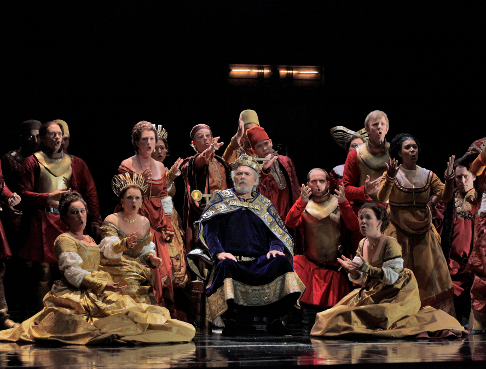 John Cheek as King Basilio and Chorus
John Cheek as King Basilio and Chorus
Meanwhile, back at the forest, the wild and crazy boy, Segismundo, is now a grown up Prince, though he does not know it. But the King, old and near death, is having second thoughts, and risks bringing the boy in from the cold to test him out as a functioning Heir (though the ambitious Duke Astolfo aspires to the throne). Alas, young Seggie does not pass the test, for he throws an unsatisfactory servant off a balcony in to the sea, and engages in further unpleasantness. Back he goes to the tower in the forest — where a few more things happen, and whether dreaming or not dreaming, the Prince vows to behave himself and be a good monarch, while all rejoice. Yep, a happy ending. Interestingly enough, vocal music is abandoned for the final climactic lines of the play/opera and the words are clearly spoken by our reformed hero, a quite clever device for they could be heard and understood.
Now we come full circle: Spratlan’s opera did not convince me for several reasons, quite aside from the simplistic tale whence it springs. First among the problems is a cerebral, if sometimes witty, score that bears no lyric material whatsoever. Virtually all vocal writing is spiky, cruelly high and low and vehement and loud, and for Prince Segismundo, especially, it requires huge reserves of power and range that no tenor since Lauritz Melchior could possess. None of the singers, even in the few potentially romantic moments between the tenor Prince and his soprano would-be girlfriends, held any emotional warmth.
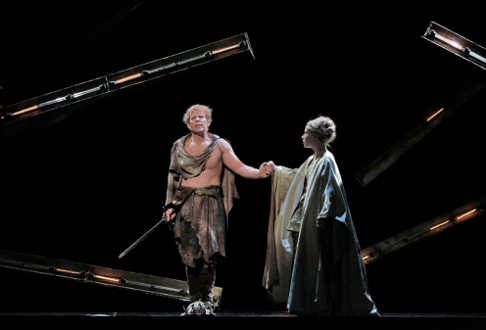 Roger Honeywell as Segismundo and Carin Gilfry as Estrella
Roger Honeywell as Segismundo and Carin Gilfry as Estrella
Most people, this one included, go to the opera to be entertained and moved, touched by emotion, which may be resolved or left unresolved, but there needs to be a lyric line and reach of voice that conjures up human feelings, in a compound of words and music, that make for lyric drama. Even the astringency of a masterwork such as Alban Berg’s Wozzeck, for all its sharp-edged atonality offers a strong core of emotion (and tonality). Mr. Spratlin’s sometimes-tonal score is marvelous in its use of wood winds, its musical tropes and schemes that sometimes even comment upon and illustrate words or situations on the stage; but it offers precious little ‘singing’ music, with a dry result that fails in the end to capture our sympathy. Now and again one can be reminded of the music for Façade of William Walton, or patches of Britten or Barber operas. If only Dream gave us a few touches of emotion as does Barber’s Knoxville, Summer 1915, we would have something to take home. But Mr. Spratlan has chosen to remain in the classroom instead.
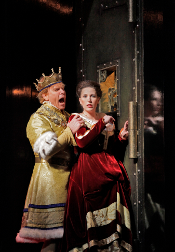 Roger Honeywell as Segismundo and Ellie Dehn as Rosaura
Roger Honeywell as Segismundo and Ellie Dehn as Rosaura
Let’s end on a positive note: In addition to providing a memorable
production for the world premiere run of Life is a Dream, Santa Fe
Opera assembled a remarkable and I might say brave cast that achieved miracles.
The complex music must be very difficult to learn (if the King had his eye on
conductor Leonard Slatkin at all times, who can blame him?), and it is surely
hard to sing. The cast, all of them, turned in remarkably accomplished
performances.
Tenor Roger Honeywell exceeded himself in the high-and-loud role of the toubled Prince, and I hope his voice benefits from a lot of rest between shows, for he is sorely taxed by the exploitative, even anti-vocal writing. James Maddalena and Craig Verm, baritones, were effective as the Prince’s mentor and rival, respectively, Verm displaying an unusually attractive vocal gift. Keith Jameson as the court’s jester Clarin had to sing, juggle, play tricks and be ever-present all evening, and he excelled, as did the beautiful soprano of Ellie Dehn. Her music, of all, allowed a few moments of dulcet tone, which she had in abundance. Bass John Cheek sounded old, noble and wobbly, which was appropriate as the weakening King, while Carin Gilfrey, Darik Knutsen, Thomas Forde and Heath Hubert were up to the demands of their supporting roles.
Musical director Leonard Slatkin, a sometimes controversial figure in operatic conducting, proved exactly right for the Spratlan score, handling it with seeming ease and expert efficiency.
James A. Van Sant © 2010
image=http://www.operatoday.com/_MG_8479.png image_description=Roger Honeywell (Segismundo) & John Cheek (King Basilio) [Photo by Ken Howard courtesy of Santa Fe Opera] product=yes product_title=Lewis Spratlan: Life is a Dream product_by=King Basilio: John Cheek; Segismundo: Roger Honeywell; Clotaldo: James Maddalena; Rosaura: Ellie Dehn. Conductor: Leonard Slatkin. Director: Kevin Newbury. Scenic Designer: David Korins. Costume Designer: Jessica Jahn. Lighting Designer: Japhy Weideman. product_id=Above: Roger Honeywell as Segismundo and John Cheek as King BasilioAll photos by Ken Howard courtesy of Santa Fe Opera
George Benjamin: Into the Little Hill, Linbury, London
This revival, at the Linbury Studio Theatre at the Royal Opera House, London, confirmed its place as a cornerstone of modern British repertoire.
It’s very loosely based on the fairy tale of the Pied Piper of Hamelin, where a conformist community rat on the piper who rids them of vermin. So he takes their children into a “little hill”. The one act opera is disturbing because it treats the story as nightmare.
Into the Little Hill operates on many different levels at once. There’s a political element.The mob violently demand the extermination of all rats, and the Minister sells his principles for votes. There’s a suggestion that the rats aren’t rats but other humans. As the Child says, they wear clothes and carry suitcases — an echo of the Holocaust? There’s social commentary, and the spectre of child abduction, all the more disturbing as the father is implicated.
Nightmares are powerful because they reveal themselves through portents, subliminally working on the subconscious. This is a work that defies classification. Quite likely Benjamin and his librettist Martin Crimp can’t explain its full portent, because it operates on the unconscious, on a subliminal level which cold logic cannot reach. That’s why it’s endlessly intriguing. Perhaps the way to get into Into the Little Hill is to let your intuition lead you.
The Minister’s Child appears to her mother in a chink of light.”Come home” says the mother. No, says the child, “Our home is under the earth. With the angel under the earth” What can that mean, no-one knows. But as the child says “The deeper we burrow, the brighter his music burns”. “Can’t you see?” cries the child. The child sees, because it doesn’t carry the millstone of received wisdom.
Into the Little Hill operates like a half-remembered dream, flotsam flowing out of the unconscious, to be processed in the listeners mind. Rats invade the town, eating grain and concrete, destroying the foundations of social order, Later, the children disappear into the bowels of the earth. “We’re burrowing” sings the child, “streams of hot metal, ribbons of magnesium, particles of light”.
A “man with no eyes, no nose, no ears” materializes in the Minister’s little daughter’s bedroom. He invades the sanctuary, mysteriously, disturbingly.. He is powerful because he can breach all defences, even the Minister’s office. “With music I can reach right in /march slaves to the factory/ or patiently unravel the clouds” Sinister as he is, he’s morally neutral — “The choice is yours” he says to the Minister.
The whole opera pivots on ideas of dissimulation, concealment, crawling into dark recesses. Nothing is safe. So the music here is cloaked in disguise. You hear something eerie, or harps or bells. Sure enough, there’s a cimbalom right in the heart of the orchestra. You hear something tense, tinny and shrill: it’s a banjo, and conventional strings being played like banjos, strings plucked high up the shaft, not bowed. Much emphasis on low-toned instruments like bass flute and bass clarinet, whose sensuous, seductive themes weave through the piece like a narcotic night-blooming flower.
Susan Bickley and Claire Booth sing. The parts aren’t defined, as such. Their voices interchange, with each other and with the “voices” in the orchestra, adding to the unsettling, dream-like effect. Bickley and Booth are the foremost interpreters of modern music in this country. They are superb. Good as the recording on Nimbus is, the singers there don’t come close to Bickley and Booth, who have lived this piece for some time. If Bickley, Booth and the London Sinfonietta record this, their version will be the one to get.
Their expertise matters, because this singing has to be approached with an almost intuitive understanding of how the vocal parts interact with the music. Both are attuned to the inner logic of the piece, so the ever-changing balance flows seamlessly. Although the text is conversational, the syntax is surreal. At several points, Booth has to “sing” at such a high pitch she’s almost inaudible. It takes physical effort. She braces herself, so as not to strain her voice beyond the limits. Humans might not hear such pitches, but rats can.
The staging, by The Opera Group, (director, John Fulljames), fits the music and the semi-narrative. The Man with no Face operates through music : the London Sinfonietta play on stage, behind a gauze curtain, vaguely visible behind the action, very much part of the concept as the orchestra is so important in this opera. The stage is dominated by a huge circular frame. “I can make rats drop from the rim of the world” says the man with no eyes. “But the world, says the minister, is round”. “The world — says the man — is the shape my music makes it.”
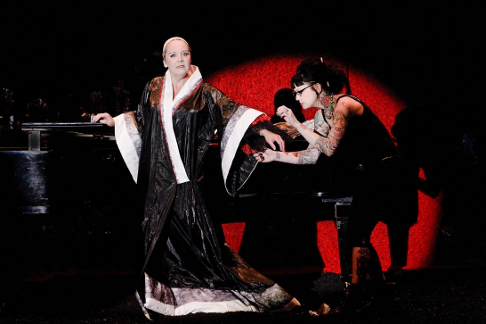 Susan Bickley [Photo by Robert Workman]
Susan Bickley [Photo by Robert Workman]
The floor is scattered with black, soft objects. When I attended the performance at Aldeburgh in June, I was close enough to touch and smell the acrid stench of rubber. It’s a striking extra dimension. By the time the production reached London the smell was almost gone. It was less oppressive, but gone too was the extra element of menace. Like music, smell can’t be seen but it operates on the mind.
Into the Little Hill was preceded by Luciano Berio’s Recital 1, It’s a tour de force, testing a singer’s full range. It’s a stream of consciousness monologue. Susan Bickley was magnificent, singing for nearly 45 minutes. Snatches of Lieder and Opera rise to the surface, receding as her mind moves on to other things. It’s tragic, for the singer is desolate, looking back on a lifetime of loneliness.
Since Berio wrote it for Cathy Berberian long after their marriage ended, it’s bittersweet, but also strangely affectionate. The interplay between singer and orchestra reflects the interplay between composer and muse. Many in-jokes, such as when Bickley sings “A composer is socially embarrassing when he tries to speak”. But that’s the whole point, for Berio speaks through the orchestration, The piece is an elaborate puzzle-game, tightly scored with intricate key changes and modulations.
Berio plays with illusion. At one stage, members of the orchestra emerge to share space with Bickley. They start to play, but the sounds are grotesquely distorted. Then they exchange instruments. What do these musicians normally play? This was the London Sinfonietta, Britain’s best contemporary music orchestra, an ensemble of virtuosi. Berio is having a laugh, for the rest of the piece is so sophisticated that bad players would be completely lost.
Bickley leans towards the audience, trying to get them to respond to her directly. I very nearly did. Berio and Berberian would have been thrilled, for part of the concept behind this piece is the relationship between illusion and reality. “Isn’t all life there?”, declaims Bickley, with a diva-like sweep of her arms.
For more information please see the Royal Opera House site here.
Anne Ozorio
Cast:
George Benjamin: Into the Little Hill (Martin Crimp: libretto)
Susan Bickley, mezzo-soprano; Claire Booth, soprano. London Sinfonietta. Frank Ollu: conductor.
Luciano Berio: Recital 1
Susan Bickley: The Singer; John Constable: The Accompanist; Nina Kate: The Dresser. The Opera Group. John Fulljames: Director. Soutra Gilmour: Set and Costume Designer. Jon Clark: Lighting.
Linbury Studio Theatre, Royal Opera House, London. 23rd July 2010
image=http://www.operatoday.com/ITLH064.png
image_description=Claire Booth (lying) and Susan Bickley (standing) [Photo by Alaistair Muir courtesy of The Royal Opera]
product=yes
product_title=George Benjamin: Into the Little Hill
product_by=The Royal Opera
product_id=Above: Claire Booth (lying) and Susan Bickley (standing) [Photo by Alaistair Muir courtesy of The Royal Opera]
July 25, 2010
Overdue Debut for Composer and Exiled Prince
By Anthony Tommasini [NY Times, 25 July 2010]
SANTA FE, N.M. — When an opera company presents a world premiere by a living composer, the opera in question usually represents the composer’s current style and approach. This was not the case on Saturday night for the absurdly overdue premiere of Lewis Spratlan’s “Life Is a Dream” here at the Santa Fe Opera.
July 22, 2010
Hoffmann Takes A Hit In Santa Fe
While gifted with some lovely melodic writing and opportunities for grand operatic singing, the story of a depressed alcoholic poet (“he never drinks water,” one line has it), and his tales of futile amorous adventure often seem over-stuffed with dialogue and redundant action. This opera is expensive and difficult to produce, and in the end bears only a negative message.
Just what Hoffmann’s message is has long been a subject of discussion. My view is that once the pretty surface of melody and musical charm is peeled back, below lies only vegetable cellulose, or nothing much. Some will argue that romantic fantasy is at the core of the piece; others find 19th century existential angst; Richard Wagner condemned it for a lack of “moral” value. I would tend to express it more in terms of the bad psychology of a neurotically disturbed man who through the confusions of alcohol and dissipation dooms his own romantic ambitions. However any of that may be, it is best to take Hoffmann as an exercise in visual pleasure and melodic delight — if there are singers and producers to make it happen, and a producer and music director to give it a light and stylish touch.
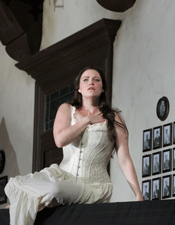 Erin Wall as Antonia
Erin Wall as Antonia
In Santa Fe Opera’s heavy-handed production, the show turned out to be
badly cast and suffocatingly over-produced. None of the singers was adequate to
the task at hand; the voices were minor or flawed. The leading tenor, Paul
Groves, the key figure in the opera, who looked and played well, seemed to have
no upper register and was often short on volume. Professional that he is,
Groves soldiered through, but he was far from the real thing, in this most
lyrical of big French tenor parts.
Canadian soprano Erin Wall assumed the neigh-impossible task of singing the three major soprano roles the opera requires, the coloratura doll of Act I, Olympia, the lyric soprano of Act II, Antonia and the soprano or mezzo part of the Venetian courtesan, Giulietta, in Act III. She did not have the light agility or highest tones required by Olympia, as Santa Fe’s management must surely have known, and thus it seems a decision was made to turn her Olympia into Gilbert & Sullivan camp — if she did not have the clean runs or pin-point high notes, well mark it up to technical difficulties in her manufacturer Spalanzani’s design. All in good fun? Ho hum. In later acts Wall fared better, and demonstrated a solid top, through high-C, as Antonia though not much tonal allure or play of color; her voice seemed to thicken under pressure, which was much of the time. As an actress Wall was never more than bland.
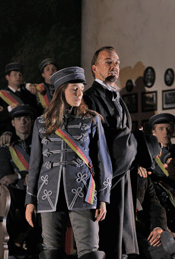 Kate Lindsey as Nicklausse, Wayne Tigges as Councilor Lindorf and Students
Kate Lindsey as Nicklausse, Wayne Tigges as Councilor Lindorf and Students
The only other singer I will address now is the bass-baritone Wayne Tigges,
a last minute replacement for an ailing colleague in the all-consuming and
vocally demanding roles of Offenbach’s four villains, who are in every
scene, with much to sing, and comprise the engine that drives the thrust of
“evil” though the show — that is quite aside from demon rum.
Tigges proved a boy sent to do a man’s job, and while earnest and
hard-working he did not have the magnetic personality or force or maturity of
voice to claim the part. He needs coaching in menace with John Malcovich.
With an inadequate tenor and bass, and soprano who was short on stage charisma and vocal interest, Offenbach’s score was not well-served. I have to say, and am sorry to do so, that Stephen Lord, music director of Opera Theatre of St. Louis, was a cut-and-dried conductor in the pit. While his orchestra played well enough, far too often Maestro Lord’s direction lacked vitality, dragged where it should have sparkled, left dead moments and, in general, lacked shape, flow and accent. Disappointing.
Now we come to Santa Fe’s stage producer, one of the most famous bad-boys of opera, Christopher Alden — who fully lived up to his reputation. I am going to keep this short — who needs a list of horrors? Alden’s direction was everywhere fussy and mannered, secondary characters moved in slow motion, slithered across the stage floor, pranced about their heads in picture frames, joined hands in a merry trio of dancing — and so on, endlessly. In the final moments of Act II, gilded high-style Second Empire opera boxes emerged from stage right holding an audience eager to applaud the diva Antonia, who had expired moments before. Ah so! We were watching a play within a play (who knew?) — and the Second Act, which Offenbach had already provided with an unnecessary anti-climax following Antonia’s death, offered yet another development as Antonia arose from the dead and took her bows. Now, let’s see, where did that plot go?
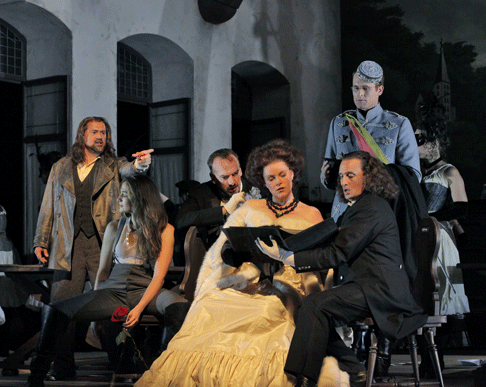 Paul Groves as Hoffmann, Kate Lindsey as Nicklausse, Wayne Tigges as Captain Dapertutto, Erin Wall as Giulietta, David Cangelosi as Pitichinaccio and Darik Knutsen as Peter Schlémil (standing)
Paul Groves as Hoffmann, Kate Lindsey as Nicklausse, Wayne Tigges as Captain Dapertutto, Erin Wall as Giulietta, David Cangelosi as Pitichinaccio and Darik Knutsen as Peter Schlémil (standing)
Costumes? Elegant, lavish with Victorian flounces, bustles and ruffles everywhere. Set? Not bad, actually: it all transpired in Luther’s Tavern, a high handsome room with five massive beams across the ceiling, a dark wood dado around the room and white plastered walls that showed off various plaques and hangings. Platforms with minimal trappings for scenes following the Tavern’s opening one (the Kleinsach scene), were brought in and out; they proved effective, and in the Venetian scene featured a massive painting in the style of Turner depicting the grand canal. It worked!
Maybe we will write more about all this later in the season; these things have a way of ripening, and several of the secondary players deserve attention for some were excellent. For now SFO’s Tales of Hoffmann is a game hardly worth the candle.
© 2010 James A. Van Sant/Santa Fe
Click here for a contrary opinion.
image=http://www.operatoday.com/_MG_0429.gif image_description=Paul Groves (Hoffmann) and Erin Wall (Giulietta) [Photo by Ken Howard courtesy of Santa Fe Opera] product=yes product_title=Jacques Offenbach: Tales of Hoffmann product_by=Stella / Olympia: Erin Wall; Antonia / Giulietta: Erin Wall; Nicklausse: Kate Lindsey; Voice of Antonia's Mother: Jill Grove; Hoffmann: Paul Groves; Spalanzani: Mark Schowalter; Lindorf / Coppelius: Wayne Tigges; Dr. Miracle / Dapertutto: Wayne Tigges; Andres / Cochenille: David Cangelosi; Frantz / Pittichinaccio: David Cangelosi; Crespel / Luther: Harold Wilson. Conductor: Stephen Lord. Director: Christopher Alden. Scenic Designer: Allen Moyer. Costume Designer: Constance Hoffman. Lighting Designer: Pat Collins. product_id=Above: Paul Groves as Hoffmann and Erin Wall as GiuliettaAll photos by Ken Howard courtesy of Santa Fe Opera
The Adventures of Pinocchio
Subsequently a few U.S. companies have piloted Flight (if you will) to stage including Opera Theater of St. Louis and Boston Lyric Opera. Other than that, Dove is a fairly unknown name here.
A viewing of one of his more recent efforts, The Adventures of Pinocchio, in its premiere run from the Opera North company in 2007, doesn’t offer evidence that Dove’s work is set to make a breakthrough here in the U.S. However, his score to Alasdair Middleton’s libretto exhibits a formidable level of professionalism and orchestral imagination (did your reviewer hear a banjo at one point?). Combined with a playful and creative staging by Martin Donovan (with sets and costumes by Francis O-Connor), the resulting work seems made for DVD — especially as captured in the crisp and detailed picture of a Blu-Ray set.
That said, an opera being “made for DVD” shouldn’t be mistaken for unreserved praise. If Dove’s music were removed or reduced to soundtrack status, this production would probably be just as charming and entertaining. Dove can create superficially appealing music, but it comes off as derivative. Bits reminiscent of Britten, Sondheim, and especially Janáček (think Cunning Little Vixen) pop up frequently, and one delightful scene for the Ape-Judge has a swaggering tune like something from Prokofiev. There’s a fine line between revealing one’s influences and using them as the foundation for one’s own work, and Dove resides in the latter part. With no keen musical identity of his own, the score can’t establish itself as central to the work’s value as a truly first-rate operatic score should.
Middleton’s libretto certainly gives Dove ample opportunity to show off the composer’s range of influences. As stated over and over again in the bonus feature interviews of composer, librettist, conductor and director, this opera more closely follows the original source material of Carlo Collodi’s novel than the more famous Walt Disney cartoon chose to do. Written serially, Collodi’s novel is a picaresque, episodic and fantastic in invention. This requires a huge cast, with several singers taking on more than one role. If any one scene fails to grasp a viewer’s attention, that viewer need not grow too impatient, for another and quite different scene will be up shortly. There is no narrative arc to speak of - Pinocchio actually “learns” his lesson about being a bad boy by the end of act one, but he has to learn it all over again, and again and again, in act two, before the curtain can finally come down. The tone throughout veers between a light-hearted playfulness that children will enjoy to a darker-hued vision that will keep an adult’s interest. The nearest point of comparison seems to be Humperdinck’s Hansel und Gretel — among that greater opera’s many virtues, it is much briefer. The Adventures of Pinocchio runs to around two and a half hours.
The title role goes to a mezzo, here in the person of Victoria Simmonds. Her pleasant voice retains a high degree of femininity, although her acting is boyish enough. O’Connor’s ingenious costume makes Simmonds into a cartoonish yet believable figure. The huge supporting cast features many amusing caricatures, with Mark White’s Cat and James Laing’s Fox, two con artist animals, making particularly strong impressions. Established baritone Jonathan Summers seems oddly strained by Gepetto’s music, and no emotional connection really happens between him and the boy of wood, sapping the ending of any resonance. Mary Palzas apparently has a substantial career as a dramatic soprano in the UK. In the key role of The Blue Fairy, she has a strong stage presence but the voice has a lot more edge than one might think a Fairy would possess.
David Parry and the Opera North orchestra do well by Dove’s eclectic score. As operatic entertainment The Adventures of Pinocchio, while overlong, offers much, but it falls short of being an authentic accomplishment. Should composer Dove move beyond his influences, he may well yet prove to a major voice.
Chris Mullins
image=http://www.operatoday.com/OABD7019D.gif image_description=Jonathan Dove: The Adventures of Pinocchio product=yes product_title=Jonathan Dove: The Adventures of Pinocchio (Libretto by Alasdair Middleton) product_by=Pinocchio: Victoria Simmonds; Geppetto: Jonathan Summers; The Blue Fairy: Mary Plazas; Cricket / Parrot: Rebecca Bottone; Puppeteer / Ape-Judge / Ringmaster: Graeme Broadbent; Lampwick: Allan Clayton; Cat: Mark Wilde; Fox / Coachman: James Laing; Pigeon / Snail: Carole Wilson. Opera North Chorus and Orchestra. David Parry, conductor. Martin Duncan, stage director. Recorded live at Sadler's Wells Theatre, London, on 29 February and 1 March 2008. product_id=Opus Arte OABD7019D [Blu-Ray DVD] price=$30.99 product_url=http://astore.amazon.com/operatoday-20/detail/B001OA071WTolomeo, New York
By George Loomis [Financial Times, 22 July 2010]
Glimmerglass Opera has a notable record of performing Handel, but its productions have sometimes emphasised cuteness over emotional substance.
Opera Star to Try Some Musical-Theater Gunplay
By Daniel J. Wakin [NY Times, 22 July 2010]
Deborah Voigt, a leading dramatic soprano known for portraying Strauss and Wagner heroines, will be packing heat next summer in the title role of “Annie Get Your Gun” at the Glimmerglass Opera Festival.
July 21, 2010
Pity the Supplicant, Beware the Gatekeeper
By Anthony Tommasini [NY Times, 21 July 2010]
Anyone who has waited in line at the post office or tried to get some officious bureaucrat to process an application will respond to the central dilemma of “La Porta Della Legge,” the Italian composer Salvatore Sciarrino’s latest opera, which had its North American premiere courtesy of the Lincoln Center Festival on Tuesday night at John Jay College.
Angela Meade's Norma at Caramoor
Though none of these ladies lived long enough to record her art, Andrew Porter, in a pre-performance talk at Caramoor, quoted several critics of the era to show that each Norma was controversial—what delighted one writer was insufficient for another.
Lilli Lehmann, the Met’s first Norma (singing it in German), made the famous comment that Norma took more out of her than all three of Wagner’s Brünnhildes—a quote misconstrued by many an impresario to imply that any natural Brünnhilde was also a Norma. (The Met tried to persuade Kirsten Flagstad to take it over from Ponselle, but she had more sense than they did.) More to the point, perhaps, is that the first Norma, Pasta, was also Bellini’s first Sonnambula, a far gentler, more sentimental sort of role—Norma must rage, but she also feels the pangs of rejected love, of deep maternal love and of women’s friendship. Wagner admired Bellini extravagantly and loved Norma—he had coached Lehmann’s mother in the role for a benefit performance he conducted. From Bellini, in part, Wagner learned the way a melody could be extended to express lingering emotional truths, one emotion drifting into others. Too, there is more than a touch of Greek tragedy to Norma, with its fierceness of feeling beneath simplicity of action, and Wagner took much of his method of dramatic construction from Greek sources.
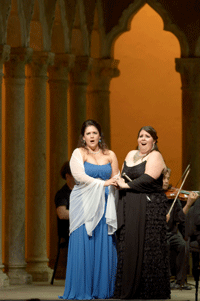 Angela Meade (Norma) and Keri Alkema (Adalgisa)
Angela Meade (Norma) and Keri Alkema (Adalgisa)
What Lehmann probably meant by her bon mot is that the vocal line in
Wagner’s Ring is part of many concurrent lines of sound, that
the voice fades out of and into the overall texture, and the orchestra will
carry the score if the voice fades. In Bellini, the singer has no place to
hide—the orchestration is delicate (a lot of pizzicato) and subservient
to the singer, who must create the statements, tensions and confrontations of
the role. If you run out of breath in Bellini, everyone in the house will know
it. For this among other reasons, perfect Normas are rare to unheard-of. In a
saner age, singers used to respect its complexities and seldom attempted it
without justification. In the entire twentieth century, by general consensus,
there were only two nearly perfect Normas, at least outside Italy: Rosa
Ponselle and Maria Callas. After Callas’s era, Joan Sutherland and
Montserrat Caballé both sang vocally sumptuous Normas that left something to be
desired in characterization. Unfortunately, they made the opera sound so easy
to sing, in their very different personal styles, that many ambitious sopranos
after them decided to tackle it, only to crash and burn. I haven’t heard
a competent Norma since Sutherland and Caballé laid down their verbena
wreaths—or I hadn’t until last Friday.
Norma is a seeress who has betrayed her gods and her country out of love for an enemy seducer. Sworn to virginity, she has borne her lover two children and repressed calls for a national uprising. When she learns he loves another priestess, her jealous rage almost inspires her to murder her children à la Medea or to command a nationwide massacre. Failing that, she could have her rival burned in front of her lover’s eyes—she considers this—or she can face the truth and her own corruption. Who is the traitor? “Son io,” she sings—unaccompanied, a moment of stark drama—“’Tis I”—adding, “Prepare the fire.” Surely Wagner was inspired by the gorgeous finale, the melody rising, falling, evolving, sweeping us along, the lovers marching through an angry throng to fiery doom, and that it was not in the back of his mind as he completed Götterdämmerung.
Angela Meade is 32. Her voice is large, beautiful and carefully trained. Her theatrical temperament is on the cautious side but her instincts are good and she has applied herself to the dramatic side of things. She made her stage debut at the Met two years ago in Verdi’s Ernani, replacing an ailing Sondra Radvanovsky, and though a bit uncertain on stage and understandably wary in early scenes, she had the goods for a thrilling final act. Last year, at Caramoor, Will Crutchfield persuaded her to undertake the title role in Rossini’s Semiramide, one of the mightier benchmarks for a dramatic coloratura. Again she made a slow start and her acting was stiff, but the entire second act (an endurance contest for all four leads) was edge-of-the-seat stuff. This year, therefore, Maestro Crutchfield resolved to showcase her in two performances of Norma. Those, we sighed, whom the Gods would destroy, they first tempt to appear as Norma.
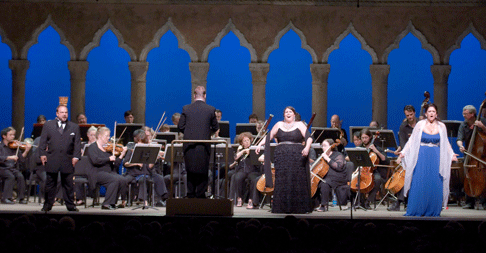 Angela Meade (Norma), Keri Alkema (Adalgisa) and Emmanuel di Villarosa (Pollione) with Will Crutchfield (conducting)
Angela Meade (Norma), Keri Alkema (Adalgisa) and Emmanuel di Villarosa (Pollione) with Will Crutchfield (conducting)
From the first performance came joyous reports; I attended the second and happily confirm them: Meade is a far more than respectable Norma. For a first attempt, this was exceptional bel canto singing and operatic acting.
Meade’s voice possesses some of Sutherland’s metallic power in her upper range, including a clarion high D she brought forth to end the great Act I trio, and she shares Sutherland’s cleanness of attack if not her unwavering breath control. Some of her highest notes and ornaments, however, are not quite so easy or even, especially in soft singing, where she sometimes resorted to head voice. She ornaments with taste and the head-voice notes are pretty, but this altered register implies she is ducking away from full-force singing. Her chest voice, in contrast, is superbly produced and of great beauty and evenness, reminding me of Tebaldi, who also sang dramatic coloratura roles early in her career. This argues that bel canto roles will not be Meade’s meat forever, but that when the highest notes fade, she could have an important career in the lirico-spinto repertory of Verdi and Puccini that currently lacks an ideal interpreter. Perhaps best of all, Meade knows how to present her dramatic ideas forcefully, jabbing with a sudden attack (as Norma, so often angry, must do) or turning reflective with a creamy legato.
In looks, though on the plump side, Meade moves well and holds herself with dignity. She evinces a dramatic as well as a musical intelligence, and these combined with the sheer loveliness of her singing to bring the house to its feet at Caramoor. We were all eager to hear her again in any number of roles. To achieve such an impression with Norma, the most unconquerable of heroines, is itself a major achievement.
Her Adalgisa, Keri Alkema, sang with a dark, sensuous contrast to Meade’s brighter sound. During their duets, the two ladies mingled their voices to sublime effect, blending colors and ornaments deliciously.
The evening’s Pollione, Emmanuel di Villarosa, announced he was performing with a cold and at first sounded that way, intonation faulty, high phrases brought down an octave to avoid cracking. He nonetheless made a sturdy, ardent figure and had warmed up by the great trio to carry his full dramatic weight. His change of heart in the final scene (a weakness of the libretto) seemed perfectly credible. Daniel Mobbs sang Norma’s father, Oroveso, impressively, and the Orchestra of St. Luke’s muddled through punishing humidity that hampered taut string playing.
For many of us, it was as genuine a Norma as we could have hoped for after so many mediocre imitations. I almost envied the younger generation who were hearing this superb score for the first time and hearing it done so well.
Sadly, traffic jams getting out of New York on a Friday evening kept me from attending the pre-opera concert of some of Wagner’s bel canto works, excerpts from Das Liebesverbot (his “Bellini” opera) and other items, sung by younger members of the Crutchfield program, but I got back to Caramoor on Sunday afternoon for a concert of Chopin and Schumann chamber music (this year marks the bicentennial of both gentlemen) with, set among the cellos like a jewel of great price, Sasha Cooke performing Schumann’s Frauenliebe und Leben.
As a rule, I am reluctant to hear yet another soprano take on this too-familiar song cycle, Schumann’s idealization of the adoration of his new bride, Clara—a loving but far more sophisticated and complex woman than is the narrator of these poems. (In this the era of gay marriage, which male singer will be the first to tackle it? Actually, Matthias Goerne has already done so.) But Sasha Cooke is more than capable of making clichés new. Her voice is an ample, generous mezzo of great size and appeal, clear and precise at “chamber” level, then effortlessly soaring to fill Caramoor’s enormous tent at the more delirious moments of the score. Her diction is exceptional, her dramatic gifts considerable—she tells the story and seems to inhabit the naïve narrator. In the music of Frauenliebe, a very simple woman expresses with her voice an emotional commitment deeper than words, and Cooke seemed to be living each layer of meaning, the notes swelling as her heart sought words.
John Yohalem
image=http://www.operatoday.com/20100710Caramoor_3442.gif image_description=Angela Meade, soprano, performs the roll of Norma in Bellini's Norma a Bel Canto at Caramoor performance in the Venetian Theater at Caramoor in Katonah New York on July 10, 2010..(photo by Gabe Palacio) product=yes product_title=Norma, Sasha Cooke at Caramoor product_by=Norma: Angela Meade; Adalgisa: Keri Alkema; Pollione: Emmanuel di Villarosa; Oroveso: Daniel Mobbs. Orchestra of St. Luke’s conducted by Will Crutchfield. Caramoor International Music Festival. Performance of July 16. Chamber Music at Caramoor, featuring Sasha Cooke, performance of July 18. product_id=Above: Angela Meade performing the role of NormaAll photos by Gabe Palacio
Cosima Wagner — The Lady of Bayreuth
Famous as the wife of the pianist-conductor Hans von Bülow, who ran off to marry the composer Richard Wagner, Cosima was the daughter of Franz Liszt and eventually the matriarch who forged her last husband’s legacy at Bayreuth. Hilmes begins his study of Cosima in the present at the annual Bayreuth Festival, which continues to attract audiences. In explaining his interest in Cosima, Hilmes identifies his sources (pp. 349-50), which are in this case voluminous and extend beyond the woman’s diaries, which have already been published in German and English translation. This is an account of an exceptional woman, who transformed conventional widowhood into a living monument to her husband’s memory and also shaped music performance internationally through her development of the Festival at Bayreuth.
Hilmes divides his work into chapters that cover Cosima’s life logically, started with her early life as the illegitimate daughter of Liszt and the French author Marie d’Agoult. He follows with an account of Cosima’s relationship with Liszt’s one-time student Hans von Bülow, which ultimately resulted in what Hilmes calls a marriage of convenience. Here Hilmes is good to show the misunderstandings that have emerged over the years, and to allow some of the documents to speak for themselves, which emerges neatly in his coverage of an episode in which Bülow encountered Cosima with Wagner on the street (pp. 58-59), a scene which has a different character depending on whom one reads. Hilmes’ approach opens the door to a fresh account of Cosima’s affair with Wagner, her divorce from Bülow, and her eventual marriage with Wagner. This portion of the book is of interest for the subtext that emerges in the section headings. Since Bülow conducted the premiere of Wagner’s opera Tristan und Isolde, the presence of that title as a subhead (p. 77) offers a useful point of reference. Likewise, other references to literature and other topics emerges as with “Human, All Too Human” (p. 112) and others. Despite the subtle references, Hilmes is nowhere arch or judgmental. He discusses the sense of guilt Cosmia felt in the way she treated Bülow sensitively. Elsewhere Hilmes shows how active a role Cosima played in Wagner’s life, and this anticipates the role she would take in shaping Bayreuth as an institution later in her own life.
The account of Cosima’s life with Wagner is lively and engaging. The freshness with which Hilmes approaches the episode invites an investigation of the sources and also a rereading of those famous diaries of Cosima in light of the perspectives that are found here. Wagner’s death is depicted with proper reverence, yet shown to be the turning point in what emerges as a kind of musical cult (p. 158), as Cosima identifies herself almost entirely with Wagner and also their home — she even uses Wahnfried as an eponym in correspondence with her daughter Daniela. This is a fascinating aspect of Cosima’s life, and it merits attention in Hilmes treatment of it. In turn, it sets the stage for the international attention that reaches Bayreuth and the role that the Festival takes in shaping German culture. The question of antisemitism emerges in this book, and its treatment is appropriately open; elsewhere Hitler’s relationship with Wagner’s music comes into play, as does the ways in which Cosima shaped the future of Bayreuth as she approached her later years. Hilmes discusses Siegfried Wagner sufficiently and also treats some of the family relationships with a deft hand. As found in other books, the Wagners are a subject that merit separate treatment, and Hilmes offers a nice balance in discussing the family matters, while always retaining the focus on Cosima as his subject.
Part of the attraction of this biography is the lively style the Stewart Spencer brings to the translation. It reads well, and flows with a natural, authorial sense of the language. Spencer seems as engaged in the subject as the author, and that is due to his own work on Wagner and his music. For these and other reasons, this biography has much to recommend for those interested in Cosima and her hand in shaping one of the important institutions in German music in the last century.
James L. Zychowicz
image=http://www.operatoday.com/Cosima_Wagner.gif
image_description=Cosima Wagner — The Lady of Bayreuth
product=yes
product_title=Cosima Wagner — The Lady of Bayreuth
product_by=By Oliver Hilmes; Translated by Stewart Spencer. Yale University Press, 2010.
product_id=ISBN: 9780300152159
price=$26.40
product_url=http://astore.amazon.com/operatoday-20/detail/0300152159
July 20, 2010
Simon Boccanegra at the Proms
But, the ovation which greeted the conclusion of this semi-staged performance of Verdi’s dark, brooding Simon Boccanegra was wholly justified — for once the reality more than lived up to the hype.
Of course, the anticipation — with Proms managers predicting queues for Arena day tickets stretching into Hyde Park — was largely for Plácido Domingo, returning to the stage just a few months after treatment for cancer, in his new guise as a baritone.
Domingo may profess that his decision to abandon his place as one of the ‘Three Tenors’ was not merely one of expediency but driven by a life-long desire to sing one of Verdi’s greatest roles, the 14th-century Genoan patriarch, Simon Boccanegra. In fact, for some time Domingo has been uncomfortable at the upper end of his tenor range; indeed, he has of late asked conductors to transpose roles downwards. But, his voice has always been characterised by a dusky, baritonal colour, and here he seemed liberated, relishing the soaring lines of the role, while elsewhere adopting an appropriately weary tone. While dramatically this captured the complexities and contrasts of this imperfect man — a ruthless, swashbuckling pirate reluctantly recruited as leader of a warring community of aristocrats and plebeians — musically it turned the role upside down: for the low, conversational phrases sounded effortful while the tense melodic peaks projected with ease. For Domingo’s baritone is a fairly light voice, lacking a genuine heft, and some might prefer a more burnished tone, particularly in the lower register where Domingo used his chest to strengthen and reinforce the sound. However, one can overlook such matters when presented with such a convincing characterisation, for Domingo truly embodied the tragic grandeur and dignity of the careworn ruler.
A flop at its premiere in 1857 — and performed here in the revised 1881 version — Simon Boccanegra remains one of Verdi’s most convoluted plots. There are several tangled strands, characters have multiple names and identities, and it would be a fruitless endeavour to attempt to unravel the complications. However, while this performance may have been only semi-staged, there are other ways of conveying the emotional meaning of the music than busy stage action and clever directorial tricks. Domingo perfectly communicated the trauma and torment of the troubled Doge; and especially impressive was the relationship he forged with Amelia, sung by Russian soprano Maria Poplavskaya, in their tender reconciliation scenes. Poplavskaya’s opening aria was pitch-perfect and serene, and although at times her soprano lacked the necessary shimmer, she successfully conveyed both the vulnerability and feistiness of Amelia, as she stands up to her domineering father.
But this performance was not just about Domingo and the superb ensemble cast was inspired by the occasion, the company and by Verdi’s music. Singing the role of Adorno, tenor Joseph Calleja almost stole the show; Calleja has a secure Verdian technique, strong in tone and projection, subtle in dramatic nuance. His Act 2 aria was electrifyingly ardent and justly inspired the loudest applause of the night. There were rumours that Ferruccio Furlanetto might be indisposed but such fears proved unfounded, and he was a typically imposing and dignified Jacopo Fiesco, his gleaming, sonorous bass easily filling the cavernous auditorium. Bass-baritone Jonathan Summers, completing the cast as Paolo, lacked tonal brightness and stamina but was dramatically effective as the Iago-lile villain, oozing menace.
Truly at home in this repertoire, Antonio Pappano commanded the orchestra of the Royal Opera House with a blend of passionate abandon and absolute control, delighting in Verdi’s instrumental tapestry and drawing musical pictures of great feeling and finesse. The ensembles, especially the Act 2 trio and the Council Chamber scene, were particularly well-shaped. Pappano’s players rose to the occasion, producing committed and superlative playing with a genuinely Verdian tinta.
Plácido Domingo has had a long, varied and illustrious career, as tenor, conductor, artistic director (at the Los Angeles Opera and the Washington National Opera), always seeking out new musical experiences and personal challenges, and this clearly continues. In 1959, aged just 18-years-old, he auditioned for the National Opera in Mexico City as a baritone, and was told by the impressed jury that he was not really a baritone and should be tackling tenor roles — so began a celebrated and distinguished career. Now things have come full circle. But one can’t help feeling that the auditioning panel was in fact correct — Domingo was and is a tenor: the overall colour and bright ‘edge’ of his voice remain those of a tenor regardless of the register. However, whether this ‘project’ is a personal indulgence or a brave experiment, it is one which is fully justified by the musical outcome. Domingo told one recent interviewer, “After Boccanegra … I will probably say Amen.” Simon Boccanegra may spend the second half of the opera melodiously dying a drawn-out death by poisoning but, fortunately, Domingo does not yet sound ready to stop.
Claire Seymour
Click here for audio clips of this performance.
image=http://www.operatoday.com/Domingo_Boccanegra_ROH_2010.gif image_description=Plácido Domingo as Simon Boccanegra [Photo by Catherine Ashmore courtesy of The Royal Opera] product=yes product_title=Giuseppe Verdi: Simon Boccanegra product_by=Simon Boccanegra: Plácido Domingo; Amelia: Marina Poplavskaya; Gabriele Adorno: Joseph Calleja; Jacopo Fiesco: Ferruccio Furlanetto; Paolo Albiani: Jonathan Summers; Pietro: Lukas Jakobski. Conductor: Antonio Pappano. Royal Opera Chorus. Orchestra of the Royal Opera House. Director: Elijah Moshinsky. Costume Designer: Peter J. Hall. Royal Albert Hall, London. Sunday 18th July 2010. product_id=Above: Plácido Domingo as Simon Boccanegra [Photo by Catherine Ashmore courtesy of The Royal Opera]Opera’s Brigadoon — OTSL’s 2010 Season of the Sublime
For just over a month, Opera Theatre of St. Louis turns the gardens on the campus of Webster University into a paradise for opera-lovers, a place where musical integrity and dramatic innovation both bloom apparently overnight.
The 2010 season opened with a production of Mozart’s Le Nozze di Figaro which played to the company’s strengths — namely, gifted young singers singing in the vernacular of their audience in an intimate setting. In James Robinson’s appealing and generally well-cast staging, the domestic dysfunction within the Almaviva estate illustrated the larger social concern of violence between the upper and lower classes. The clever new translation by Andrew Porter contained several genuinely funny moments and the singers put the text across well.
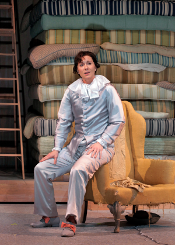 Jamie Van Eyck as Cherubino
Jamie Van Eyck as Cherubino
Heading the talented cast was Christopher Feigum as Figaro. Judging by his
successes in the past two seasons, Feigum was born to play this character. Not
only was his barber canny as well as caring, he also communicated the sense of
masculine competition between servant and master in both “Se vuol
ballare” and an intense stare-off with the Count leading into the wedding
procession.
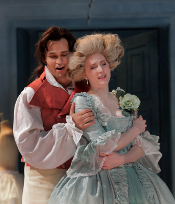 Edward Parks as the Count and Amanda Majeski as the Countess
Edward Parks as the Count and Amanda Majeski as the Countess
The counterpart of Figaro’s tension with the Count should be physical
chemistry with his bride-to-be. As her elegant and moving performance in the
role of Marie Antoinette in John Corigliano’s The Ghosts of
Versailles illustrated, Maria Kanyova is an extremely compelling singer
and actress. She is not, however, a born soubrette and it was disappointing to
see her in a role that did not showcase her talents as well as triumphs of
seasons past. Her Susanna seemed worried too often and acted as Figaro’s
magician’s assistant than his equal partner. Still, the final phrases of
“Deh, vieni” were enchanting and I look forward to hearing Kanyova
again.
In the roles of the Count and Countess Almaviva, Edward Parks and Amanda Majeski were as well-suited to their respective parts as they were well-matched as a couple. Parks imbued his Almaviva with a vanity that complemented his violent tendencies and the moment he took to compose himself after “Hai già vinta la causa” was perfection. As his wife, Majeski conveyed preternatural musical maturity with her carefully molded phrases and exquisite control over her voice. Her face was as lovely and expressive as her singing and one could almost see the memory of young Almaviva serenading his Rosina cross her face as she listened to Cherubino’s canzonetta.
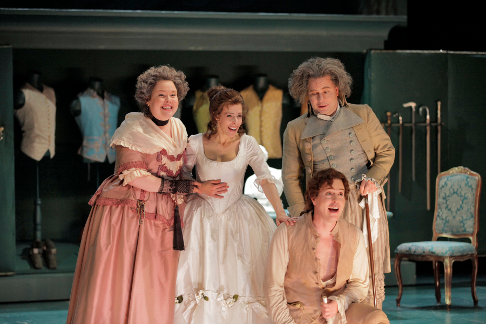 Jamie Barton as Marcellina, Maria Kanyova as Susanna, Christopher Feigum as Figaro, and Matthew Lau as Doctor Bartolo
Jamie Barton as Marcellina, Maria Kanyova as Susanna, Christopher Feigum as Figaro, and Matthew Lau as Doctor Bartolo
As the page, Jamie Van Eyck delivered said canzonetta with hormonally charged urgency. Also among the excellent supporting cast were Jamie Barton, Matthew Lau, and Matthew DiBattista. The trio took evident (and infectious) pleasure at being onstage both individually and as a group. Bradley Smoak was rather young for the role of Antonio, but his transformation from inept drunkard to the persnickety Floor Manager he played in Peter Ash’s The Golden Ticket was impressive. As his daughter, Elizabeth Zharoff showed much promise, even if her Barbarina came across as more dull-witted than young. John Matthew Myers delivered one of the evening’s best punchlines as a deadpan Don Curzio.
For the first half of the opera, a large crack in the wall and floor physically represented the discord within the household. Bruno Schwengl provided charming sets and costumes, with the exception of a singularly ugly garden for Act IV. Both lighting by Christopher Akerlind and choreography by Seán Curran were exquisite. Stephen Lord, a relatively last minute replacement for Timothy Long, presided over members of the Saint Louis Symphony Orchestra with his signature confidence and zest. The company’s Artistic Director James Robinson created several moments of amusing and innovative theater including staging during the iconic overture, a haircut given to Cherubino during “Non più andrai,” antics with a dress form, and multiple pairs of roving hands. The only moment that fell flat was the large tree that literally fell to the ground during the opera’s final moments.
As Madame Larina says in David Lloyd-Jones’ translation of Eugene Onegin, in real life there are no heroes or heroines. If that is true, then the opera is where we go to find them. As Tatyana in Kevin Newbury’s production of the Tchaikovsky opera for OTSL, Dina Kuznetsova performed with the vocal and dramatic presence of a true heroine. However, when we first encounter the character, Tatyana is a dreamy and impressionable girl. It was difficult to hear Kuznetsova’s full, womanly voice and remember she is an ingénue, especially as the mature Tatyana appeared in the opening moments of this staging, gazing upon a portrait of her younger self from the summer she met Onegin. This early revelation robbed the audience of the Pygmalion moment in Act III, when Tatyana has established herself in St. Petersburg as a woman of significant reserve and social standing.
Because the staging focused so much upon Tatyana, the role of Eugene Onegin seemed strangely underdeveloped. Little was done to answer the perturbing questions about Onegin’s nature and, as his primary characteristic appeared to be moral ambivalence, it was easy to feel ambivalent about the man himself. In the title role, Christopher Margiera’s fine singing and strong musical presence were best utilized in moments of ensemble, such as the gorgeous quartet in Act I. As Tatyana’s sister Olga, Lindsay Ammann was appropriately kittenish and her fair coloring contrasted beautifully with Kuznetsova’s dark hair. In the role of Olga’s paramour Vladimir Lensky, Sean Panikkar sang with an ardency and tenderness that left you wishing you were Olga (at least for the first act). His aria comprised of some of the most musically satisfying moments of the entire season.
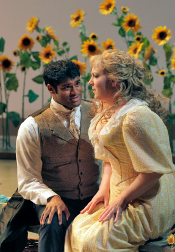 Sean Panikkar as Lensky and Lindsay Ammann as Olga
Sean Panikkar as Lensky and Lindsay Ammann as Olga
In the supporting roles of Madame Larina and Filipyevna, Gloria Parker and
Susan Shafer each performed with a winning mixture of strength and softness.
Andrew Drost’s Monsieur Triquet was a perfect complement to his turn as
Augustus Gloop in The Golden Ticket. For both roles, Drost drew on his
considerable musical finesse and physical elegance to great comic effect.
Christian Van Horn, an OTSL favorite, was a young but dignified Prince
Gremin.
As the first peasant, Jeffrey Hill led a chorus of very well-prepared, organized, and happy peasants. In particular, the girlishness of the women’s chorus was used effectively to underscore Tatyana’s brooding nature. Conductor David Agler led the cast and orchestra in a performance memorable for its musical integrity from start to finish.
The sparse wooden sets designed by Allen Moyer, although attractive, did little to illustrate the scope of the Larin estate or to differentiate between the provincial and St. Petersburg interiors. That said, the minimalist horizontality provided a perfect frame for the bleak moments of Lensky’s aria and the subsequent duel. Moreover, the transition from exterior to interior for the party scene was a little piece of theatrical magic. Martin Pakledinaz’s handsome costumes were enhanced by Tom Watson’s especially naturalistic and effective hair and makeup.
To the company’s credit, it is nearly impossible to assess two of the four festival productions without considering the other two. Each staging complements the others and the young artists (both onstage and off) benefit from this cross-pollination as much as the company’s devoted followers. By the end of the season, it is hard to imagine the gardens empty and the theater fallen silent. Then, like Brigadoon, it all is gone. Luckily for us, we don’t have to wait 200 years for the next season of enchantment.
Alison Moritz
Marriage of Figaro
Figaro, servant to Almaviva: Christopher Feigum; Susanna, Rosina's maid and Figaro's intended bride: Maria Kanyova; Doctor Bartolo: Matthew Lau; Marcellina, his housekeeper: Jamie Barton; Cherubino, page to the Countess: Jamie Van Eyck; Count Almaviva: Edward Parks; Don Basilio, music master to the household: Matthew DiBattista; Rosina, Countess Almaviva: Amanda Majeski; Antonio, gardener and uncle to Susanna: Bradley Smoak; Don Curzio, lawyer: John Matthew Myers; Barbarina, Antonio's daughter: Elizabeth Zharoff; Two peasant girls: Rebecca Nathanson and Irene Snyder. Conductor: Timothy Long, Gregory Ritchey (June 16); Stage Director: James Robinson. Set and Costume Designer: Bruno Schwengl. Choreographer: Seán Curran. Lighting Designer: Christopher Akerlind.
Eugene Onegin
Tatiana, daughter of Madame Larina: Dina Kuznetsova: Olga, her sister; Lindsay Ammann: Madame Larina; Gloria Parker; Filipyevna, the family’s old nurse: Susan Shafer; A Young Peasant: Jeffrey Hill; Vladimir Lensky, a poet: Sean Panikkar; Eugene Onegin, a friend of Lensky: Christopher Magiera; A Captain: Adrian Rosas; Monsieur Triquet, an old friend of the Larina family: Andrew Drost: Zaretsky, a retired officer: Aubrey Allicock; Guillot, Onegin’s valet: Nick Fitzer; Prince Gremin: Oren Gradus. Conductor: David Agler. Stage Director: Kevin Newbury. Set Designer: Allen Moyer. Costume Designer: Martin Pakledinaz. Choreographer: Seán Curran. Lighting Designer: Christopher Akerlind.
image=http://www.operatoday.com/11Onegin01.png image_description=Dina Kuznetsova as Tatiana and Christopher Magiera as Onegin [Photo by Ken Howard courtesy of Opera Theatre of Saint Louis] product=yes product_title=Opera’s Brigadoon — OTSL’s 2010 Season of the Sublime product_by= product_id=Above: Dina Kuznetsova as Tatiana and Christopher Magiera as OneginAll photos by Ken Howard courtesy of Opera Theatre of Saint Louis
July 19, 2010
Meistersinger at the Proms
Bryn Terfel sings his first Hans Sachs this season. Anything Terfel appears in will elicit ecstatic praise because he’s a national hero. He’s iconic, but you don’t have to be Welsh or British to adore him. His sheer presence made Prom 2 unmissable, even for those new to Wagner. A good introduction to the composer and his music.
Terfel was, of course, magnificent. Hans Sachs is an ideal vehicle for his talents. Terfel’s forceful timbre suits the “public” Hans Sachs, revered Meistersinger and shaper of public opinion. The Meistersingers represent civic pride and power: Wagnerian singing is often cursed by “park and bark”. Fortunately Terfel realizes that there’s a lot more to Sachs than public persona. Sachs is a poet after all, and a shoemaker — solitary professions, unlike being a Town Clerk. Notice how Wagner keeps Sachs in relative reserve until Act One, Scene Three.
Terfel’s finest moments thus came in moments where Sachs is on his own, in his workshop, relating to others one to one. “Was duftet doch der Flieder” let Terfel sing quietly. Declamation isn’t Sachs’s style. Terfel’s “Wahn! Wahn! Überall Wahn!” could have had more world-weary pathos, and more delicacy on words like “Der Flieder”. The Elder tree after all, is critical to the whole opera, for it means new growth, just as Walther von Stoltzing brings new ideas to the Meistersingers. Johannesnacht is Hans Sachs’s name-day, to men of his time a potent symbol. But perhaps I quibble, because the Proms reaches mass audiences. Better that Terfel inspires audiences to listen more and discover Wagner in their own time.
Terfel looks the part, physically overwhelming Christopher Purves’s Beckmesser. Terfel’s a big man, but he’s nimble on his feet when he has to be, dancing a merry jig around Purves. What a good idea to incorporate this detail from the full staging into concert performance! It’s invigorating. Sachs may be old, but he’s on the ball. That’s why he sees Walther’s potential.
This Beckmesser, though, easily stands muster against Terfel’s Sachs. Christopher Purves has a real gift for character singing. He moves about in quick, tense gestures, which amplify the acid-brightness of his singing. Beckmesser isn’t an outsider, he’s a Meistersinger and civic leader, an “insider” if there ever was one, obsessed with rules and status and keeping newcomers out. Purves’s Beckmesser is a fool, but too cheerful to be evil. His “songs” are done as amusing parody rather than grotesque. The harpist who really plays the tune of the lute make it sound quite beautiful in a quirky way.
There’s also a lot more to Die Meistersinger von Nürnberg than the nationalistic overtones shamelessly hijacked by the Third Reich. So much for their “respect” for Wagner. “Die heil’gen Deutsche Kunst” meant something completely different to Hans Sachs, living as he did during the Reformation, when Germany was being torn apart in the struggle between Lutheran (German) and Catholic (Foreign) values. That’s why Sachs was interested in German identity.
Wagner was doing a Luther, too, trying to develop a new kind of music theatre, based on German tradition, as opposed to French and Italian opera. Germany didn’t exist as nation-state until 1871 — several years after Meistersinger was written. It was a concept with many positive aspects, supported by many for its modernizing potential. This makes the rise of the Third Reich even more troubling, for it is a paradigm of society.
Prom 2 Meistersinger reflected Sachs’s concept of Germania, not Hitler’s. In the WNO production, images of German cultural heroes through the ages are projected onto the stage, reminding us that “holy German art” goes back a thousand years and has produced men like Bach and Goethe. And Art is holy because of what it is, ultimately greater than nations.
Walther von Stoltzing is the real outsider in Nuremberg, having learned singing from nature, from birds in the woods (though he read Vogelweide, showing that he, too, knows tradition).. He’s an aristocrat but significantly declassé, a wanderer like Wagner himself. Because Germany was fragmented until very recently, Germany was full of wanderers, especially after the Thirty Years and Napoleonic wars. Wanderers recur throughout the Romantic genre. Stolzing symbolizes the new.
Raymond Very’s Walther is good, though not transcendentally luminous. The Prize Song is ravishingly beautiful, but Wagner shows how it develops through experience. Walther’s first effort isn’t great, but he meets Eva,. His art is created through love. When Very sings the words “Eva im Paradies”, his voice expands warmly, expressively.
Amanda Roocroft’s voice has mellowed and rounded out well. Even if she isn’t an ingénue, her Eva is very well realized. This must be one of the crowning moments in her career, immeasurably better than when I last heard her sing Eva nearly ten years ago. She was spirited, her voice agile and bright. Die Pognerin is too big a role for a babe, which makes casting tricky. Roocroft convinces through her voice. Arguably, Eva doesn’t have to be a teen. Magdelena (Anna Burford) is older than David, but she appreciates Walther before he does.
The real discovery in this production is Andrew Tortise’s David. He’s wonderful. Tortise’s huge Act One Scene one arias are a tour de force, but Tortise sustains the inner logic through the different stages, pacing himself carefully. On top of this, he acts well, too, a fresher, more impudent Walther in the making. It’s an intelligent characterization, because under the comic surface of the role, David is a powerful figure. Wagner doesn’t write so much for the role for nothing. Like Walther, David is part of the future. Tortise has impressed me several times before in minor parts. Now, with this superb David, Tortise is the future, too.
Brindley Sherratt’s Pogner is authoritative as befits someone of his experience and stage personality. Pogner is a more troubling figure than most productions express, because Sherratt makes him sound so firm. Why is he giving his daughter away, against her will, ostensibly for the sake of art? Can people be traded for abstract ideas? Therein lies one of the dark secrets in this opera.
If art must be controlled through guilds and conformist rules, is it art? Are rules a means of suppression, or bulwarks against dissolution. Implicitly, in the background lurks the idea of a world in constant transition, where standing still means falling back. Perhaps this is why Meistersinger attracts the Far Right, though there’s a lot in it to appeal to the Far Left as well. This set of Meistersingers sang pleasantly, but only Sherratt’s Pogner hinted at more unpleasant levels.
Also very impressive was David Soar’s Nightwatchman — definitely a singer to listen out for.
The Chorus and Orchestra of Welsh National Orchestra, conducted by Lothar Koenigs, supported the performance solidly. Any performance at the Proms generates its own excitement, which creates an aura of wonder that’s hard to resist. I had a good time, though on purely musical terms this Prom wasn’t a match for other great Meistersingers, though it will be fondly remembered by English-speaking audiences. Nonetheless, the Proms aren’t about perfection. They’re there to get people stimulated, so they have a good time and go on to hear more. Beckmesser values don’t apply.
The Proms are the “Biggest music Festival in the World”, now in its 116th season. BBC Proms 2010 can be heard live, and internationally broadcast live, online and on demand. Please follow this link for more information.
Anne Ozorio
Click here to listen to audio clips of this performance.
Click here for Jim Sohre’s review of this production performed at Cardiff.
image=http://www.operatoday.com/Meistersinger_Act3.png
image_description=Act III from Die Meistersinger von Nürnberg (Ferdinand Leeke)
product=yes
product_title=Richard Wagner: Die Meistersinger von Nürnberg
product_by=Walther von Stolzing: Raymond Very; Eva: Amanda Roocroft; Magdalene: Anna Burford; David: Andrew Tortise; Hans Sachs: Bryn Terfel; Sixtus Beckmesser: Christopher Purves; Veit Pogner: Brindley Sherratt; Fritz Kothner: Simon Thorpe; Kunz Vogelgesang: Geraint Dodd; Konrad Nachtigall: David Stout; Ulrich Eisslinger: Andrew Rees; Herman Ortel: Owen Webb; Balthasar Zorn: Rhys Meirion; Augustin Moser: Stephen Rooke; Hans Folz: Arwel Huw Morgan; Hans Schwarz: Paul Hodges; Nightwatchman: David Soar. Conductor: Lothar Koenigs. Prom 2, BBC Proms 2010. Royal Albert Hall, London. 17th July 2010.
product_id=Above: Act III from Die Meistersinger von Nürnberg (Ferdinand Leeke)
July 18, 2010
Paul Groves shines in dizzying take on 'Tales'
By James M. Keller [The New Mexican, 18 July 2010]
With his new production of Jacques Offenbach's The Tales of Hoffmann, unveiled Saturday night at Santa Fe Opera, director Christopher Alden did not merely lay an egg; he laid a supersized soufflé that over the course of three and a quarter hours collapsed under its own weight.
Mahler’s 8th at Royal Albert Hall
Yet this First Night of the Proms underwhelmed to an extent that surprised, a state of affairs for which responsibility lay squarely at the door of the conductor, Jiři Bělohlávek. Whatever the strengths of the present Principal Conductor of the BBC Symphony Orchestra may be, they always seemed unlikely to lie in Mahler, and so it proved. Should a performance of this work turn out to be merely a pleasant enough experience, something has clearly gone awry. It was not even wrong-headed enough to interest in the sense that, say, Sir Georg Solti’s relentlessly hard-driven, unabashedly operatic recording might, although, almost paradoxically, in its soft-grained way, it perhaps stood closer to such a reading than to probing renditions by the likes of Jascha Horenstein, Dmitri Mitropoulos, Pierre Boulez, or Michael Gielen.
My first impression was favourable, Bělohlávek rendering Mahler’s counterpoint surprisingly clear, apparently placing the work in the tradition of the composer’s fifth symphony. Doubts soon set in, however. The first ‘slower’ section set the pace, or lack of it, for its successors. Mahler writes, following his a tempo indication, ‘Etwas (aber unmerklich) gemäßigter; immer sehr fließend.’ Instead of relative moderation and care always to flow, the music almost ground to a halt. This is not simply a matter of tempo, of course; vitality was lacking. Returning to the comparison with Solti, the solo quintet sounded too ‘operatic’, in an almost Italianate sense: Mahler for those who prefer Verdi, albeit without fire. Bělohlávek guided a clear enough course through the first movement, but the reading was very four-square, lacking in dynamism, and ultimately quite debilitating in terms of its sectional approach. The work’s structure needs to be brought out, but just as important to that is the unity of the movement and indeed of the symphony as a whole. And so, the ‘Accende…’ music, exciting in itself, did not seem to come from anywhere. Moreover, the orchestra was underpowered — indeed, surprisingly small: just sixteen first violins down to eight double basses. The strings, especially during the first part, often sounded scrawny and there were uncomfortably shrill moments from the woodwind. There was, however, some splendid duo work towards the end of the movement from the kettledrums, and the presence of the Royal Albert Hall organ (Malcolm Hicks) was throughout impressive, almost violently so at times. Choral singing was here and elsewhere very fine indeed, undoubtedly the saving grace of the performance. Applause marred the conclusion of this first part.
The opening of the second part flowed but lacked mystery — at least until the sounding of beautifully grave horns, followed by shimmering violins: a passage to savour. The brass section was resplendent, yet it was impossible to overlook the general lack of depth to string tone. Mahler’s music needs to resound as if hailing from the bowels of the earth, not as if it were a thin layer of turf lain on the surface. Matters improved, however, once the chorus re-entered, and the echo effect was unusually impressive: not easy, with these forces. Hanno Müller-Brachmann was a typically thoughtful, beautiful-toned Pater Ecstaticus, and Tomasz Konieczny more or less followed suit, if hardly de profundis, as Pater Profundus. Stephanie Blythe stood out amongst the female soloists: a mezzo, but with hints of an earth-mother contralto. Stefan Vinke was a very late substitute for the indisposed Nikolai Schukoff as Doctor Marianus. He sounded a little nervous to start with, but grew into the part, though without the virility that so impressed me when I saw him in Leipzig as Lohengrin and Parsifal. (Doubtless the size of the hall has something to do with it too, but if ever there were a Royal Albert Hall work, it must be this.) Twyla Robinson improved dramatically as Una Poenitentium, the words of her first stanza indistinct, diction much superior thereafter, and with a glorious tone in conclusion: ‘Vergönne mir, ihn zu belehren, noch blendet ihn der neue Tag!’ Choral singing was once again of a very high standard; I was especially taken by the lovely tone of the Chorus of Blessed Boys as they circled (at least in one’s imagination).
The conductor, however, continued to let the side down. Thematic links with the first part were clearly brought out, but that was one of the interpretation’s few virtues. (In any case, the connections are pretty difficult to miss!) Orchestral heft was simply lacking; for much of the time, Bělohlávek sounded as though he would have been more at home with Mendelssohn or, at a push, Schumann. The latter’s Scenes from Goethe’s Faust might have responded better to such treatment, though I fear that that work would have lacked fire too. Slow passages dragged and accelerations sounded arbitrary. There were some beautiful instrumental moments, for instance the sound of strings, harps, and harmonium as Mater Gloriosa floated into view, but again this was too much of a slow section in itself, preceded by an inordinately distended and downright sentimentalised ‘Jungfrau, rein im schönsten Sinne…’ from Doctor Marianus and chorus. It was again the latter that shone in the final Chorus Mysticus: beautifully sung, but that is not nearly enough. A performance of this work that fails to grab one by the scruff of one’s neck is barely a performance at all.
Mark Berry
Click here to listen to this performance.
image=http://www.operatoday.com/gustav_mahler.png image_description=Gustav Mahler product=yes product_title=Gustav Mahler: Symphony no.8 in E-flat major product_by=Mardi Byers (soprano, Magna Peccatrix); Twyla Robinson (soprano, Una Poenitentium); Malin Christensson (soprano, Mater Gloriosa); Stephanie Blythe (mezzo-soprano, Mulier Samaritana); Kelley O’Connor (mezzo-soprano, Maria Aegyptica); Stefan Vinke (tenor, Doctor Marianus); Hanno Müller-Brachmann (bass-baritone, Pater Ecstaticus); Tomasz Konieczny (bass, Pater Profundus). Choristers of St Paul’s Cathedral (chorus-master: Andrew Carwood); Choristers of Westminster Abbey (chorus-master: James O’Donnell); Choristers of Westminster Cathedral (chorus-master: Martin Baker); BBC Symphony Chorus (chorus-master: Stephen Jackson); Crouch End Festival Chorus (chorus-master: David Temple); Sydney Philharmonia Choirs (chorus-master: Brett Weymark); BBC Symphony Orchestra; Jiři Bělohlávek (conductor). Royal Albert Hall, London, Friday 16 July 2010. product_id=Above: Gustav MahlerDarkness Visible: Dowland and beyond
Taking the music of the enigmatic and complex figure, John Dowland — lutenist, actor, Elizabethan diplomat and suspected spy — as its starting point and impetus, the programme explored some of the many transformations of Dowland, revealing the performers’ innate understanding of the myriad ways in which words and music ‘speak’ to their audiences.
Even the most simple and ‘straightforward’ of Dowland’s own lute songs and airs are rarely without courtly sophistication and ironic conceits, and while the opening song, ‘Away with these self-loving lads’, relates a folky narrative reminiscent of pastoral comedy, the alternations between music and declamation, forward momentum and dramatic pause, reminded us of the theatrical context of many of the first performances of these songs. ‘O sweet woods’ demonstrated the creamy lyricism of Padmore’s tenor, floating and ethereal in the higher registers, firm and centred, even warmly earthy in the lower regions. A rhythmic strength and flexible control of tempo was apparent in ‘Come again, sweet love doth now invite’.
Political intrigue — shrouded in a coded language of betrayals and reprisals — underpins Dowland’s ‘If my complaints could passions move’, as a melancholy lover’s abstract address to an absent Love, masks a very specific entreaty to Elizabeth I on behalf of Dowland’s patron, the Earl of Essex, for an end to exile and a re-admittance to the court and to the Queen’s heart. Employing ornament both for exquisite melodic effect and to highlight textual nuance, Padmore’s earnest entreaty, ‘Yet thou dost hope when I despair,/ And when I hope, thou mak’st me hope in vain’, would surely have moved any regal sensibility; while an unaffected lightness added a gentle poignancy to the avowal, ‘That I do live, it I thy pow’r:/ That I desire it is thy worth’.
Britten drew upon this melody in his Lachrymae for solo viola; after much fragmentation and development, the theme is sonorously sounded in the piano bass in the final moments, establishing a destination for the unfulfilled searching of the preceding bars. Widely regarded as one of the foremost viola players in the world, Lawrence Power created an heightened intimacy which recalled the contexts of the original Elizabethan performances. With melancholy tenderness, Power conveyed the restless tension at the heart of Britten’s lament, the veiled ending astonishing for its delicate restraint.
Returning to Dowland himself, Kenny’s and Padmore’s powerful rendition of the mournful, solipsistic ‘In darkness let me dwell’, brought the first part of this concert to a close; but no focus or intensity were lost during the interval, as proceedings recommenced seamlessly, opening with Thomas Adès’ piano work, Darknesse visible, a reinterpretation of Milton’s poem, played with supreme musicianship by Andrew West. West appreciated both the architectural lucidity of Adès’ eerie composition — creating exquisite spatial forms from the contrasting registers and textures of the weaving contrapuntal lines — and its troubled beauty, placing just the right emphasis on pungent dissonances and the interplay of sound and silence, anger and restraint.
Hieronymus Kapsberger, a lutenist from Italy (despite his father’s Germanic name), was typical of those foreign composers whose music found its way into many Elizabethan collections, gathered while their owners were undertaking a Grand Tour of the continent. Performing Kapsberger’s ‘Toccata, Passacaglia and Coloscione’, Elizabeth Kenny’s controlled artistry and gentle but focused tone brought to mind Virginia Woolf: ‘Beautiful and bright it should be on the surface, feathery and evanescent, one colour melting into another like the colours on a butterfly’s wing; but beneath the fabric must be clamped together with bolts of iron’ - words which perfectly capture the combination of fragile beauty and inner strength that characterised Kenny’s playing. She relished the chromatic twists and piquancies, and the exotic ‘Turkish’ colours of the ‘Coloscione’.
Another less familiar name followed, Sigismondo d’India, whose ‘Lamento di Giasone’ is a larger-scale dramatic song, alternating recitative and aria, accompanied by the rich, expansive tones of the theorbo. Padmore and Kenny moved effortlessly between action and contemplation, enjoying the madrigalian harmonies and word painting, the delayed cadences and the contrasts between major and minor tonalities. The serene, pianissimo stillness of ‘O diletto moral, com’in un punto/ Cangiasti insieme e qualitate e stato!’ (‘O happiness of mortals, how in one brief moment/ you have changed both yoru nature and condition!’), was transformed to an uneasy swiftness, ‘Mori, morto al dolore,/ Mori, morto mio core!’ (‘Die, killed by grief,/ die my dead heart!’).
Passing, by way of a sincere reading of Henry Lawes’ setting of Philip Sidney’s ‘O sweet woods’ and ‘Tavolo: In quell gelato core’ (‘In that icy heart’), to two songs by Frescobaldi, ‘Cosi mi disprezzate?’ (‘Thus you despise me?’) and ‘Se l’aura spira’) (‘If the soft winds blows’), Padmore and Kenny demonstrated an uncanny empathy and the ability to let this music speak for itself. Giulio Caccini’s ‘Amarilli mia bella’ brought the performance to an exquisite close. Padmore’s purity of tone, elegance of phrasing and clarity of diction were astonishing: rarely, can words and music have seemed more unified in sense and sentiment; seldom does the actual performance of a song seem so integral to its meaning.
Claire Seymour
image=http://www.operatoday.com/a0000609.png image_description=The Lute Player by Orazio Gentileschi (c. 1612/1620) [National Gallery of Art] product=yes product_title=Darkness Visible: Dowland and beyond product_by=Mark Padmore, tenor; Lawrence Power, viola; Elizabeth Kenny, lute and theorbo; Andrew West, piano. Wigmore Hall, London. Wednesday, 14th July 2010. product_id=Above: The Lute Player by Orazio Gentileschi (c. 1612/1620) [National Gallery of Art]Stars Sizzle, Productions Fizzle in Paris
For me, I had to think way back to Birgit’s return to the Met in Elektra. Or Joan in the all-star Puritani. Well, my drought has been broken with Joyce DiDonato’s breath-taking performance in Paris Opera’s La Donna del Lago.
When last I experienced this tremendous artist, it was in the delightful Cenerentola in Barcelona. I never dreamed she could exceed the heat she generated on stage that day. I was wrong. For with her consummately realized Elena in La Donna del Lago we are privileged to experience that rare perfect marriage of role and artist. This day there was nothing her voice could not do, and she (and Rossini) asked it to do a great deal. Perfectly realized coloratura one moment, melting legato the next, heady leaps to the heights and spot-on plunges to the depths, fizzy fioritura, and plangent despair — Elena la, Elena qua — Ms. DiDonato makes short work of any such challenges as if she were born with this role in her throat.
The great final set piece Tanti Affeti was such stuff as legends are made of, with our diva not so much singing the aria as inhabiting it. The inevitability of every phrase, the quick-silver contrasts of emotion, the flawless musical instincts backed by one of the best techniques in the world held us utterly mesmerized. Indeed, at one momentary rest I became aware that no one seemed to be breathing. Although we were poised in our seats, mouths agape at the pyrotechnical display, no air was moving in or out lest the perfection of the moment be marred. Only the greatest artists giving the greatest performances can inspire that reaction holding an audience rapt, and Joyce DiDonato must certainly be numbered among them. Her aria effortlessly dispatched, all that was left was for us to roar our approval with such ferocity and persistence that it threatened to bring the plaster down upon our heads. Bravissima, Joyce. Oh hell, Bravississima.
It is a pleasure to note that she was not alone in her musical accomplishments for Paris fielded a starry cast of equals including one of the leading tenors of the day, Juan Diego Florez. If there is a superlative left to lavish on JDF I am not sure what it is. His familiar and acclaimed bright lyric sound is buoyed by healthy production, unerring passage work, and an ease of communication that really are the ‘total package.’ JDD and JDF are a Dream Pair in this Fach, of course, not only for their infectious joy in singing (and skill at same), but also for the youthful good looks, stage savvy and charisma that enliven even the most implausible plots and more obscure repertoire.
Colin Lee was a revelation with his authoritative performance as Rodrigo. He was an excellent choice to contrast with Mr. Florez since his fluid tenor is a bit darker, although no less flexible. Hearing the two boys swapping high C challenges and batting them out of the ballpark was quite thrilling. The ’discovery’ for me however, had to be luminous mezzo Daniela Barcellona as Malcolm Groeme. Her first aria summoned echos of the young Marilyn Horne with the rich, pulsating melismas and the ringing baritonal chest tones. All evening she went from strength to strength and her varied and well-modulated rendition earned the evening’s second biggest ovation. Bass Simón Orfila brought rolling, orotund tones and dramatic conviction to the role of Duglas. Diana Axentii lent solid support as Albina, Jason Bridges showed off a very pleasing tenor as Serano, and Philippe Talbot was fine in the small part of Bertram.
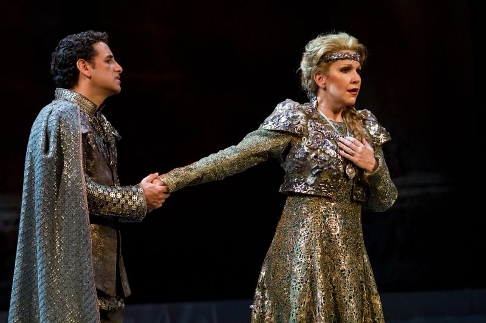 Juan Diego Florez as Giacomo V and Joyce DiDonato as Elena
Juan Diego Florez as Giacomo V and Joyce DiDonato as Elena
Would that the physical production had been up to the level of its world class singers. Ezio Frigerio is incapable of designing anything that is not handsome at the least, and here his imposing unit set consists of a three-tiered, formal stone structure that in a way seemed like it was based on the Palais Garnier itself. The semi-circular, arched and vaulted construction was fronted with steps not unlike choral risers. At rise, there was a split in the middle with a Mylar mirror panel backdrop that reflected the three crystal chandeliers, making us feel like, well, we were perhaps in the lobby. And the choristers were dressed in 18th century evening wear for the whole night. Franca Squarciapino created these and the lovely traditional period costumes worn by the principles.
As the mirror flies away, a sort of “torn” stone/steel diagonal back drop replaces it and the walls endlessly, repeatedly closed and opened, opened and closed until we were ready to scream “enough already.” In fact, there was a lone but persistent boo-er who was having none of this but at least relegated the disapproval to musical play-offs. False doors were set within the lower arches and they too kept opening and closing to allow the chorus to file on and stand in formation like a concert (see “like choral risers,” above).
The trap door center stage also wore out its welcome quickly. When first used it was a really fine star entrance for Elena who appears from the floor “lake” seated on a bench with rather effective area gobo lighting, one of designer Vinicio Cheli’s better effects. Most of the night he only gave the stage pools of light and when a singer moved out of them, oh well, they were in the dark. Meanwhile the trap fell, it rose, fell, rose, this time providing a step up for Giacomo, that time a railing, and then in an incredibly duff effect, a cheesy harp which is joined by a chandelier for a “sun” effect as the harp in the pit plucked away (beautifully I hasten to add). And that is pretty much it from the design perspective.
Lluis Pasqual is credited as the director but it is hard to know what he did really, except have the chorus remain on the sides totally unengaged in the action, and have the soloists routinely circle the stage a bit and the tromp down center one by one in a numbingly repetitive pattern. Pasqual also kept having people spook around on the second and third levels of the balconies, without adding visual interest but at least too boring to even be distracting. Montse Colomé claims the distinction of devising perhaps the dorkiest dances I ever saw for three men and one woman as warriors, flailing arms and extending legs like Xena Meets The Matrix.
But there was always the sublime music-making, to include assured orchestral playing under the experienced baton of conductor Roberto Abbado. You will likely never hear La Donna del Lago better performed. What a missed opportunity for the production to have matched the stars’ fire power.
Across town at the Bastille, pretty much the same scenario played out with the new Die Walküre: Music 10, Design 4, Direction 1. Jürgen Bäckman’s variable sets began with an Act One that had structural schizophrenia. The hut was down right, sort of. Two mostly black vertical beams flanked center stage like a second proscenium, sort of. A set of (what?) blinds, rather defined the wall of the hut… sort of. Until similar blinds in a “sort of” mountainous outline upstage served as the basis for a rippling water curtain which burbled in conjunction with Wagner. There is a pit the width of the stage at the apron and when characters stand in it they are cut off to the knees.
Director Günter Krämer has invented a plodding and overt political “message,” starting with refugees cowering center stage who get slaughtered in the prelude by armed marauders that seem to be Hunding’s Hateful Henchman (or H3). The corpses lie there for the rest of the act, occasionally prompting acknowledgment, occasionally not. At first appalled, Sieglende later traipses quiet gaily through the killing field once she is in love. H3 arrive home and in a nod to Christ feeding the multitudes, Sieglinde feeds them all out of one small soup tureen (just like the one at home on my refrigerator). Aw, heck the food is pantomimed (poorly) anyway.
Eventually the burbling backstage blinds prove to be a scrim revealing a big full moon, with (I think) apple trees in bloom. A black curtain is pulled back on the stage right support which reveals a red framed painting of The Ash Tree. Which the twins slash up with a dinner knife. Slightly later Siegmund pulls Nothung out of the red frame, an idea that Herr Direktor must have pulled out of his ass. There is no chemistry at all between S&S, or really anyone else, because clearly no connectivity was asked of them. Du bist der Lenz w as sung to the first balcony, not to the incestuous love interest.
Act II featured a huge tilted mirror that reflected stairs below, and at first this was a very intriguing look. The only other set pieces were two big banquet tables with apples. In fact, all the Valkyries are on stage playing catch with the apples (Freia’s?) while we try to locate the source of the Ho-jo-to-ho’s. Oh, there she is seated in the melee. Wotan is in a big fur coat which he doffs to put on an evening jacket. Now, men in Edwardian underwear (Nibelungen?) trudge up the stairs reflected in the mirror bearing huge letters G E R MA N J A which they place on stage. I couldn’t see the “G” from my seat and puzzled for the longest time what “Ermanta” might mean, but I digress. Wotan, when piqued, throws the GER down in a fit leaving MANJA. Subtle stuff, huh? Throughout the act a shiny silver helmet, spear, and breast plate are placed and spotlit on the down right apron, a passing reference to what the piece is actually about I guess.
Fricka enters in an odd looking costume, as though a young girl had put on a red, off the shoulder hoop skirt over a mesh black long-sleeved net of a top. The quirky but spunky costumes were devised by Falk Bauer, including a rather butch Brünnhilde in don’t-mess-with-me boots, what appeared to be upscale sweat pants and a roomy linen smock, resulting in a look akin to an on-call Medic at Dinah Shore Golf weekend. After Fricka has made her case, the curtain falls for no reason then rises to reveal the tables gone and all the apples strewn about the floor, which Number One Daughter arranges slowly in a big circle until Siegmund scatters them with a petulant kick. Remember Siegmund? Well, H3 are back marauding and they crowd around him. We never see the sword break, or Siegmund get stabbed to death, important plot points, donchyathink? As wounded Hunding crawls and keeps crawling Wotan’s Geh…Geh is meant for the Henchmen, who scatter. Fricka lurks imposingly up left. Ooh, a symbol!
Lord help us as Act III starts with “morgue” tables bearing bloodied, naked cadavers. The Valkyries as nurses give them a sponge bath, gesticulate, “pray,” and touch the victims’ heads, at which point they stand up and walk away. This gets repeated. Some lone idiot in the audience enthusiatiscally applauded every time these “corpse” extras laid down or got up. Behind all of this was a scrim with German scribblings with the H3 group got up as white-clothed firemen ready for a back-draft, and what seemed to be dog masks. They execute a Slo-Mo, Goose-Step-By-Way-Of-Thriller routine staged by Otto Pichler. Curtain down. Curtain Up. Now there are only two tables center, some bland looking institutional chairs down right and the shield-helmet-spear combo up right. Eventually the plot unwinds, Wotan storms in bearing Siegmund’s corpse in a sack which he lays on the upstage table and, after more laying on of Wagner, Brünnhilde gets put to sleep lying next to him.
The back curtain rises slowly to reveal dead (apple?) trees, a bombed landscape and red light. Lots of red light. No fire, but man was there ever red light (effective lighting design was by Diego Leetz). But there is one final tweak to go, as Brünnhilde (channeling Freddy Kruger) comes back to life, takes off the breast plate, gets under her table on the floor, and goes back to sleep in fetal position. Oops, one more tweak as a veiled, Gay Nineties clad Woman-in-Black walked in silhouette from stage left to stage right. Erda? Cosima? Victoria?
But be heartened to know the performance could hardly be faulted musically, starting with a incisively and insightfully let reading by Philippe Jordan. The orchestra responded with thrilling results and Maestro Jordan elicited chamber music-like playing of a delicacy I have rarely heard in a Wagner performance. The opera’s opening bars were at a faster clip than usual but they were certainly exciting. He paced the entire evening well, and imposed a welcome elasticity and fluidity on what can sometimes be ponderous stretches of narrative. The maestro was taken to task by some for not unleashing more power in certain climaxes but I say that this was arguably the best balance I have encountered between a Wagner pit and the singers. Mr. Jordan treated the vocalists as first among equals and it paid off beautifully. And what vocalists we had before us.
Katarina Dalayman is deservedly singing Brünnhilde all over the map. She has an uncommonly warm, round soprano with good thrust and a well-grounded, lyrical approach to the part. Her sizable, instrument nonetheless is able to convey a girlishness befitting the young Valkyrie and her stage demeanor is unforced and appealing. Thomas Johannes Mayer is a rising exponent of Wotan and he has all the stamina, buzzy tone, and snarling authority you want from the god. While his was a fine achievement and well received, I wish he might not push so hard on the the upper forte held notes, which tend to spread when they shouldn’t need to. Mr. Mayer could also bring more tenderness to the mix when deciding his daughter’s fate although with this production it was hard to tell if that was our Wotan’s fault.
As the Wälsung twins Ricarda Merbeth and Robert Dean Smith are giving JDD and JDF a run for their money for the title of Paris’ Dream Team. They were one of last season’s glories in “Die Tote Stadt.” First rate singing. Ms. Merbeth has a well-rounded lower voice, secure top notes, excellent legato and superb diction. Mr. Smith has a solid core to his substantial tenor and he knows how to use his resources to convey weight and heft without unduly pushing his pleasing tone past its limits. He too has excellent German, and a superb sense of pacing. Singly they were dreamy, together they were a Wagnerian’s answered prayer. I do have to say that Mr. Smith and Maestro Jordan have conspired to give us the longest held, steadiest Wälse I have ever heard. Yvonne Naef was a magisterial Fricka, with her imposing mezzo scoring all the musical moments asked of her. The Valkyries were well cast and while blending well, displayed good individuality. I particularly admired the talented Silvia Hablowetz as Waltraute, but girls! Girls! You were all pretty!
This jumble of a Die Walküre may not bode well for the coming Ring installments, and the longueurs of La Donna del Lago make me “long” to warn La Scala and Covent Garden, with whom it is shared and who have yet to see it. But nothing can diminish the fact that musically, we were treated to two of the disparately finest outings of the season.
James Sohre
Die Walküre
Siegmund: Robert Dean Smith; Hunding: Günther Groissböck; Sieglinde: Ricarda Merbeth; Wotan: Thomas Johannes Mayer; Brünnhilde: Katarina Dalayman; Fricka: Yvonne Naef; Gerhilde: Marjorie Owens; Ortlinde: Gertrud Wittinger; Waltraute: Silvia Hablowetz; Schwertleite: Wiebke Lehmkuhl; Helmwige: Barbara Morihien; Siegrune: Helene Ranada; Grimgerde: Nicole Piccolomini; Rossweisse: Atala Schöck. Conductor: Philippe Jordan. Director: Günter Krämer. Set Design: Jürgen Bäckman. Costume Design: Falk Bauer. Lighting Design: Diego Leetz. Staged Movement: Otto Pichler.
La Donna del Lago
Giacomo V: Juan Diego Florez; Duglas d’Angus: Simon Orfila; Rodrigo di Dhu: Colin Lee; Elena: Joyce DiDonato; Malcolm Groeme: Daniela Barcellona; Albina: Diana Axentii; Serano: Jason Bridges; Bertram: Philippe Talbot. Conductor: Roberto Abbado. Director: Lluis Pasqual. Set Design: Ezio Frigerio. Costume Design: Franca Squarciapino. Lighitng Design: Vinicio Cheli. Choreography: Montse Colomé. Chorus Master: Alessandro di Stefano.
Co-production with La Scala, Royal Opera House Covent Garden.
image=http://www.operatoday.com/Lago_Paris_01.png image_description=Juan Diego Florez as Giacomo V [Photo by Agathe Poupeney/ Opéra national de Paris] product=yes product_title=La Donna del Lago and Die Walküre at Opéra national de Paris product_by=Above: Juan Diego Florez as Giacomo VPhotos by Agathe Poupeney/ Opéra national de Paris product_id=
Tosca at Orange
No more. In recent years staging responsibilities have been given to the default directors at small opera houses in the south of France with passable to dismal results.
The Théâtre Antique is a magnificent theatrical vestige of France’s Roman past. These days it is home to this small opera festival — there are two performances each of two operas in late July and early August. The catch is that the stage is 150 feet wide and the amphitheater seats 9000 people. It is a small festival of big, very big operas.
However this summer both operas are relatively small — Puccini’s Tosca and Gounod’s Mireille. While Tosca is obvious repertory to attract an audience of 18,000 people, it is still an intimate opera even though its music is big and its story shocking. Mireille is delicate music to an innocent little love story by Provence’s poet Mistral.
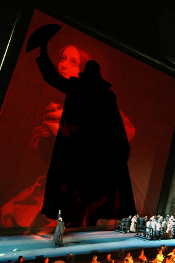 The suspicion is that messieur Raymond Duffaut, general director of the Chorégies has lost his mind. Not just because Mireille cannot possibly attract an audience of 18,000 people (famous last words), but also because he entrusted Tosca to the least able of these local stage directors, one Nadine Duffaut (yes, his wife).
The suspicion is that messieur Raymond Duffaut, general director of the Chorégies has lost his mind. Not just because Mireille cannot possibly attract an audience of 18,000 people (famous last words), but also because he entrusted Tosca to the least able of these local stage directors, one Nadine Duffaut (yes, his wife).
The best operas at Orange have been epics and spectacles, where armies clash and jealousies rage. The best operas have spectacular endings, as examples the shooting real flames of Norma’s funeral pyre or even the huge projected flames of Azucena’s funeral pyre, not to mention the transformation of the Turandot chorus into a dragon. The back wall of the Théâtre Antique’s rises 150 feet — one had high hopes for Tosca’s leap.
Mme. Duffaut chose the Mary Magdalene painted by Cavaradossi for the Attavanti chapel as her primary image. Magnified a thousand times into a huge set piece this biblical sinner oversaw all in some inexplicable irony. Though in the last few seconds the surface cracked and checkered (a black and white projection onto the painting) as Tosca walked through a slit in the bottom. So much for spectacle.
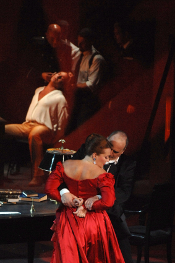 Mme. Duffaut attempted to use very nearly the entire width of the stage in her staging with the result that it took a lot of time for any of the opera’s protagonists to get from one chapel to another, from Scarpia’s desk to his chaise longue, etc. Conductor Mikko Franck did his best to accommodate these extended distances with tempi so slow that they were just plain deadly (in fact in section D alone paramedics had to remove three opera patrons on stretchers during the performance).
Mme. Duffaut attempted to use very nearly the entire width of the stage in her staging with the result that it took a lot of time for any of the opera’s protagonists to get from one chapel to another, from Scarpia’s desk to his chaise longue, etc. Conductor Mikko Franck did his best to accommodate these extended distances with tempi so slow that they were just plain deadly (in fact in section D alone paramedics had to remove three opera patrons on stretchers during the performance).
The Orchestra Philharmonique de Radio France loved this Finnish maestro, apparent from the foot stomping in the pit for every arrival and departure of Mo. Franck. Let us attribute this love to the maestro’s encouragement that they play as loud as they possibly could — an unusual pleasure for a pit (or any) orchestra. But even the orchestra was overcome by the slowness, manifest by frequent premature entrances.
Mme. Duffaut updated the opera to the Fascist era, giving costumer Katia Duflot (ubiquitous in these parts) yet another opportunity to dress singers in over-designed costumes extolling le look rather than defining le caractère. Tosca entered in a white shin length afternoon dress splashed with huge purple flowers, and simply disappeared within it. In the second act she was in a huge red satin evening gown with an exaggerated train that stood on its own dwarfing its wearer and hindering her movement.
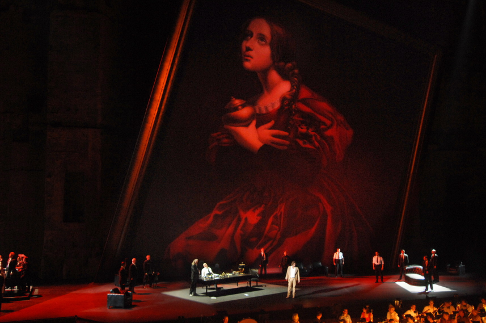
Needless to say Roberto Alagna held the stage as Cavaradossi as did Falk Struckmann as Scarpia. Alagna is a natural singer and a natural actor, Struckmann is a pro. Neither need nor probably want a stage director. Except that there are scenes between protagonists that have to be shaped. Mme. Duffaut’s abilities apparently do not extend to imposing direction on such artists.
On the other hand Catherine Naglestad, the Tosca, has had a brilliant career working with some of Germany’s most gifted directors. Perhaps she could have been coached into embodying a temperamental diva. Left on her own she could not master the quick, nervous, powerful moves that she needed to manipulate her grand red dress. Nor unfortunately does she possess an imposing vocal presence.
The Angelotti of Wojtek Smilek and Spoletta of Christophe Mortagne were well realized within these reduced circumstances. The roles of the Sacrestan and the Shepherd were embarrassments to the profession.
This Tosca fared equally poorly in the French press. Let us not forget that opera at Orange can be good, justifying the steep climb to your seat in brutal summer heat.
Michael Milenski
image=http://www.operatoday.com/Tosca_Orange_16.png
image_description=Catherine Naglestad as Tosca and Roberto Alagna as Cavaradossi [Photo by Photo Grand Angle Orange]
product=yes
product_title=Giacomo Puccini: Tosca
product_by=Floria Tosca: Catherine Naglestad; Mario Cavaradossi: Roberto Alagna; Il Barone Scarpia: Falk Struckmann; Cesare Angelotti: Wojtek Smilek; Il Sagrestano: Michel Trempont; Sciarrone: Jean-Marie Delpas; Spoletta: Christophe Mortagne; Il Carcierere: Jean-Marie Frémeau. Orchestre Philharmonique de Radio France. Choruses from Opéra-Théâtre d'Avignon et des Pays de Vaucluse, Opéra de Toulon Provence-Méditerranée and Théâtre du Capitole de Toulouse. Maîtrise des Bouches-du-Rhône. Conductor: Mikko Franck. Stage director: Nadine Duffaut. Stage designer: Emmanuelle Favre. Costumes: Katia Duflot. Lighting Jacques Chatelet.
product_id=Above: Catherine Naglestad as Tosca and Roberto Alagna as Cavaradossi
All photos by Photo Grand Angle Orange
Star Power in Zürich’s Rosenkavalier
Their faith was certainly well placed in Renée Fleming who contributed a memorable, glamorous star turn as the Marschallin. Ms. Fleming is one of the world’s most celebrated divas to be sure, and happily for all of us, one of the most recorded. With her vocal gifts so well documented (and reported), it risks cliche to refer once more to the uncommonly beautiful sheen of her timbre, the melting tone she produces throughout the range, the savvy musical instincts she brings to the score, the heft and fire power that she wields in well-calculated moderation, and the easy stage presence she commands. This is arguably one of Renée’s finest roles, and over various productions she has fine-tuned it to a fare-thee-well.
The Marschallin is a part that can negatively invite precious introspection, over-interpretation, mewing and cooing, self-victimization. Not for me the Lieder singer approach, coaxing each utterance out of some buried corner of the psyche, handling each tortured syllable like it might break, shifting moods and colors with each punctuation, by turns pleasantly audible and then. . .(not). . .blending into the orchestral (fabric). . .
On occasion in other roles, Ms. Fleming has been accused (unjustly or not) of somewhat that kind of interpretive over-reaching. Not so with her definitive Marschallin. She just sings the damn thing as exquisitely as you will ever hear. Her great monologue is magnificently realized, being supremely touching without being maudlin, winning without whining, self-examining without wallowing. In short, it was a perfectly judged portrayal by a great artist in total command of her justifiably acclaimed vocal resources. While her top voice is especially celebrated (and was thrilling in the trio), I also think her use of chest and lower middle registers has ripened and mellowed over the years to a very fine estate. And Ms. Fleming is just the right age and look for the role, seeming to grow more beautiful with each year, sleek and fabulously gowned, with a face that could launch a thousand Rolex sales. The Swiss public rewarded her with a chorus of ringing cheers.
As Octavian, Michelle Breedt sports a ringing top voice and an awesome technique. She is especially proficient at hitting a rock solid high note and then scaling it back to wondrous effect. Ms. Breedt’s lower voice gets a bit diffuse, however, and in a number of the chatty dialogue phrases, I found her hard to understand. And it has to be said that in Act I’s loosely fitted boudoir attire, she did come off as looking like a handsome middle-aged woman, rather than the strapping young man that was preferred. Ah well, suspension of disbelief is de rigeur for opera lovers, so what the hell? Her dramatic performance was detailed, enthusiastic, and focused. Eva Liebau’s perky Sophie was very winning, and her silvery, light soprano stood in good contrast to Mmes Breedt and Fleming. When Ms. Liebau pressed the voice for volume in the upper reaches, there was a tendency to go sharp and a bit edgy, but overall she acquitted herself with a fine interpretation.
Baron Ochs is always a tough sell, having to be blunt and boorish without completely turning the audience off along with Sophie. Alfred Muff draws on his ample experience with the part to pretty much pull off that balancing act. His bass voice is dark and imposing, and has a good bite in the tone that rides the orchestra with ease. He also relishes the role’s lower extremes and luxuriates in the long held tones that Strauss gave him. While he can certainly boom out the high notes, here the tone gets rather straight and dry, losing the resonance of his natural core. Muff’s bearing is more aristocratic than some who essay this role and he admirably controls the temptation to descend too far into the flummoxing lummox ham-bone mode.
Martin Gantner was an exceptionally fine Faninal never once blustering his outbursts, rather singing them securely with burnished tone. Liuba Chuchrova’s Marianne was too often hindered by placement too far upstage, and her excitable exclamations fought a bit stridently to be heard. Not so Wiebke Lehmkuhl, who put her plummy voice at the disposal of an animated and winning traversal as Annina. Rudolf Schasching was secure and polished in the less grateful role of Valzacchi. The minor roles were cast from strength with accomplished artists on the roster. Tomasz Slawinski and Volker Vogel merit special mention for their successful turns as the Notary and Innkeeper, respectively. Boiko Zvetanov nailed all the notes as the Italian Singer, with ‘nailed’ being the operative word. We can hear you, Boiko! Were the volume knob turned down a bit, Mr. Svetanov’s solid, steely tenor might make an even better impression.
I so admire the house orchestra and conductor Peter Schneider that I wish I could report more delight in their music-making. Perhaps because of the extreme heat wave that had been going on, the instrumental playing too often seemed earth-bound, languid. This greatly benefited the lush string passages which oozed like rich creme fraiche, but the heady exuberance Strauss calls for was too little in evidence. Too, Maestro Schneider did not always seem to be considerate of his singers with the massed orchestral forces allowed to challenge the soloists at best, overwhelm them at worst. On this occasion at least I did not find this fine band as well-calibrated or as joyous as is their usual standard.
The singers were also not always helped by Sven-Eric Bechtolf’s elusive, quirky direction within Rolf Glittenberg’s handsome but puzzling sets. Both Act I and III are conducted in a playing space defined by a semi-circle of light gray walls extending from down right to up left with floor to ceiling windows and slatted shutters. An ill-defined entrance point is up left and a solid wall with a fireplace opening forms stage left. It is adorned with mounted birds (ceramic? stuffed?) on little shelves. Curiously there are three denuded trees standing in this space. For the bedroom, a writing table with two chairs was draped in white down right, a matching chair was between the trees down left, and a few pillows and a comforter (white, of course) were the ‘bed’ on the floor. For Act III, a tent is erected by skeleton-costumed extras as the private dining room. The fireplace is oddly used as an entrance/exit and characters stoop over and use it as such with no explanation, the first being a ‘huh?’ moment as Octavian rushes out of the boudoir to disguise himself as a girl.
While I can’t say I understood this environment, I didn’t find it off-putting. Act II, however, while structurally realistic and pleasing enough, was set in Faninal’s basement kitchen. Beautiful cabinets with china displayed filled the upper wall, and a realistic window revealed people outside on the street above. The same gray walls (they must have gotten a discount on the paint) sided the 6 large work tables, and a big cupboard filled stage left.
Is there a less elegant place you would ‘receive’ an official visitor than in a kitchen filled with working servants? The toilet, perhaps? And what was that stuff the ladies were putting through the meat grinders? It looked like blue Play-Doh. To continue the bird motif, dead feathered fowl were strung up overhead. Given these odd design choices, there is much that was good about Mr. Bechtolf’s staging, most of all the character relationships he developed with his principals.
That said, however, there was an odd, cool cast to the beginning of this opera that should start in the after-glow of really hot sex. With the thick reading of the prelude, the curtain rose to reveal strange, guarded interactions for about the first half of the Act. It was as though the soloists had one eye on the conductor and the other on their Festival fee. Or maybe they were thinking how hot it was and this thing was going to be four and a half hours long. Everyone was behaving very professionally and singing very well and executing the well-considered staging very conscientiously but it was not until Ms. Fleming launched into her superb account of the monologue that a real dramatic fire took over. From then onwards Rosenkavalier pulsed with real theatrical life. It must be said that the director utilized the stage space with great variety of movement, and he created intimate moments of specificity and occasionally, revelation.
He also misfired a few times, like with the presentation of the rose. I had thought that was a no-fail-moment but here Sophie runs up a couple of steps and then hides in the stage left cupboard. Yes, hides. Octavian’s clumsy entrance was covered by the servants, then he can’t find Sophie and is directed to the hiding place. She cracks open the door, and one of the most sublime moments in lyric theatre is reduced to a game of pass-the-rose, with the two people who should be falling in love at first sight not even in sight of each other. Does this even sound like it could be viable? Dude, Strauss has done all the work for you! Those glorious off stage cries of Rofrano, Rofrano, the orchestral build-up, the unbearable tension under that deceptively serene music. Just stay out of the way and it works!
However, Bechtolf does make amends when they later start giggling and cooing with real spontaneity and strike some comic and romantic sparks. And he did get the three ladies (okay, one is supposed to be a guy) to be the smoochiest bunch of Straussians I have ever seen, verging on a veritable L-Word episode. The Inn Scene was quite inventive indeed, although I am not sure I liked the SNL insect costumes as well as I did the tricorn-hatted skeletons. But they were fanciful and in fact all of the luxurious period attire was well-designed by Marianne Glittenberg. The entrance of the Marschallin at opera’s end was rather perfunctory, but then the set-up to the trio that had preceded it was a beautifully realized piece of staging with the simplest of re-groupings proving highly effective. Jürgen Hoffmann’s competent lighting was at times more than that, such as the lovely back-lit effect at the end of I, when the shutters were closed one by one to black out the backdrop as the music wanes, a perfect pairing of musical and lighting effects.
At the end of the night this Der Rosenkavalier was a bit more basic Bauernbrot than succulent Sacher Torte, but as served up by one of today’s most sought after divas in tandem with a talented group of colleagues, its many staging inventions were more often than not freshly, surprisingly engaging.
James Sohre
image=http://www.operatoday.com/Fleming_Rosenkavalier.png
image_description=Renée Fleming as the Marschallin
product=yes
product_title=Richard Strauss: Der Rosenkavalier
product_by=Marschallin: Renée Fleming; Octavian: Michelle Breedt; Sophie: Eva Liebau; Baron Ochs von Lerchenau: Alfred Muff; Annina: Wiebke Lehmkuhl; Faninal: Martin Gantner; Marianne: Liuba Chuchrova; Valzacchi: Rudolf Schasching; Notary: Tomasz Slawinski; Italian Singer: Boiko Zvetanov; Innkeeper: Volker Vogel; Police Comissioner: Reinhard Mayr; Faninal’s Major-Domo: Andreas Winkler; Marschallin’s Major Domo: Martin Zysset. Conductor: Peter Schneider. Director: Sven-Eric Bechtolf. Set Design: Rolf Glittenberg. Costume Design: Marianne Glittenberg. Lighting Design: Jürgen Hoffmann.
product_id=Above: Renée Fleming as the Marschallin
July 16, 2010
The Duchess of Malfi, Great Eastern Quay, London
By Laura Battle [Financial Times, 16 July 2010]
One trend in the arts in recent years has been a growing audience for one-off projects, people who are not interested in art, theatre or music per se, but in events. Generally, they are young and hungry for new experiences, and institutions have been quick to capitalise. That tickets for The Duchess of Malfi, a new opera installation presented by English National Opera and the experimental theatre group Punchdrunk, sold out in six hours gives some measure of the demand.
July 15, 2010
Conductor Charles Mackerras dies
By Matthew Weaver [Guardian, 15 July 2010]
The Australian conductor Sir Charles Mackerras, who led the opening concert at the Sydney Opera House and was the first non-Briton to lead the Last night of the Proms, has died in London at the age of 84.
Dialogues des Carmélites from Hamburg
Nikolas Lehnhoff has devised a canny and imaginative strategy for making visual and dramatic sense of this opera, so lacking (until the end) in overt theatricality. Lehnhoff’s idea is to use a single set, unfurnished except with the absolute minimum of props, a big box with broad blue and black stripes, like gift wrapping seen from inside. The set is static, except that the black verticals can be lifted; this spare action can sometimes have real dramatic force. Both the house of Marquis de la Force and the convent are in effect prisons, whose bars sometimes make themselves conspicuous. This is appropriate to the police-state world of revolutionary France (and to Nazi Germany, where Gertrud von le Fort wrote, in 1931, the novel on which Bernanos’ play and Poulenc’s libretto are based). But there is more to the prison theme than an allusion to a political situation: to the religious, the whole earth is a kind of jail.
Lehnhoff makes good use of the physical properties of his set near the end of act 2, where the screens raise and the convent is suddenly permeable to the revolutionaries (costumed more like storm-troopers than like Jacobins); and at the end of act 1, when, at the death of the old Prioress, the convent is suddenly flooded with light, as if theological grace had itself descended. It is a beautiful moment: silent nuns stand between the bars, like the array of servants posed in Mélisande’s death chamber at the end of Debussy’s opera—the silent nuns foreshadow the arresting tableau in the execution scene, where the screens fall down, like guillotines, or even pile-drivers, as the nuns are beheaded one by one.
Still, the stage set, while good to think about, is still, too often, a bore: and its austerity is false to this non-austere opera about austerity. There are a few moments of overt gaiety, such as Sister Constance’s dancing, but also touches of wild, even surreal humor in many strange corners: in the first scene the Marquis remembers mob terror to a musical passage right out of Poulenc’s surrealist skit Les mamelles de Tirésias; and the nice commissaire at the end of act 2 gets comical music of the sort Strauss used for Aegisth in Elektra. These glints are also a manifestation, from Poulenc’s point of view, of the Holy Ghost, but are not realized in the relentless severity of this staging. T. S. Eliot’s Murder in the Cathedral, which Dialogues des Carmélites resembles in its concentration on martyrdom as an act of self-surrender rather than an act of self-aggrandisement, makes the low comedy that counterpoints the saint’s death still more striking; but I think that the director of the Poulenc opera also needs to attend to its subliminal zaniness.
Daniel Albright
image=http://www.operatoday.com/101494.png image_description=ArtHaus Musik 101494 product=yes product_title=Francis Poulenc: Dialogues des Carmélites product_by=Marquis de la Force: Wolfgang Schöne; Blanche de la Force: Alexia Voulgaridou; Le chevalier de la Force: Nikolai Schukoff; Madame de Croissy: Kathryn Harries; Madame Lidoine: Anne Schwanewilms; Mère Marie de l’Incarnation: Gabrielle Schnaut; Soeur Constance de Saint-Denis: Jana Büchner. Hamburg State Opera Chorus (chorus master: Florian Csizmadia). Hamburg Philharmonic Orchestra. Simone Young, conductor. Nikolaus Lehnhoff, stage director. Raimund Bauer, set designer. Andrea Schmidt-Futterer, costume designer. Recorded live from the Staatsoper Hamburg, 2008. product_id=ArtHaus Musik 101494 [Blu-Ray DVD] price=$39.99 product_url=http://astore.amazon.com/operatoday-20/detail/B003E113HQJuly 14, 2010
The Fairy Queen at Glyndebourne on Blu-Ray
The anonymous 1691 adaptor of A Midsummer Night’s Dream cut out some of Shakespeare’s text, and added elaborate masque scenes which Purcell set to music. Sometimes the masque scenes actually have some relation to the events in the play: the scene in which the fairies torment the drunken poet (in Act 1, added in 1692) can be understood as a sort of prehistory of the processes of absurd invention that lead Peter Quince to write the Pyramus and Thisbe skit; and a later masque can be understood as a monstrous expansion of Shakespeare’s insecticidal charm (“You spotted snakes with double tongue”). But it would be easy to listen to all two hours of Purcell’s music without understanding that it had anything to do with A Midsummer Night’s Dream.
The curtain rises, and we are in Shakespeare’s Act 1, with wigs and costumes in eighteenth-century style, as Athenian justice condemns the love of Lysander and Hermia; but soon the janitorial crew takes over—it turns out that Peter Quince and his gang are window washers, theatre electricians, sweepers, and so forth. All this runs by at spanking pace, with many delightful touches, as when the scene ends in a blackout from an electrical malfunction, and we are in the world of Purcell’s first-act masque, the scene with the drunken poet. The poet is played by the actor who plays Bottom, Desmond Barrit, a superb comedian, but a mediocre singer, and the scene is funnier when more strongly voiced. Also, it would make more than to have Peter Quince at the clavier (so to speak) in this scene, since he’s the poet of the horny-handed. As in his audio recording, Christie takes enormous rhythmic liberties with the score (“I’m drunk as I live boys, drunk”), to brilliant effect, making the poet’s song into a sea-shanty in which the whole earth is the ship on which the drunkard sways.
For the rest of the semi-opera, we are in a world of dreams shadowing into nightmares: the fairies have black raggy wings; a giant spider swaths Titania in silk and dangles her in the air. In the more cheerful masques in the later acts, there is only occasionally a sense of good-natured fun—more often there is a certain lurid glare, a frantic, slightly brittle attempt at funning, as when music celebrating the earth’s generative energies is mimed by actors in bunny suits madly copulating in many different positions. I like this effect, perfectly in tune with the play’s sour epilogue (not here performed):
Obe.: Ladies in Dreams shall have their Fortunes told;
The Young shall dream of Husbands, and the Old
Their Youthful Pleasure shall each Night repeat.
Tit.: Green-Sickness Girls, who nautiate wholesom Meat,
How they their Parents, and themselves may cheat.
Obe.: Widows, who were by former Husbands vex’d,
Shall dream how they may over-reach the next.
The only real miscalculation here, I think, is moving of the Pyramus and Thisbe skit from Act 3 to Act 5. This is, of course, where Shakespeare puts it, but The Fairy Queen’s climax is supposed be the masque set in China, a deliberately fake version of an age of old where nobody works and everybody has a good time all day. This production de-sinifies the masque, for no good reason: instead of Chinese lovers, we have Adam and an extremely flirtatious Eve. The benediction of Purcell’s incomparable chaconne shouldn’t be spread over an audience that has recently laughed at Bottom’s death scene.
Daniel Albright
image=http://www.operatoday.com/OABD7065D.png image_description=Opus Arte OABD7065D product=yes product_title=Henry Purcell: The Fairy Queen product_by=Actors — Titania: Sally Dexter; Oberon: Joseph Millson; Bottom: Desmond Barrit; Puck: Jotham Annan; Hermia: Susannah Wise; Demetrius: Oliver Le Sueur; Lysander: Oliver Kieran Jones. Singers — Juno / Mystery: Lucy Crowe; Spring / First Fairy: Claire Debono; Second Fairy: Anna Devin; Eve: Helen-Jane Howells; Night: Carolyn Sampson; Mopsa: Robert Burt; Summer: Sean Clayton; Secrecy / Adam: Ed Lyon Autumn: Adrian Ward; Phœbus: Lukas Kargl; Drunken Poet: Desmond Barrit; Winter / Sleep / Coridon / Hymen: Andrew Foster-Williams. Glyndebourne Chorus. Orchestra of the Age of Enlightenment. William Christie, conductor. Jonathan Kent, stage director. Recorded live at Glyndebourne Opera House, Lewes, East Sussex, 17 and 19 July 2009. product_id=Opus Arte OABD7065D [Blu-Ray DVD] price=$36.99 product_url=http://astore.amazon.com/operatoday-20/detail/B003H0ZGUOvon Waltershausen: Oberst Chabert
Music composed by Hermann Wolfgang von Waltershausen. Libretto adapted by composer from La Comtesse à deux maris by Honoré de Balzac.
First performance: 18th January 1912, Frankfurt am Main.
Click here for background information.
Plot Summary:
The novella opens with clerks in the Paris law office of Derville, an attorney, looking out the window and mocking a determined old man walking through the streets. Le Colonel Chabert is famous for its in medias res opening.
Colonel Chabert marries Rose Chapotel, who was living a modest life. Colonel Chabert then becomes a French cavalry officer who is held in high esteem by Napoleon Bonaparte. After being severely wounded, in the Battle of Eylau (1807), Chabert is recorded as dead and is buried with other French casualties. Though he does survive—after extricating himself from his own grave—and is nursed back to health by local peasants, it takes several years for him to recover. After he recovers, he returns to Paris and discovers his “widow” has married the wealthy Count Ferraud. She has also liquidated all of Chabert’s belongings. Seeking to regain his name and monies that were wrongly given away as inheritance, he hires Derville, an attorney, to win back his money and his honor. Derville, who also represents the Countess Ferraud, warns Chabert against accepting a settlement bribe from the Countess. In the end, Chabert walks away empty handed from his widow and spends the rest of his days at a hospice.
In Le Colonel Chabert Balzac juxtaposes two world-views: the Napoleonic value-system, founded on honour and military valour; and that of the Restoration. Chabert was not killed at the Battle of Eylau, though it was thought that he was. He struggles back to life but cannot reclaim his identity. His “widow”, who is actually his wife, and who fittingly was a prostitute in her early adult years, is now the Comtesse Ferraud, married (or so it would seem) to an important Restoration nobleman and politician. She repudiates her “former” husband (just as Ferraud, in changed political circumstances, would now be happy to repudiate her). All that matters in the modern era is social rank based upon the possession of money, especially inherited wealth.
This theme of the trenchant purity of the military way of life is something to which Balzac returns in La Rabouilleuse, but there the subject is treated quite differently.
[Plot Summary Source: Wikipedia]
NOTE:
The above link to streaming audio is a playlist in m3u format. There are three files in this playlist. If you have problems accessing all of these files, use the following links to the individual acts:
image=http://www.operatoday.com/balzac.png image_description=Honoré de Balzac audio=yes first_audio_name=Hermann Wolfgang von Waltershausen: Oberst Chabert (Colonel Chabert) first_audio_link=http://www.operatoday.com/Chabert1.m3u product=yes product_title=Hermann Wolfgang von Waltershausen: Oberst Chabert (Colonel Chabert) product_by=Count Chabert: Bo Skovhus; Count Ferraud: Raymond Very; Rosine: Manuela Uhl; Derville: Simon Pauly; Godeschal: Stephen Bronk; Boucard: Paul Kaufmann. Orchester der Deutschen Oper Berlin. Conductor: Jacques Lacombe. Live performance, 26 March 2010, Berlin. product_id=Above: Honoré de Balzac (1799 - 1850)July 13, 2010
Parsifal on Blu-Ray
But maybe he didn’t imagine a staging of his opera quite as anti-erotic as the Badener Lehrstück version found on this DVD.
This is an impressive performance. Nikolaus Lehnhoff places the opera at the burnt-out end of the road: a railroad track breaks off in the middle of nothing; the floor of the Grail castle curves up steeply at the back, until the chairs shoot out directly from the wall—it’s a castle in a different dimension, unavailable to human beings. The Grail knights look cadaverous in Act 1, and in Act 3 are dusty remnants of cadavers. Amfortas is a single big wound, wrapped in mummy bandages; Titurel is a figure from nightmare, a skeleton in chain mail, his hands mere phalanx-bones tipped with long claws. The inspiration for the whole production seems to be T. S. Eliot’s The Waste Land, a poem in which elements from the story of the Fisher King and the Grail Knight are perched uncomfortably on a ruined industrial landscape, where the river sweats oil and tar, and the taxi throbs and waits.
If Klingsor’s magic garden is magical, it is a sour sort of magic. The Kabuki Klingsor inhabits a sphere, as if he were in a subspace of his own, yet another orthogonal from the plane of reality; his castle is a magnified female pelvis-bone, a sort of Bowel of Bliss. The flower-maidens wear unadorned shifts, flowery only in that the sleeves crescendo out into great bell; Kundry herself is almost immobile, encased in a carnation-ball of petals; slowly she divests herself of her costume, unburdens herself of the director’s system of metaphor, becomes an urgent, furiously sexy presence. When the castle collapses, some bits of rubble fall on the stage, but since the stage has been basically rubble from the opera’s beginning, the presence of yet more dreck is not strongly felt.
This is Nietzsche’s dream production of Parsifal, stripped of most of the Christian elements that he loathed. When Parsifal enters in Act 3, he stalks in all in black, wearing a harness of arrows arranged in a fan, and a helmet of raven feathers, as if he were both St. Sebastian and hell’s own Papageno (that pure fool of another age). Wagner asks him to transfigure and be transfigured; but Lehnhoff offers him little of either, though he allows Parsifal to assist the death-eager in the process of dying.
The singing is good, especially Waltraud Meier’s alert, beautifully felt Kundry, and Christopher Ventris’ smartly foolish Parsifal. Thomas Hampson’s voice is a little soft-grained for Amfortas, but he is, as usual, good to hear; Matti Salminen is authoritatively irritable as Gurnemanz; Bjarni Thor Kristinsson—strong, not at all aged, with a kind of beyond-the-grave heartiness—makes more of Titurel than I would have thought possible. The Blu-Ray image is sharp—seeing the production with such clarity seems to intensify the intelligence of Lehnhoff’s extremely intelligent design.
Daniel Albright
image=http://www.operatoday.com/OABD7063D.gif image_description=Opus Arte OABD7063D product=yes product_title=Richard Wagner: Parsifal product_by=Parsifal: Christopher Ventris; Kundry: Waltraud Meier; Gurnemanz: Matti Salminen; Amfortas: Thomas Hampson; Klingsor: Tom Fox; Titurel: Bjarni Thor Kristinsson. Baden-Baden Festival Chorus. Berlin Deutsches Symphony Orchestra. Kent Nagano, conductor. Nikolaus Lehnhoff, stage director. Recorded live at the Festspielhaus, Baden-Baden, Germany, August 2004. product_id=Opus Arte OABD7063D [2 Blu-Ray DVDs] price=$45.49 product_url=http://astore.amazon.com/operatoday-20/detail/B003BFUS8KDon Giovanni, Alceste, Le Rossignol at the Aix Festival
At least based on the Don Giovanni, Alceste and Rossignol that opened within the first three days of the festival (July 1 - 21).
The logistics of opening three shows within three days are daunting. Both the Giovanni and the Alceste are new productions, alternating performances in the Festival’s signature Archevêché theater. Meanwhile Le Rossignol from Canadian Opera had been installed in the Grand Théâtre de Provence. Later in the month the Stravinsky gives way to Rameau’s Pygmalion arriving direct from the Holland and Athens Festivals. Not to mention yet another theater comes into action within the Festival’s first week — the countryside Grand St. Jean (grand meaning a kind of barn, Jean pronounced john) with a Festival commission, Oscar Strasnoy’s new chamber opera Un Retour El Regresso.
The means of the Aix Festival obviously exceed those of any ordinary opera house with its three theaters and its large number of resident ensembles (the Freiburg Baroque Orchestra, English Voices, orchestra and chorus of the Opéra de Lyon, the William Christie Ensemble, Ensemble Musicatreize plus the Aix Festival’s Académie européenne de musique) and a nearly 20 millions euros budget for its twenty-one day duration!
The cat’s whisker of North American opera these days is Canadian Robert Lepage. While we wait for his massive Ring at the Met we can be entertained by his reasonably modest production of Stravinsky’s Le Rossignol put together with a potpourri of other Stravinsky fables. Though how modest can it be to banish the orchestra to the stage by filling the pit with water (making the pit a lake, river or swimming pool is hardly a new idea, but to this point it has been metaphor rather than fact).
Nor is the Stravinsky orchestra modest. Rossignol stands with Firebird, Petruska and Rite of Spring as the Stravinsky theater works for very large orchestra (triple winds with extensive doubles plus much additional percussion, double harp). Rossignol is trapped by its too simple story and its simplistic moralism within Stravinsky’s burgeoning musical and orchestral language that simultaneously with this pale fable bursts into the primal motives and rhythms of the ballets. But in Rossignol this expanding language is relegated to portraying an exoticism of locale and nature subordinated to the tedious procedures of ritualistic storytelling.
Trapped onstage without an acoustic shell and hidden behind the seated chorus the Opera de Lyon orchestra provided a beautiful if muted account of Stravinsky’s colorful score, carefully driven by conductor Kazushi Ono. The Rossignol was Olga Peretyatko, a veteran of the original Toronto production. Aggressively sung to be sure, this nightingale’s Rossini bravura matched the aggressive orientalisme and puppetry insisted upon by the Lepage production. The spectacle style staging though succeeded only sporadically in alleviating the inherent boredom of the score.
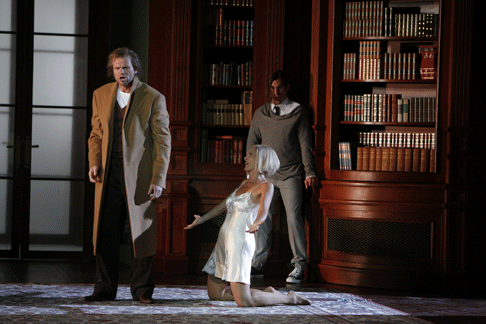 Scene from Don Giovanni
Scene from Don Giovanni
Waste deep in the pit lake Lithuanian tenor Edgaras Montvidas gave a brilliant performance as the fisherman while deftly operating his puppet double, well seconded by his other semi-submerged Russian speaking colleagues, notably the Chinese emperor of Ilya Bannik. The singing was intensely lyrical in its Russianness, implacably spurned on by Maestro Ono.
You can’t make a silk purse out of a sow’s ear, though this was an amusing if exaggerated attempt.
Much more successful were the other simple fables for ensemble voices and various combinations of instruments in smaller ensembles. These pieces not even meant to be staged were delightfully performed by broadly smiling peasant Russians. The tales were enacted by black and white shadow puppetry in various techniques with Cirque de Soleil virtuosity. The juxtaposition of Stravinsky’s early strident minimalism with the more abstract forms of puppetry was perfection.
Christoph Gluck’s opera Alceste was staged by the witty German director Christof Loy who chose to tease the audience by magnifying the severity of Gluck’s reform style. Adding to the austerity of the evening Mr. Loy allowed us no break between Acts I and II thus we sat two long hours before regrouping (most of us) to witness Alceste’s reprieve from death only to learn that we all are going to die anyway.
Mr. Loy reduced Euripides tragedy from its larger political terms to a purely family tragedy (the untimely death of a father). Euripides’ Thessalians became modern children holding toys. A black suited, clerically collared priest to Apollo physically abused one of these children (arousing an angry protest from someone in the audience on July 6). Jupiter was an expansive uncle who came to visit.
Yes, there was dance. The chorus of children moved to carefully designed stage positions during the dance interludes. The set was a white room, its side wall a huge window, its angled back wall broken by a small proscenium type opening that usually revealed mom and dad’s bedroom (this was a carefully created child’s world).
Yes, there was spectacle -- this opening became an attic where mementos of past lives are cast off and forgotten, like Hades, the netherworld. This vision became alive as these colorful spirits of the past flowed out onto the stage to taunt Admete and Alceste. The finale of the opera was in fact quite magnificent spectacle — the doors of this stage within a stage opened on an absolute black void. Nothing. It was a vast vision of death, a concept and a reality. Huge. Everyone wound up entering.
Alceste was Mr. Loy’s metaphor of human destiny that even children understand.
Gluck’s reform operas give the chorus and orchestra huge dramatic responsibilities. Mr. Loy’s staging exacerbated these responsibilities, and miraculously they were met by English Voices, a chorus of 32 young singers who sang with magnificent Baroque gusto and seemed quite at home acting like six-year-olds, and by the Freiburg Baroque Orchestra conducted by Ivor Bolton. Mo. Bolton elicited bold sounds from this prestigious group, its bassoons and double basses especially called upon to instill shock and awe.
Alas, just knowing Maria Callas sang Alceste places any other soprano who attempts the role in impossible competition. The Aix Festival entrusted the role to French early music soprano Veronique Gens who exuded artistry far more than passion. Canadian tenor Joseph Kaiser in fact melded his artistry into powerful Gluckian humanity, notable indeed when he reacted to Alceste’s sacrificial intentions to save his life.
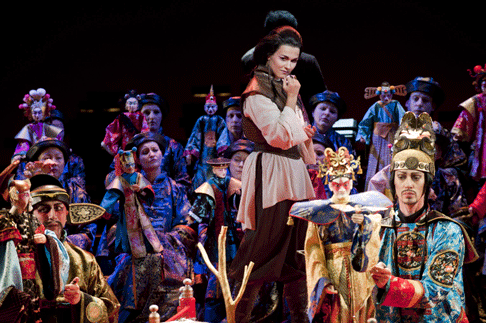 Scene from Le Rossignol (The Nightingale)
Scene from Le Rossignol (The Nightingale)
This Alceste was close to musical perfection with careful period performances by principal singers, chorus and orchestra. The production now moves on to Royal Danish Opera and the Vienna State Opera where perhaps it will lose some of this carefulness and hopefully attain a dramatic reality unfettered by performance practice.
Russian stage director Dimitri Tcherniakov knows we all know Don Giovanni pretty well, maybe too well. The Aix Festival knows its audience loves Mozart and so there is always plenty of it (there are 10 performances of this Giovanni). One of the recent Giovanni ‘s served up in Aix was by British director Peter Brooks who experimented with Mozart’s masterpiece by turning its singers loose on stage to figure it out for themselves -- it is not hard to imagine how successful that was.
Mr. Tcherniakov did not even try to figure it out. In fact he did everything he could to confuse the opera’s issues. First he informed us that Giovanni and Elvira are married and that Zerlina is Donna Anna’s daughter. Leperello is some relative who happens to be in the Commedatore’s house, and Masetto and Don Ottavio are various fiances who end up kissing each other.
Not that he re-wrote the script. It was still the same old familiar words, never mind that it made no sense. Though a curtain crashed onto a silent stage from time to time to inform us of a quite precise but totally arbitrary time line (un jour plus tard, trois jour plus tard, deux mois plus tard, etc.).
Mr. Tcherniakov ignored the mysteries of the Don Juan complex by making the Don Giovanni a drunken bum no one could possibly love. The mystery therefore was why the three women in the story love him. Not that much was explained except that Donna Anna loves sex and was not getting much of it from Don Ottavio, Zerlina was obsessed by sex and was not getting much of it from Masetto. Elvira was cold and did not seem to want much sex.
Thus, and this is maybe Mr. Tcherniakov’s point (if there could possibly have been one), we might hear Mozart’s Don Giovanni for the first time! That, maybe, we did indeed.
French conductor Louis Langrée took on the resources of the Freiburg Baroque Orchestra to magnificent result. Right-on tempi, certainly on the fast side, that took advantage of the agility of the early instruments, with the raspy sound of these more primitive versions of modern instruments used to implement attack and immediacy. These unfamiliar sounds made this familiar score come brilliantly alive. It was new music.
Plus Mozart’s score was accorded extraordinary relief with Mr. Tcherniakov’s play with silence. The curtain rose before the overture, and fell well before the overture was completed forcing our attention again onto sound. Action within the unit set (a room in the Commendatore’s comfortable haute bourgeoise house) was interrupted between numbers by the crashing curtain and minutes of silence. Each time begun again the music gained vibrancy.
Of many momentous moments several stand out. The Don’s, Danish baritone Bo Skovhus, serenade was a drunken reverie moving in his aloneness; Slutty Donna Anna’s, German soprano Marlis Petersen, account of her rape was her rape of Don Ottavio; Zerlina, Swedish soprano Kerstin Avemo, turned her Batti, batti into a sex fantasy with the Don (accompanied by a weird cello obligato); Elvira, Latvian soprano Kristine Opolais, was leaden of aspect when passed by the Don to the very physical Leporello of American bass-baritone Kyle Ketelsen; Don Ottavio, Canadian tenor Colin Balzer, kissed Masetto, Serbian/Israeli David Bizic.
You get the idea. The Aix Festival scoured the earth to get just the right people to upset Mozart with quite brilliant performances of his own music.
Well, bravo Aix, bravissimo! The trip has been worthwhile. So far.
Michael Milenski
image=http://www.operatoday.com/Alceste-acte-2.2.gif
image_description=Scene from Alceste [Photo by Pascal Victor / Artcomart courtesy of Festival d'Aix-en-Provence]
product=yes
product_title=Don Giovanni, Alceste and Le Rossignol
product_by=Festival d'Aix-en-Provence 2010
Click here for cast information.
product_id=Above: Scene from Alceste
All photos by Pascal Victor / Artcomart courtesy of Festival d'Aix-en-Provence
July 12, 2010
Mansouri looms larger than life in autobiography
By: Janos Gereben [San Francisco Examiner, 12 July 2010]
SAN FRANCISCO — The former San Francisco Opera general director’s candid — if inevitably self-serving — autobiography is of interest because it describes the history of a prominent contributor to The City’s artistic and cultural scene.
Handel’s Serse (Xerxes) at Iford Manor
They were stylistically very different and with the latter the German-born composer threw caution to the winds both musically and dramatically.
It was a bad call at the time as Serse flopped completely. The trouble was that he dared to change a tried and tested formula: the wholly serious, or tragic, seria format was infiltrated by comic or buffo elements; he mixed characters of both high and low class within the drama, and he even tinkered with the classic A-B-A da capo form of the arias. In Serse much of the vocal music is in arioso form, which drives the action forward more than the traditional, more musically complex da capo format. All this was too much for London audiences at the time and Handel lost money and soon after abandoned opera for the oratorio form. Luckily for us, today we can appreciate his innovations and revel in them — as indeed did the audience at Iford Opera in Wiltshire last Friday night.
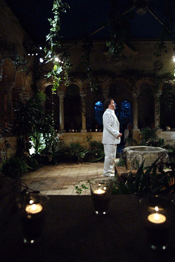 Andrew Radley as Arsamene [Photo courtesy of Iford Opera]
Andrew Radley as Arsamene [Photo courtesy of Iford Opera]
Once again, Iford Arts is to be congratulated for rising so magnificently
above the apparent limitations of its charming venue — one could indeed
argue that those very limitations of size and accessibility produce something
special time and again and last night was no exception. Iford encourages young
talent and in its regular offerings of Handel masterpieces in intimate
surroundings it also encourages the singers to concentrate on expression and
colour, as they do not need to worry about pushing their voices.
The usual convoluted Handel plot of misplaced affections, thwarted plans, ladies (and men) in disguise and the triumph of love and duty (in varying degrees) was efficiently translated into the tiny, greenery-draped colonnaded space that is the delightful Iford Cloister by director David Freeman. Although advertised as “Serse”, the opera was given in English and this “Xerxes” was a translation/edit by Andrew Jones which revived memories of the famous Hytner production of the 1980’s in its language, if not its staging. The lively score, regretfully drastically abridged, was offered in spicy miniature by the well-regarded players of La Nuova Musica directed from the harpsicord by David Bates who encouraged some really meaty, full-blooded playing from his 10 piece ensemble. In Acts I and II the cast were somewhat depressingly attired in budget-store casuals with a bit of sequin tat here and there to suggest royalty (one felt particularly for the female singers who suffered very unflattering wardrobes — surely at odds with the story?) but come Act III things improved a little. A few pyrotechnics, many tiny candles, and a clever exploding model bridge (to take King Xerxes across the Hellespont into Greece) made the most of the tiny stage area.
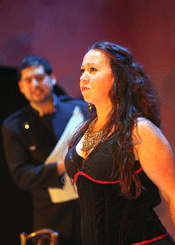 Kristin Finnigan [Photo by and courtesy of Ralph Ripley]
Kristin Finnigan [Photo by and courtesy of Ralph Ripley]
More importantly, there was much to admire vocally with some excellent
singing from the young cast, many of whom are at the beginning of their careers
yet showed remarkable histrionic as well as musical abilities in this most
demanding of genres. There was no one outstanding performer, but we left with
perhaps three strong memories: the exciting contralto voice of young Kristin
Finnigan (Amastre) which promises to help revive the great tradition of this
most English of voice types, the impressive comic timing and agile baritone of
William Townend (Elviro) and the expressive warm-toned countertenor of Andrew
Radley (Arsamene). Verity Parker impressed with some spot-on high coloratura as
Romilda whilst also singing with some nice supple tone. She was contrasted
effectively with Kristy Swift in the soubrette role of Atalanta who
brought out the foxiness of this character with some sparkling high notes and
agile phrasing. Rather unusually, this production gave the title role to a
countertenor, the more experienced William Purefoy. These days, it’s more
often a mezzo soprano role (although written by Handel for a soprano
castrato of great renown, Caffarelli) but here at Iford the tiny stage
and proximity of the audience enables the less powerful countertenor voice to
take it on. Purefoy coped well enough with the high tessitura of this
demanding role, if not convincing us dramatically. His was no dangerously
vindictive King but rather a placid, slightly academic, royal. This was
particularly so in the scenes with his stage brother Prince Arsamenes, when
Radley acted for both of them. Purefoy is certainly a good singer (his
“rage” aria, Crudie furie in Act III was efficiently
despatched despite its huge demands on the singer) but rather miscast here.
The role of the bluff, if dim, General Ariodate was robustly taken by baritone Jonathan Brown who made much of his limited role whilst contralto Kristin Finnigan was forced to do the same. How one longed to hear more of Amastre’s music and less of her creeping around the cloister, forever listening to the plotting of others’ loves. Finnigan might just be something special in the making — directors take note.
Cutting Handel is a fact of life — unpleasant but sometimes necessary — but for this writer there were just too many “cuts too far”. So many important, and lovely, arias went unheard. Everyone comes to Iford by car (there is no evening public transport in this idyllic rural location) so why not revel in more of Handel’s sublime music and get home half an hour later? After all, another thirty minutes in this beautiful place, with music of this quality, is hardly an imposition.
© Sue Loder 2010
Serse, by G.F. Handel continues on the 13th, 14th, 16th and 17th July at Iford, near Bradford on Avon, Wiltshire, U.K. More information: www.ifordarts.co.uk
image=http://www.operatoday.com/Iford-William-Purefoy_-Xerx.gif image_description=William Purefoy as Xerxes [Photo courtesy of Iford Opera] product=yes product_title=G. F. Handel: Serse product_by=Xerxes: William Purefoy; Arsamene: Andrew Radley; Amastre: Kristin Finnigan; Romilda: Verity Parker; Atalanta: Kristy Swift; Elviro: William Townend; Ariodate: Jonathan Brown. Orchestra: La Nuova Musica, directed/conducted by David Bates. Director: David Freeman. Designer: Louie Whitemore. product_id=Above: William Purefoy as Xerxes [Photo courtesy of Iford Opera]Three Decembers at Central City
It’s a dysfunctional family, and things are complicated further by the fact that son Charlie is gay — his partner is dying of AIDS — and daughter Bea — trapped in a bad marriage — has turned to drink. Nothing much new in that, is there?
But what makes Jake Heggie’s Three Decembers compelling is the depth that director Ken Cazan brings to it in the production that opened at the Central City Opera here on Saturday. Cazan makes Maddy, mother and actress, an Everywoman with two Everykids. We’ve all been there; we’ve all shared to some degree in the alienation and sorrow of these three characters and we’ve all lived the Little Lies that — with luck — add up to one Big Truth.
Cazan has gone for the subtext of the story and made this a poignant study in the drives that cause people to do the Wrong Thing and shun each other. Heggie wrote Decembers for his friend Frederica von Stade, and the staging that was new in Houston in 2008 has moved around the country with her as Maddy. Much — indeed, almost everything — is new here. The 12-member orchestra, on stage elsewhere, is now in the pit, and Joyce Castle plays Maddy. It’s not a question of who plays it better; it’s how different the two singers — mezzos looking back on long careers — are.
Von Stade is famous as cute and cuddly Cherubino and puppy-loveable Octavian, while Castle has made her mark as — to mention only a couple of her 146 roles — Strauss’ hard-as-nails Herodias and a gender-bent Orlovsky. Castle has an edge — a bite, a grit — that makes her Maddy powerful and brings depth to her suffering. She presses the audience to her own failed breast and involves them in the errors she has made. Her success is spectacular, and it adds dimensions to her kids.
Youthful baritone Keith Phares, who created the role in Houston, is a stellar Charlie, and as Bea CCO regular Emily Pulley makes no effort to hide the mess that her life is. Impressive here in such diverse roles as Elvira, Susannah and Vanessa, Pulley has never sung so beautifully as she does as Bea.
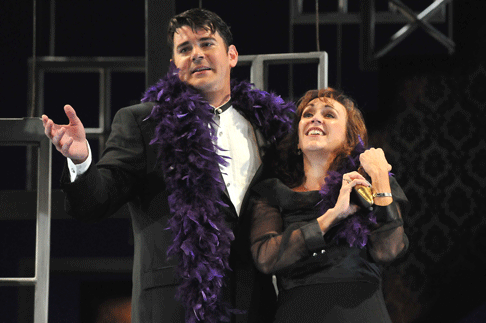 Keith Phares as Charlie and Emily Pulley as Beatrice
Keith Phares as Charlie and Emily Pulley as Beatrice
Designer Cameron Anderson hit upon a great idea to underscore Cazan’s approach to Decembers, white windows — a total of 50 — descend upon the stage and then leave it vacant for the final scene, a memorial service for Maddy, that brings about reconciliation and redemption.
“The windows,” Cazan explains in a program note, “represent the endless potential for communication — for the speaking and heeding” foreign to these three people. Windows, of course, also close.
Call Decembers— if you will — a chamber or even “pocket” — opera, is has grown immensely through the CCO staging. Heggie’s voice remains his own — closer here perhaps to Broadway than the Met. That, however, is of little concern. It is music that speaks to the heart; it provokes feeling and demands emotional reaction. He is clearly American’s no. 1 opera composer. His Dead Man Walking has been staged around the world, and he celebrated a new triumph by turning Melville’s Moby Dick into grand opera in Dallas in April.
Three Decembers is a modern masterpiece, and it documents the unusually intense collaboration between Heggie and librettist Gene Sheer, his partner also in Moby Dick. It is a triumph for Central City, but — alas — one that leaves a big question open: where were the opera-goers Saturday who usually pack the house here on opening night? They were painfully absent, and this is disturbing.
Heggie is today a household word in the music world. He was in Denver to open the Ellie; he’s been at the Vail Valley Festival. The University of Colorado staged an awesome production of Dead Man Walking. Yet on Saturday people stayed away in droves. Does this mean that to stay in business Central City must stage endless Bohemes and Carmens? One refuses to accept the answer seemingly given that question here on Saturday.
Played without intermission, Decembers runs 95 minutes. John Baril conducted.
Three Decembers plays in repertory with Madama Butterfly and Orpheus in the Underworld at the Central City Opera through August 8. For tickets and information, call 303-292-6700 or visit www.centralcityopera.org.
Wes Blomster
image=http://www.operatoday.com/CCOThreeDecembersMadeline.gif image_description=Joyce Castle (Madeline) [Photo by Mark Kiryluk courtesy of Central City Opera] product=yes product_title=Jake Heggie: Three Decembers product_by=Madeline: Joyce Castle; Beatrice: Emily Pulley; Charlie: Keith Phares. Director: Ken Cazan. Conductor: John Baril. Central City Opera. product_id=Above: Joyce Castle as MadelineAll photos by Mark Kiryluk courtesy of Central City Opera
A Magnificent Don Giovanni at Glyndebourne
What is "news" however, is the amazing production of Don Giovanni at Glundebourne, a work of art in itself. Wonderful orchestra, wonderful set, fully supporting the music and drama.
Jonathan Kent and set designer Paul Brown created the astounding Purcell Fairy Queen at Glyndebourne in 2009, so there was no chance this new production of Don Giovanni would be dull. Think about who Don Giovanni is. He’s always one step ahead, adapting and changing, always on the move. Kent and Brown take their cue from the opera and its music.
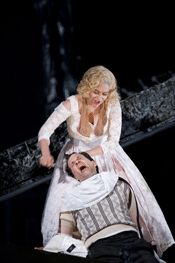 Anna Virovlansky as Zerlina and Luca Pisaroni as Leporello
Anna Virovlansky as Zerlina and Luca Pisaroni as Leporello
As we sat waiting for the performance to start, the theatre at Glyndebourne was suddenly plunged into total darkness. A power cut? No, this was theatre, in every sense. Gradually golden light picks out the orchestra. It’s a beautiful image, burnished instruments, musicians moving as in a ballet. Immediately, attention is focused on the music, as it should be.
The Orchestra of the Age of Enlightenment is one of the finest period orchestras in Europe. Historically-informed performance is valuable in Don Giovanni, not because it’s authentic whatever that might be, but because it creates lighter textures, reflecting the elegant, flexible movement in the music.
Then, instead of a conventional set, there’s a giant rotating cube, a square globe, so to speak, which contains “the world”. It unfolds, reshaping and reinventing itself: a box of tricks, like Don Giovanni himself. Because it’s meticulously designed the cube moves quickly and silently. it’s much less intrusive than conventional set changes. Major transformations take place during the interludes, so they don’t get in the way. This amazing set frees the action from technical limitations. allowing the drama to unfold, rapid-fire and free.
At first the cube reveals its secrets slowly. A crack appears. It’s a narrow alleyway. Don Giovanni is trapped like a rat, so he lashes out and kills the Commendatore..The cube closes again, its outer walls like a stone building. Later, the cube opens to reveal a sunlit garden, complete with trees. It’s the peasant wedding. So many shifts of focus. Garden transforms to ballroom, Zerlina’s loyalties shift, the masked visitors move in on Don Giovanni.
Conflagration ends the First Act. While the crowd converge on Don Giovanni, Don Ottavio points at objects, just like the Commendatore will later point at Don Giovanni. For now, it’s just the furniture that goes up in flames. Real flames, you can smell the gas. It feels dangerous, even though you know Glyndebourne (and its insurers) have checked it all out thoroughly. We know Don Giovanni will end up in hell, but seeing him circled by fire is dramatic. It’s entirely consistent with the turbulent music with which Mozart marks the beginning of Don Giovanni’s end.
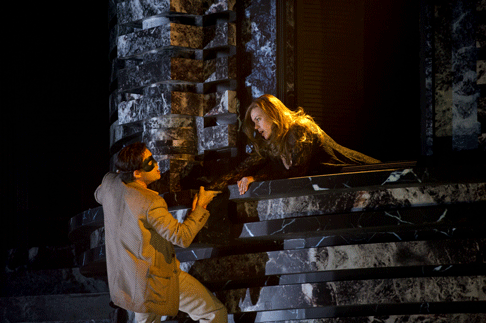 Gerald Finley as Don Giovanni and Anna Samuil as Donna Anna
Gerald Finley as Don Giovanni and Anna Samuil as Donna Anna
In the Second Act, the giant cube is transformed, as if it’s exploded. Don Giovanni’s clever stratagems are beginning to shatter. Instead of neat panels, wild diagonal planes, sharp angles, knife edges, if you will. Violence is implicit. The pace quickens, the orchestral playing with great agility. Some of the best singing all evening, too, the cast invigorated. Movement is well blocked, the cast nimbly negotiating the change of position (and costume).
Perched dangerously on the central diagonal plane, Gerald Finley (Don Giovanni) and Luca Pisaroni (Leporello) read the inscription on the Commendatore’s grave. No statue as such, but by this point in the performance the atmosphere of horror is so intense that a device like a talking statue would seem clumsy. As Finley teeters on the dangerous ledge, and Pisaroni cowers in terror, the Commendatore’s voice booms out. Invisible threats are much more frightening.
A golden candelabra on a luxurious table cloth. Don Giovanni’s showing off, trying to impress. . But the table’s on the spot that was the grave. Suddenly, the Commendatore pops up, a corpse in a rotting, blood-stained shroud. Death levels all, rich or poor. The corpse topples the table over, exposing its flimsy structure. Slowly, the corpse moves towards Don Giovanni and zaps him dead. Everyone gasps. A fantastic coup-de-théâtre!
It’s an overpowering image. Thank goodness for the final chorus “Questo è il fin”, where order is restored, and we’re reminded that theatre is glorious illusion.
Magnificent as the set is, this will also be a Don Giovanni to listen to for the orchestra. The Orchestra of the Age of Enlightenment are so good that they can generate almost demonic energy from the lighter timbres of period instruments. Vladimir Jurowski has rarely sounded more inspired, his tendency towards mysticism countered by the brightness of this playing. The music in the ballroom scene was particularly well defined. Trios move throughout this music, so defining the tripartite form in this orchestration is important.
Excellent flow between ensemble and soloists. Musicians of this calibre really make a difference This lutenist sounds truly seductive, and the harpsichord’s spiky interjections signal alertness, because there’s such sharpness of attack.
Gerald Finley’s Don Giovanni is smooth, even a little soft-grained to start with, but then he’s playing a man who achieves his aims by charm. His champagne aria “Fin ch’han dal vino”, didn’t fizzle but perhaps that’s a hint that Don Giovanni’s pursuit of pleasure is ultimately hollow.
When Don Giovanni’s trapped, he’s most lethal. In the Second Act, Finley’s voice darkens malevolently, yet he also manages to express the vulnerability in Don Giovanni’s character. Does he really enjoy seduction, or is it obsession? Perhaps women are attracted because they sense that need in him.
But the operas isn’t Don Giovanni’s alone. Luca Pisaroni’s Leporello made the dynamic between master and servant powerfully pungent. At Glyndebourne, you sometimes can’t tell patrons from waiters, they’re all in the same uniform, which adds extra piquancy to Mozart’s subversive undercurrents.
The interaction between Finley and Pisaroni is very carefully timed, superb vocal rapport. Pisaroni’s Leporello is no put-upon fool, he pulls the strings.. Very muscular, assertive singing, masterful in every way. At the end, Pisaroni’s Leporello takes a photo of his master’s corpse. Does he, too, have a “stud book” of past conquests?
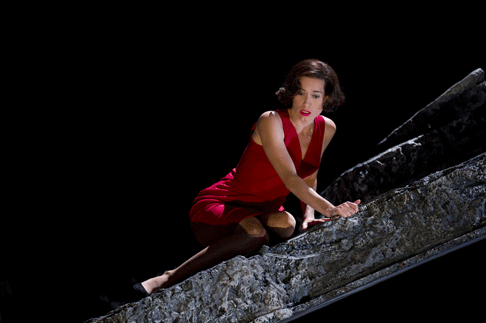 Kate Royal as Donna Elvira
Kate Royal as Donna Elvira
The friend with whom I attended this performance has heard Cesare Siepi, Elizabeth Schwarzkopf and many others in this opera, but he doesn’t judge singers in isolation as if they were lab specimens. Context matters, too. “These female singers are more like real women”, he said, “not divas doing a role”. It’s a generous comment, as Kate Royal’s Donna Elvira is just too big for her, and Anna Samuil’s Donna Anna, though good in general, won’t go down in history. Though given the performance history of this opera, that’s a tall order.
Anna Virovlansky’s Zerlina stood out, vocally firm and bright, physically vivacious and energetic..There she is, up against a wall with Don Giovanni, eagerly co-operating. Confronted by Masetto (Guido Loconsolo) she begs him to beat her. Virovlansky makes it sound wildly kinky, hinting at the darker aspects of Zerlina’s personality.
Glyndebourne performances sell out quickly, so there’s almost no chance of getting tickets other than returns. Get involved now, to be ready for 2011. But there’s a lot more to Glyndebourne than attending its summer season.
Glyndebourne’s significance is immeasurably greater than its seating capacity. It’s a small house, but it produces work of such high quality that it easily competes with many larger companies. Anyone seriously interested in European opera needs to be aware of Glyndebourne. These days, all opera houses need to extend their coverage beyond core live performance. Not everyone can attend in person, but broadcasts, DVDs, licensing, all help to ensure the financial health of the house., and extend its audience around the world.
Glyndebourne’s Don Giovanni is being screened on BBCTV2 at Christmas, and on Medici TV. A DVD release is likely.
For more information, please see the Glyndebourne site.
Anne Ozorio
image=http://www.operatoday.com/Don-Giovanni-GFO-2010-009.gif
image_description=Gerald Finley as Don Giovanni [Photo by Bill Cooper courtesy of Glyndebourne]
product=yes
product_title=Wolfgang Amadeus Mozart : Don Giovanni
product_by=Donna Anna: Anna Samuil; Don Ottavio : William Burden; Don Giovanni: Gerald Finley; Leporello: Luca Pisaroni; Donna Elvira: Kate Royal; Zerlina: Anna Virovlansky; Masetto: Guido Loconsolo; Il Commendatore: Alastair Miles / Brindley Sherratt (July 7, 18-31). Conductor: Vladimir Jurowski / Jakub Hruša (July 31-August 27). Director: Jonathan Kent. Designer: Paul Brown. Lighting Designer: Mark Henderson. Movement Director: Denni Sayers. Fight Director: Alison de Burgh. Glyndebourne Opera. 7th July 2010.
product_id=Above: Gerald Finley as Don Giovanni
All photos by Bill Cooper courtesy of Glyndebourne
July 11, 2010
Semele, Paris
She was in Paris to appear in one of her signature roles—Semele, Ovid’s overambitious nymph who pursues immortality but finds death—in Théâtre des Champs-Élysées revival of David McVicar’s 2004 production of Händel’s eponymous oratorio-opera.
I am not sure I would want to hear the whole performance again on tape, if one exists. Certainly I have no desire to seek out the obscure recording of the role de Niese made early in her career (Arion PV704021/22, deleted). Yet in the house, watching as well as listening, it made for a memorable evening. The Paris audience agreed, responding with a quarter hour of unrestrained cheers and rhythmic applause.
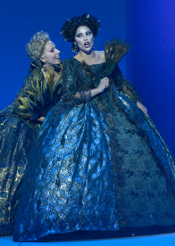 Jael Azzeretti and Vivica Genaux (as Juno)
Jael Azzeretti and Vivica Genaux (as Juno)
My ambivalence stems from the fact that de Niese, as many have noted, is not
a singer’s singer. At the top her voice turns metallic, runs and
registers are not perfectly even, and slightly strained vocal production
precludes a genuine piano or legato. Though she has the notes, manages
coloratura adequately, and possesses a distinctive smoky timbre in the middle
of her voice, the overall impression can be monochromatic. From a purely
musical perspective, de Niese cannot offer the listener the spell-binding
moments conjured up by the very greatest exponents of the Baroque and classic
repertoire.
Yet de Niese makes 150% of what remains. If she lacks the nightingale delicacy and elegant ornamentation most others deploy in Händel, she supplants it with earthy exuberance and youthful energy. Her beauty and disarmingly naturalistic style of acting—more like TV than opera—convey a modern type of dramatic conviction. With Semele, the result is a musical-dramatic portrait of a flesh-and-blood creature: a spoiled adolescent, pouting, panting and protesting by turns. None of this is subtle, musically or dramatically, yet it is a perfect match of singer and role. De Niese shines particularly brightly in dramatic confrontations, such as the coloratura quarrel with Jupiter that seals her doom (“No, no, I’ll take no less”), her eyes flashing as she spits out the runs—a moment that normally seems anemic. She is similarly at home exploiting her sex appeal, more as actress than singer, as when she seduces Jupiter by running her foot along his crotch. (Amazing what tenors get to do, these days!)
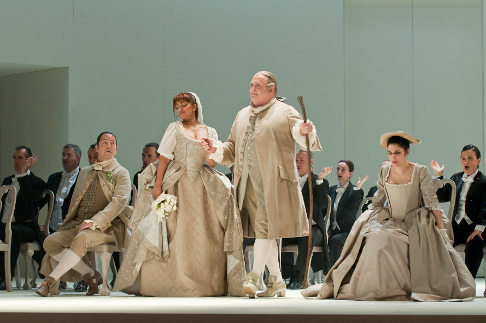 Stephen Wallace, Daniele de Niese, Peter Rose, and Vivica Genaux (as Ino)
Stephen Wallace, Daniele de Niese, Peter Rose, and Vivica Genaux (as Ino)
For those who favor purely musical values, de Niese’s colleagues offered greater rewards. Foremost among them was Peter Rose. Though surely among the most versitile of modern basses—in the past two months, he has sung Osmin in München, Ochs in Barcelona, Gurnemanz in Tokyo, and Falstaff in Seattle—Rose is hardly known as a Baroque specialist. Yet his Cadmus/Somnus was stylish and sonorous, underpinned by rock-solid lower register. At the end of Somnus’s “Leave me, loathsome light,” he interpolated down an octave to a long B1 (at Baroque pitch that’s almost a low b-flat). Resounding through the large theater like an organ pedal, it was one of the most astonishing notes I have heard in decades. Such vocal details were consistently accompanied by clear diction, convincing characterization, and sensitive phrasing.
The young Maltese-born, London-trained soprano Clair Debono made a limpid Cupid, singing in a “correct” Baroque performance-practice style that contrasted with the other principals, delivered with great sensitivity. Debono, who’s been appearing under William Christie and Emmanuelle Haïm, dispatched the Act I aria, “Endless Love” (actually written for Semele) to great effect. McVicar had her wander the stage in red 18th century garb, a black cane, and pair of John Lennon-style sunglasses—a striking allusion to Cupid’s blindness.
Alaskan mezzo Vivica Genaux assumed the double-role of Semele’s dull sister Ino and the imperious goddess Juno, differentiating the two splendidly. She offered much of the stylistic subtlety that De Niese lacked, even if her voice is not the plushest. American tenor Richard Croft, a veteran from the 2004 who has recorded the role on the recent Curnyn/Grange recording, assumed the demanding tenor part of the philandering Jupiter. Every note was in place, though the voice seemed to lack the extra sheen I have heard in years past, for example in “Where’er you walk.” Could this reflect the strain of preparing the Met’s Loge in the fall?
Less satisfying was countertenor Stephen Wallace as Athamas, another 2004 returnee. His voice seems to be fragmenting, with four or five strong notes in the high-middle, surrounded by weakness and an almost tenorial bottom. French soprano Jaël Azzeretti sang beautifully as Iris, like Debono in a more classically Baroque fashion, but her diction suffered by comparison to an otherwise Anglophone cast.
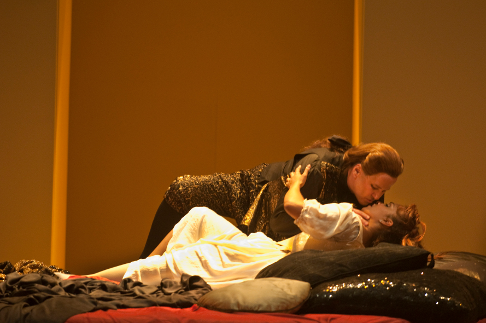 Richard Croft and Danielle de Niese
Richard Croft and Danielle de Niese
McVicar’s production sets the entire opera in a single elegantly minimalist hemicylical space. The action is understated, sometimes even ironic, with only one coup de théâtre: the moment when Jupiter removes his regal protective cloak from Semele’s shoulders and—like Don Giovanni—she sinks into a smoking floor. Otherwise, McVicar’s quietly elegant approach focuses the action on inter-personal relations. This helps translate a chorus-laden and declamatory oratorio into a more complex opera libretto. Semele becomes story not simply of the title character’s ambition, but of sibling rivalry. Ino is resentful: She wears spectacles, for example, symbolizing not only her plainness compared to her sexy sister, but the fact that that she, in contrast to blind Cupid or impulsive Semele, sees her true love from the start.
Overall the performance highlights the current state of Baroque opera performance, which has found new a compromise between the full-voiced dramatic style of the 1970s Handel revival and the purity of the 1980s and 1990s heyday of “authentic” practice. While harpsichordist cum conductor Christophe Rousset is steeped in the latter aesthetic, and continues to do much to uncover new and obscure scores, his interpretive ideal in Händel opera remains Marilyn Horne. Rousset believes—I suspect he’s right—that Händel would approve of such an overtly dramatic approach, not least in an overtly witty and bawdy “tragedy” like Semele. Rousset’s conducting bristled a bit, rather at the expense of charm—though, to be sure, despite its wonders, Händel’s score lacks the orchestral range of Monteverdi or Mozart—but Les Talens Lyriques and the Choeur du Théâtre des Champs-Élysées followed with admirable virtuosity. Overall, the success of this hybrid Händel evening is a tribute to the leadership of Dominique Meyer, who promoted much Baroque opera at Champs-Élysées and with these performances leaves Paris to head the Wiener Staatsoper.
Andrew Moravcsik
image=http://www.operatoday.com/Semele_Paris_2010_de-Niese_.gif image_description=Danielle de Niese and Vivica Genaux (as Ino) [Photo by Alvaro Yanez] product=yes product_title=G. F. Handel: Semele product_by=Danielle de Niese, soprano; Jaël Azzaretti, soprano; Vivica Genaux, mezzo-soprano; Stephen Wallace, countertenor; Richard Croft, tenor; Peter Rose, bass. Les Talens Lyriques. Christophe Rousset conductor. product_id=Above: Danielle de Niese and Vivica Genaux (as Ino)All photos by Alvaro Yanez
Luisa Miller, Buxton Opera House, Derbyshire
By Andrew Clark [Financial Times, 11 July 2010]
When arias and duets are as sweetly melodic as Luisa Miller’s, you have to ask why the opera is not performed more frequently. One reason may be that Verdi wrote too many masterpieces to allow the also-rans a chance. Or perhaps Luisa Miller is too much of a transitional work: it lacks the elemental vigour of his “galley” years without achieving the dramatic sophistication of Rigoletto, La traviata and other masterpieces of his middle period.
Terfel’s Towering Hans Sachs Debuts at WNO
Were I to be able to fiddle with the nominees to the New Seven Wonders of the World, Bryn Terfel’s overwhelming performance as Hans Sachs would easily crowd out such also-ran’s as Iguassu Falls or the Great Barrier Reef, though every bit as much a force of nature. Simply put, I cannot imagine anyone in the opera’s history has ever sung this tour-de-force part better. I know Bryn has quite wrecked me for anyone else in this role. Ever. It is not hard to say why.
He is possessed of one of the greatest bass-baritone voices on the operatic roster today, characterized by the familiar easy production, amazing resonance, incredible beauty, richness of tone, subtlety of delivery, immaculate diction, reserves of power, and awesome stamina. Even at five and a half hours into the evening, he arrived at the final pontificating proclamation sounding so fresh it seemed like he could do it all over again. Mr. Terfel is also an unaffected, winning actor, one moment prankish and charming, the next effectively communicating the cobbler’s deeply internalized human concerns and disappointments. The great “Wahn” monologue was heart-breaking in its intensity, immaculate in its vocalization. Uniquely gifted and undaunted by the challenges, Terfel relished every moment in one of the lyric theatre’s most demanding assignments.
As towering as his achievement was, I can happily report that WNO miraculously peopled this Meistersinger with a cast of equals. Christopher Purves was an ideal Beckmesser, imbuing the character with good doses of pomposity to be sure, but balancing that with a truly diversified emotional palette that went well beyond the boorish posturing oft-seen in lesser hands. Mr. Purves is also possessed of a gleaming, responsive baritone capable of pinging declarations as well as smoothly phrased lyrical passages. And he is an accomplished comic actor, never-overplaying but willing to do anything. Having been beat up the night before, and wearing shoes that pinch, his Act III entrance into Sachs shop was a marvel of sustained physical humor. I will not soon forget him stepping up into the room oh-so-carefully and then somehow getting caught in a goofy spin and a sudden pratfall as he closed the door. (A bit that was repeated later to equal guffaws when he mounted the grandstand to sing his contest entry). And. . .and. . .alone in the cobbler studio, he checked out the bruise he sustained on his hip, at the same time he “unawares” fully bared his butt to the audience. Laugh out loud funny. Purves is the best Beckmesser of my experience, surpassing even the beloved Hermann Prey.
Lovely Amanda Roocroft achieved the difficult feat of looking and acting like a very believable young girl, while capably singing with enough of an experienced jugend-dramatisch thrust to her well-schooled soprano to make for a highly enjoyable and plausible Eva. She was utterly ingratiating and sympathetic, not only in her growing feeling for Walther but in her obvious love for Hans Sachs. Anna Burford sported a dark-hued mezzo that delivered wonderful results as Magdalene, complementing while contrasting Ms. Roocroft’s brighter production. Andrew Tortise gave us a perky, boyish, pleasingly annoying David, and I especially liked the moments when his sweet-toned tenor settled down for some shining mezzo forte singing. Mr. Tortise nailed the part to be sure, but I thought the tone took on a harder edge than necessary when pushed at the top. Perhaps a bit less histrionic abandon would keep the bloom in the upper register. Raymond Very also presented a very good case for Walther von Stolzing. He cuts a fine figure on stage as the impassioned youth, and displays a commendable understanding of the young man’s dramatic journey. While his instrument may lack the dark warmth of Kauffmann or the lyric spin of Heppner, Very nonetheless scored all the major moments and commanded his somewhat steely resources very credibly.
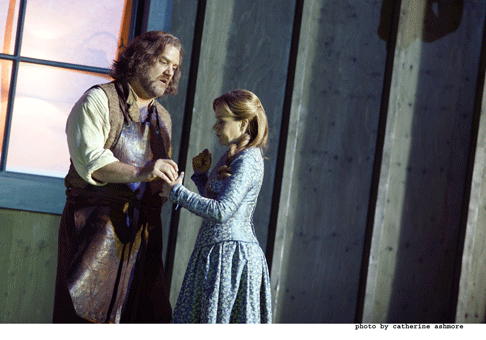 Bryn Terfel as Hans Sachs and Amanda Roocroft as Eva
Bryn Terfel as Hans Sachs and Amanda Roocroft as Eva
All of the Masters were securely presented, with accomplished singing and assured acting from a diverse roster of performers so fine they deserve to be knows more widely (see cast list below). Brindley Sherratt must be singled out for his tremendous achievement as Veit Pogner. Mr. Sherratt has a bass-baritone of enjoyable timbre and considerable power, which he deploys with great security as well as sensitivity. His prowess in the role suggests that he, too, may have a fine Sachs within him. I was also mightily impressed by the gorgeously intoned phrases from David Soar’s Nightwatchman.
Conductor Lothar Koenigs worked musical wonders with the mass of accomplished musicians in the pit, leading with sweep and abandon. Ocassionally, a wee too much ‘abandon:’ Ms. Roocroft was somewhat challenged on “O Sachs! Mein Freund”. But such moments were momentary compared to the glories of the orchestral detail that Koenigs revealed, especially the fleet footed comic touches of the dancing winds. Maestro Koenigs managed a real partnership with the voices and struck a good balance while still reveling in Wagner’s scoring. As one might expect in Wales, the choral singing under Stephen Harris was of the highest rank, surpassing even the much-lauded Bayreuth standard.
With this spot-on, straight-to-the-heart-of-the-matter realization of Die Meistersinger, Richard Jones has helmed an absolute theatrical triumph. Past experiences with Jones left me thinking he we was a gifted if challenging director, often in your face, sometimes maddeningly provocative as he diddles around the edges of a piece trying (often successfully) to illuminate the dramatic truth. I usually admired the ‘parts’ if not the ‘sum.’ Here he is in total focused control of not only the best Meistersinger I have ever seen, but one of the best opera productions I have ever seen.
There is a quiet quirkiness going on to be sure with the evocative and highly functional set designs by Paul Steinberg. The tone is perfectly set by the vibrant show curtain, featuring a collage of likenesses (mostly head shots) that fill the proscenium with of a vast array of brilliant German (or German-speaking) artists from the country’s history: Bach, Goethe, von Karajan, Marlene, Mozart, Ruth Berghaus, Brecht, Schwarzkopf. . .and on and on. This opens to a clean, lean church with a hunter green, paneled back wall, the congregation facing off right seated on stylized green benches perpendicular to the audience. This space proved amazingly adaptable to the various clever ideas the production team devised.
Apprentices soon hung the back wall with portraits of the Masters by inserting them in ridges in the back paneling. A red clothes Schrank was rolled on for each Master, painted outside with graphics/figures that illustrated the ‘song criteria’ what David was enumerating. These same delightful cartoonish graphics were reproduced in rows on the scoring ‘Tafel.’ As they were positioned in a welcoming semi-circle, they revealed the contents of the mini-closets: lavish period Masters robes designed by the supremely talented costumer Buki Shiff whose well-judged creations went from strength to strength.
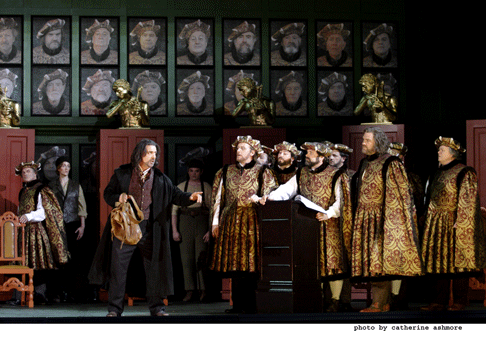 Raymond Very as Walther, Brindley Sherratt as Pogner, Bryn Terfel as Hans Sachs and WNO Cast
Raymond Very as Walther, Brindley Sherratt as Pogner, Bryn Terfel as Hans Sachs and WNO Cast
Within this milieu, Jones created some masterful blocking of both scenery and actors, witness the initial exchange between Walther and Eva, delightfully broken up with Magdalene’s perfectly timed interruptions as she deftly made her way around the stage looking for the ‘lost’ broach/scarf/book like a well-tuned mine-sweeper. The invention of one of the Masters as a doddering old man, always just a few beats behind the action was, well, Master-fully repeated just enough to be increasingly funny over the evening. Just when you had forgotten about him, he would be revealed, once more having been left in the dust and having to catch up like Arte Johnson’s geezer on Laugh-In.
The plain look of the exterior of Sach’s humble cobbler shop which filled stage center was well contrasted by Pogner’s well-to-do half-timbered house sitting down right flanked by an impressive tree. A cheeky contemporary touch was added with the colorful stylized projections that created flowered roofs, and the matching flower backdrop -- a retro nod to the 60’s. Thanks to Mimi Jordan Sherin for so many effective lighting effects, always shifting to reflect the correct mood, or to focus our attention right where it should be.
I think that Richard Jones succeeded so magnificently where others fail in that he never lost sight of the fact that this is a comedy. When Walther sings of being intimidated by the Masters, lo and behold three extras cross in full Masters drag, their heads covered with cubes bearing the cartoon ‘criteria’ and wagging a stick of chalk. A moment of inspired madness worthy of Bill Irwin. In a spontaneous moment, Sachs suddenly breaks into a daffy Schuhplatten dance, and why not? He’s having a good time. The nightwear for the big choral finish and street fight was all funky white fun, and the mob not only assaults Beckmesser, they strip him to his shorts leaving him to cover his genitalia with his lute (placed rather suggestively).
The stage-filling interior of Sachs shop/house is meticulously dressed as well as any set I have ever seen. No piece of furnishing, no prop, no element of this environment was left to chance. This was loving attention to detail. The curtain rose in silence on Act III with the streaming sunlight awakening Sachs from the sofa/bed where we get the impression he has fallen asleep and just never moved to the bedroom. Later a revelatory piece of business has him picking up three emptied beer bottles from the floor by the sofa and puts them on a side shelf. And, we get it. What volumes that spoke.
In that simple gesture is revealed another insight into our hero than we ever had before. Thank you, Mr. Jones. Thank you, Mr. Terfel.
When Sachs, at his desk, takes ‘dictation’ of the Prize Song, he rises and clothespins five separate sheets on a clothesline stretching above the sofa.
He collects them back, of course and allows Beckmesser to take them, but later when he christens the tune “Morning Dream Song”, that too gets posted on the line and as the five soloists sat variously and regarded the paper, and Ms. Sherin’s lighting picked out the singers and the song, and they launched into arguably the most glorious pages of the score, well, time was indeed suspended. A luminous quintet in every way.
The festive last act was perhaps the most predictable, although no less enjoyable. There was clever business with a self-important local noble woman serving as a sort of county fair judge, who apportioned blue ribbons for shoes, embroidered panels, and pretzels as the appropriate guilds sang and made their presence known. The large green grandstand upstage was colorfully festooned with flowers and the like, and it provided a straight forward playing space. But the team had one more trick up its sleeve.
Just as Sachs began his last (to some, controversial) monologue, one by one the chorus stood and held up a placard with one of the likenesses from the show curtain. Here Brahms. There Ludwig II. Now Handel. And another. And another. Until finally, the cast had recreated the show curtain, a sea of placards held chest level, with each singer pointing to their placard on the final chord as if to say: ‘German culture, how cool is that?’
Overwhelming. Brilliant. Towering. I think Wagner himself would have loved it. And if he didn’t. . .to hell with him!
James Sohre
Click here to download trailer (iPod).
image=http://www.operatoday.com/Terfel_Meistersinger_WNO_20.gif
image_description=Bryn Terfel as Hans Sachs [Photo by Catherine Ashmore courtesy of Welsh National Opera]
product=yes
product_title=Richard Wagner: Die Meistersinger von Nürnberg
product_by=Walther von Stolzing: Raymond Very; Eva: Amanda Roocroft; Magdalene: Anna Burford; David: Andrew Tortise; Hans Sachs: Bryn Terfel; Sixtus Beckmesser: Christopher Purves; Veit Pogner: Brindley Sherratt; Fritz Kothner: Simon Thorpe; Kunz Vogelgesang: Geraint Dodd; Konrad Nachtigall: David Stout; Ulrich Eisslinger: Andrew Rees; Herman Ortel: Owen Webb; Balthasar Zorn: Rhys Meirion; Augustin Moser: Stephen Rooke; Hans Folz: Arwel Huw Morgan; Hans Schwarz: Paul Hodges; Nightwatchman: David Soar. Conductor: Lothar Koenigs. Director: Richard Jones. Set Design: Paul Steinberg. Costume Design: Buki Shiff. Lighting Design: Mimi Jordan Sherin. Chorus Master: Stephen Harris.
product_id=Above: Bryn Terfel as Hans Sachs
All photos by Catherine Ashmore courtesy of Welsh National Opera
July 9, 2010
La Traviata, Royal Opera
Benjamin Britten was said to listen to the music of Brahms once a year, to remind him why he loathed it. (Oddly, however, there is a recording of the op.52 Liebeslieder Waltzes from Aldeburgh.) In a similar spirit, although on a considerably broader timescale, I considered that it would do me no harm to put my prejudices or judgements to the test.
There would be many worse ways of doing so than seeing Angela Gheorghiu as Violetta. I had not actually heard her in the flesh before and was a little surprised as to how small her voice is. She made it work though, so that it could be heard perfectly well even when singing pianissimo. Her coloratura was, so far as I discerned, flawless, no mean feat. I recall watching this production on the television as a schoolboy, the first run under Solti which really made Gheorghiu’s name. She obviously does not look — or sound — so young now, but this remains still a fine vocal performance. In terms of playing herself on stage she is also clearly without peer; Angela Gheorghiu is a role one is tempted to think she was born to play. Certainly one had the impression, rightly or wrongly, that her movements, her expressions, pretty much everything she is doing — all these are very much her own thing.
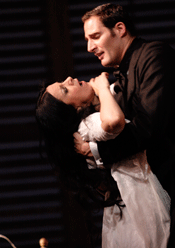 James Valenti as Alfredo Germont and Angela Gheorghiu as Violetta Valéry
James Valenti as Alfredo Germont and Angela Gheorghiu as Violetta Valéry
Given the conservatism of Eyre’s production, and especially of Bob
Crowley’s designs, that is not necessarily so bad thing. Zeffirelli with
a slightly lower calorie count doubtless appeals to some even on this side of
the Atlantic, but there is suspension of disbelief and then there is the size
of Violetta’s bedroom in act three of this production. Otherwise, the
costumes look beautiful and so forth, but it is really only the presence of the
soprano that grants any sense of theatre at all: ironic, since that then
reinforces the idea that opera should be about star singers and therefore about
works like this, and a vicious, doubtless highly commercial circle ensues. I
can only assume, moreover, that some deal had been struck with the Association
of Consumptives, for the state of the audience made poor Violetta seem hale and
healthy.
James Valenti looked good as Alfredo and sang ardently, but often wavered in intonation. There was strength in the singing of Željko Lučič as Germont père, though his stage presence was somewhat wooden (how much is the production at fault here?) and his style sounded just a touch incongruously Slavic. The choral singing was excellent, for which thanks must once again go to Renato Balsadonna and of course the Royal Opera Chorus itself. And the orchestra played beautifully, Yves Abel directing unobtrusively but not without character.
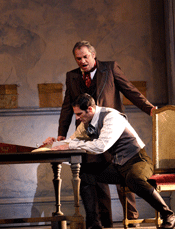 James Valenti as Alfredo Germont and Željko Lučić as Giorgio Germont
James Valenti as Alfredo Germont and Željko Lučić as Giorgio Germont
There remains the work itself. I tried, but the esteem in which it and
Verdi’s œuvre in general are held continues to baffle me. Puccini
can be mawkish, Rossini can be shallow, but there is a degree of craftsmanship
to be heard and admired there. Verdi seems to combine the worst aspects of
both, standing perhaps slightly above Donizetti, but that is all. The
orchestration is often rudimentary — though, as I said, the orchestra
made the most of what it had. Harmony is uninteresting and the accompaniments
— the word for once is apt — are often so derisory. And then there
is the ‘tart with a heart, transfigured’ tale: does it go beyond
the level of a women’s magazine story? I fail to see how — and it
now seems utterly dated, not least in its attitude towards gender. Just when
one thinks there might be some psychological insight, the music of the pizza
parlour returns. The ‘tunes’, memorable because one hears them so
often, are rarely integrated into the musical texture, such as it is, let alone
into the drama, such as it is. Given the lack of musical interest, surely a
more adventurous production might alleviate the ennui.
Regietheater seems a necessity here. Were this a neglected work, one
could understand someone thinking it worth a try, but a staple of the
repertoire? Some people might, for a variety of reasons, dislike Wagner; but
being something other than Wagner is not in itself a guarantee of anything. As
Pierre Boulez once put it, Verdi is ‘picture-postcard music’. He
said that he would prefer to see a whole landscape; the same goes for me.
Mark Berry
image=http://www.operatoday.com/Gheorghiu_Traviata_ROH_2010.gif image_description=Angela Gheorghiu as Violetta Valéry [Photo by The Royal Opera/ Catherine Ashmore] product=yes product_title=Giuseppe Verdi: La traviata product_by=Violetta Valéry: Angela Gheorghiu; Alfredo Germont: James Valenti; Giorgio Germont: Željko Lučič; Baron Douphol: Eddie Wade; Doctor Grenvil: Richard Wiegold; Flora Bervoix: Kai Rüütel; Marquis d’Obigny: Changhan Lim; Gastone de Letorières: Ji-Min Park; Annina: Sarah Pring; Giuseppe — Neil Gillespie; Messenger: Charbel Mattar; Servant: Jonathan Coad; Ladies and Gentlemen, Friends of Violetta and Flora, Guests, Servants. Director: Sir Richard Eyre; Designs: Bob Crowley; Movement: Jane Gibson; Lighting: Jean Kalman. Royal Opera Chorus and extra chorus (chorus master: Renato Balsadonna); Orchestra of the Royal Opera House; Yves Abel (conductor). Royal Opera House, Covent Garden, London, 8 July 2010 product_id=Above: Angela Gheorghiu as Violetta ValéryAll photos by The Royal Opera/ Catherine Ashmore
July 8, 2010
Salome, London
The House of Horrors element that irritated considerably last time seemed softened, replaced by a lighter, more humorous form of camp. Perhaps this were so, or maybe it was just a case of knowing what was coming; at any rate, in this of all operas, a somewhat lower level of sensationalism was gratefully received.
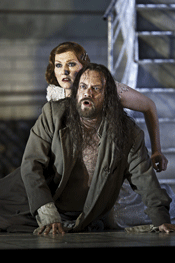 Johan Reuter as Jokanaan and Angela Denoke as Salome
Johan Reuter as Jokanaan and Angela Denoke as Salome
There is something to be said, I suppose, for the transformation of Herod and Herodias into comic characters, though there was perhaps a little too much of the world of the sitcom to their behaviour. More fundamentally, I remain unsure why the work was updated to the inter-war years 1920s: not that I have any specific objection to it, but little was made of it, beyond perhaps the sense of a violent society — but what society is not? — and the still-problematical caricaturing of the Jews. Wilde, Hedwig Lachmann, and Strauss really do not need any help in that regard. McVicar’s Dance of the Seven Veils witnessed second time around was no surprise, but it remains perverse. Salome gains clothes rather than lose them, as she appears to relive her childhood with the suggestion of Herod as her abuser. Es Devlin’s set retains its striking appeal, the split-level ‘upstairs-downstairs’ arrangement providing glimpses of the Tetrarch’s dinner party proceeding above, until the guests repair below — somewhat oddly, given the distinctly unglamorous nature of the basement. The costumes are generally equally striking, not least in the case of the typical McVicar array of extras: the guests and various household functionaries, including an array of pretty waiters in tight uniforms. And then there is Naaman, the executioner, whom McVicar has transformed into a principal — though necessarily dumb — character, played once again by the muscular street entertainer from Covent Garden market, Duncan Meadows. I have yet to be enlightened as to why he would have stripped off whilst down in the cistern, but his bloodstained reappearance doubtless titillated some. There was quite a bit of casual nudity elsewhere but the only truly erotic moment was that of Salome’s fatal kiss, which certainly retained its horror, and rightly so.
Hartmut Haenchen’s account of the score took a while to get going; I seem to recall a similar trajectory when I heard him conduct Salome a few years ago in Paris. However, after the first half an hour or so, he captured a fine balance between demands of the dance and colouristic fantasy. The orchestra was on fine form after a slight initial thinness of tone, strings gleaming as if instantiating the jewels with which the Tetrarch vainly tries to pay off Herodias’s daughter.
Angela Denoke put up a valiant attempt in that role. She paid commendable attention to the words, give or take a few peculiar consonants, but lacked the sheer physicality of Nadja Michael in 2008. Denoke appears a little too much the elegant woman of a certain age. Moreover, the more extreme demands placed upon her by Strauss found this Salome almost as severely parted as her predecessor, albeit closer to the prescribed pitches. McVicar’s conception of Jokanaan — a ‘Beckettian tramp soaked in sewage’ — does not assist a singer’s assumption of the role, but Johan Reuter proved a worthy successor to Michael Volle, providing an aptly lumbering physical presence, expressed through his voice as much as his acts. Gerhard Siegel and Irina Mishura impressed in their way as the Herods, amusing if not necessarily regal. Andrew Staples presented a credibly sympathetic portrayal of Narraboth, who is after all the only sympathetic character in the drama, though memories of Joseph Kaiser last time around were undimmed. Smaller parts were generally well taken, the chattering Jews especially — whatever resultant discomfort one might feel.
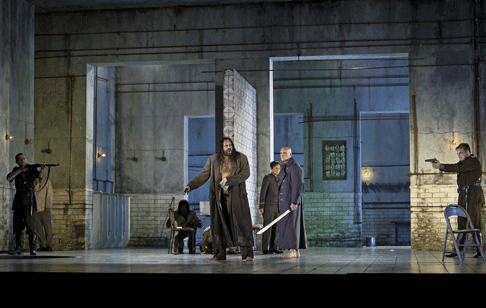 From Left to Right: Nicolas Courjal as First Soldier, Johan Reuter as Jokanaan, Sarah Castle as Page Of Herodias, Duncan Meadows as Naaman and Andrew Staples as Narraboth
From Left to Right: Nicolas Courjal as First Soldier, Johan Reuter as Jokanaan, Sarah Castle as Page Of Herodias, Duncan Meadows as Naaman and Andrew Staples as Narraboth
If there was something of an end-of-term feeling to this revival, which comprises but five performances, everything was commendably professional. Ultimately, however, I do not feel that the production gets to the heart — if heart Salome has — of the work. I remain hopeful that Harry Kupfer’s stunning production for the Staatsoper Unter den Linden will see the light of day on DVD. In the meantime, there is amusement to be had here.
Mark Berry
Click here for video trailer of this production.
image=http://www.operatoday.com/SALOME-100701_0446-DENOKE-A.gif
image_description=Angela Denoke as Salome [Photo by The Royal Opera/ Clive Barda]
product=yes
product_title=Richard Strauss: Salome
product_by=Narraboth: Andrew Staples; Herodias’s Page: Sarah Castle; First Soldier: Nicolas Courjal; Second Soldier: Alan Ewing; Jokanaan: Johan Reuter; A Cappadocian: John Cunningham; Salome: Angela Denoke; A Slave: Andrea Hazell; Herod: Gerhard Siegel; Irina Mishura: Herodias; First Jew: Adrian Thompson; Second Jew: Robert Anthony Gardiner; Third Jew: Hubert Francis; Fourth Jew: Steven Ebel; Fifth Jew: Jeremy White; First Nazarene: Vuyani Mlinde; Second Nazarene: Dawid Kimberg; Naaman: Duncan Meadows; Guests of Herod. Director: David McVicar; Revival Director: Justin Way; Designs: Es Devlin; Lighting: Wolfgang Göbbel; Choreography and Movement: Andrew George; Revival Choreography: Emily Piercy; Video Designs: Leo Warner and Mark Grimmer for Fifty-Nine Productions. Orchestra of the Royal Opera House; Hartmut Haenchen (conductor). Royal Opera House, Covent Garden, London, Saturday 3 July 2010.
product_id=Above: Angela Denoke as Salome
All photos by The Royal Opera/ Clive Barda
Out in a blaze of glory — Garsington, A Midsummer Night's Dream
Garsington is unique because its famous gardens are incorporated into the action on stage:Landscape as drama! It’s an ideal setting for Benjamin Britten’s A Midsummer Night’s Dream, which unfolds deep in woodland. As twilight slowly descends in real-time Garsington, night closes in on the opera. Reality gives way to dream, mortals to fairies.
For this last production in its 21 year history, Garsington Opera brought in conductor Steuart Bedford, who worked with Benjamin Britten himself. Very idiomatic playing from the orchestra, Bedford coaxing sinuous glissandi from the strings, moody murmurings from the winds and brass. In this transformed, magical world, everything is slightly, but deliberately, out of kilter. At Garsington, the effect is enhanced because you’re never quite sure what you’re hearing. The birdsong is natural, as there are trees all round. Trombones and trumpets materialize in the parterre garden, so they are “heard from afar”, like fairy horns.
Rebecca Bottone’s Tytania is heard before she enters. She has an extremely distinctive voice, which is immediately recognizable, and carries well. Here, it was used for maximum impact.
Fairies aren’t necessarily passive innocents, but are creatures of the night in every sense. Tytania is feisty, she stands up to Oberon’s demands, and is by far the stronger of the pair.
Tytania is wild and free, so the edge in Bottone’s voice strengthened the role. True character singers are rare, especially in female voice.
Bottone is a treasure.She emanates energy. Last year she was a magnificent Semira in Thomas Arne’s Artaxerxes, a little dynamo running about the Linbury at ROH, yet still managing the impossibly long, florid lines. (Read more HERE). She also created The Maid in Thomas Adès’s Powder Her Face, who upstages the Duchess in more ways than one. (Read about that HERE) Bottone is luxury casting, because there are very few in her specialist fach.
Pairings through this play and opera keep changing, too, which is why Neal Davies’s Bottom is Bottone’s match. He’s another character singer, also very experienced, which makes a huge difference. Bottom is a yokel, so there’s no need for the male equivalent of coloratura perfection. Instead, though, Bottom’s quirky personality has to be expressed in other ways. Davies doesn’t do obvious humour like funny accents or buffoonery. His Bottom is quicker off the mark than he lets on, but that, too, is an aspect of Bottom’s personality. He’s the humble working man who dreams up plays for Dukes, after all. Is Shakespeare having a joke on us all?
Bottone and Davies shine above all else, but there other good vignettes. Pascal Charbonneau turned the unrewarding part of Flute into a tour de force. This Flute “is” sexually ambiguous, frustrated, resentful and yet a diva-in-the-making. In Britten’s time no-one would have dared do such a provocative portrayal, but it’s entirely right in context. Sion Goronwy’s Snug had panache, confirming his extensive experience.
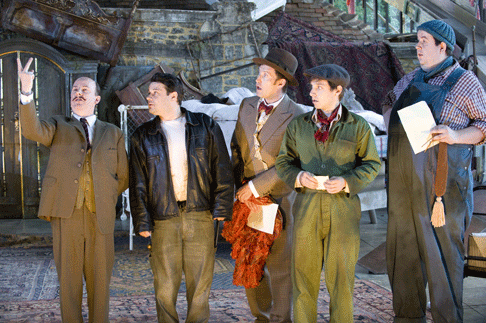
The staging was more of a problem. Boys dressed in 40’s military costumes much too large for them? Adults having sex in school uniforms ? Toys being locked away? Filthy mattresses, seedy decrepitude ? Maybe this is a dig on Britten’s sexuality, but it’s out of order and not supported either by the opera or what is known of the facts. Thankfully, it was obliterated by another big star in this production - the lighting !
Like magic, the lights wiped away the tawdry squalor. The Duke’s palace appeared, transparent glass chairs lit with twinkling silver lights. Then, when couple are reunited, and order restored, night returns, and the fairies spread their magic again, this time on us, the audience.
Thousands of golden fairy lights suddenly lit up at once, transforming the darkness closing in. Festoons of lights, twined round the topiary trees and box hedges in the parterre garden, garlanding the trees beyond. A moment to remember forever. Garsington goes out in a blaze of glory. Next year, it moves to an even bigger landscape, at Wormsley Park.
A word about the lighting design which at Garsington this year excelled all expectations. Bruno Poet, who designed the lighting for this A Midsummer Night’s Dream deserves special praise. This was very imaginative work, which larger opera companies would envy.
Poet and his team spent hours carefully working out circuitry and placements. Designing in this in a conventional setting would be hard enough, but in an open air setting, artificial lighting must cope with natural light, which lasts to 10pm at this time of year. Then there’s the added problem of Health and Safety. In ordinary theatres, the audience doesn’t walk round the wiring. In Garsington, the gardens are a feature the audience comes to see. Poet and his team managed to conceal the wiring so well that it didn’t intrude.
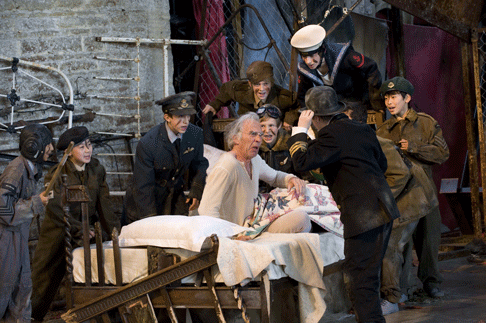
While this year’s Garsington Opera season is over, please follow http://www.garsingtonopera.org/ for information about 2011 at Wormsley Park Garsington Opera is a specialist niche company, supported entirely by sponsorship and private patronage.
Anne Ozorio
image=http://www.operatoday.com/Garsington_dream03.gif
image_description=A Midsummer Night’s Dream, Garsington Opera
product=yes
product_title=Benjamin Britten: A Midsummer Night’s Dream, Op. 64
product_by=Tytania: Rebecca Bottone; Oberon: James Laing; Lysander: Andrew Staples; Demetrius: George von Bergen; Hermia: Anna Stéphany; Helena: Katherine Manley; Bottom: Neal Davies; Quince: Jonathan Best; Flute: Pascal Charbonneau; Snug: Sion Goronwy; Snout: Mark Wilde; Starveling: Robert Gildon; Theseus: Conal Coad; Hippolyta: Patricia Orr; Puck: Richard Durden; Cobweb: Christopher O’Brien; Peaseblossom: James Dugan; Mustard Seed: Leopold Benedict; Moth: Cameron Clark; Fairies: Trinity Boys Choir. Garsington Opera Orchestra, Steuart Bedford, conductor. Director: Daniel Slater. Designer: Francis O’Connor. Lighting Designer: Brian Poet. Choreographer: Leah Hausman. Garsington Opera, Oxfordshire, England. 30 June 2010.
product_id=
July 7, 2010
Daniel Catán: An Interview by Maria Nockin
On June 26, 2010, I spoke with Daniel Catán, an American composer who writes operas with Spanish texts. He and his wife, Andrea, were at their lovely California home not too far from the College of the Canyons in Santa Clarita where he teaches. His brand new Opera, Il Postino, will receive its world premiere at Los Angeles Opera on September 23, 2010. The libretto is based on the 1994 film of the same name directed by Michael Radford. The opera was commissioned by LA Opera as a co-production with the Theater and der Wien in Vienna and the Théâtre du Châtelet in Paris.
MN: Did you grow up in a musical atmosphere?
DC: Not exactly. My parents loved music. My father loved singing in particular, but he did not expect his children to be musicians. I went to boarding school in England shortly before my fourteenth birthday. After graduation, I attended the University of Sussex where I majored in philosophy. Then, I went to the University of Southampton to study music. After that, I came to Princeton University in the US where I did my graduate work, eventually receiving a master’s degree followed by a doctorate in composition.
MN: Who were your teachers at Princeton?
DC: I studied with Milton Babbitt and two of his students, Benjamin Boretz and James K. Randall. They were very inclusive in their outlook and they worked at helping their students find their own voices. I knew from the beginning that I wanted to write opera. I always found that having a dramatic text was very inspirational for me. That really got my creative ideas flowing. I’ve composed operas and more or less stayed working at that until now, but I had to learn to use the orchestra as an operatic tool. Opera demands a different type of orchestration from an instrumental piece. In the latter type of work, the instruments are right in the forefront. When you orchestrate the accompaniment for a singer, it has to function so that the singer’s music is in the forefront.
MN: How has your music changed over the years?
DC: My music changes for practical reasons. It differs with each commission, for example. The more I work with singers and see my work staged, the more I understand that not everything that looks good on paper will work equally well on the stage. My composition has progressed based on the experiences that I have had. When my students ask my advice, I tell them to be sure to go to all the rehearsals of their works because that is a composer’s learning process. The composition is most definitely not finished just because you put a double bar on the page! You need to make changes as you see your piece evolving on the stage. One learns by experience and at this point I can anticipate certain things. You want to frame the voice in such a way that it shines. Being able to do that, again, is something that comes with experience.
MN: Where do you teach?
DC: The courses that I am currently teaching are Fundamentals of Music, Music Appreciation, Harmony and Counterpoint and Orchestration. All are at the College of the Canyons in Santa Clarita, California where they are very good to me.
MN: What is the makeup of your overall musical palette?
DC: It really depends on the piece that I am writing. In Florencia en el Amazonas, for example, I used clarinets, marimbas and harps because I was trying to invoke the fluidity of the Amazon River and the ambience of that area. Then I wrote Salsipuedes, which takes place in the Caribbean, so I used a different set of instruments and Afro-Caribbean rhythms to set that scene. There, I did not really use any upper strings; I mainly used clarinets, trumpets and percussion. Thus, the sound world of that piece is unique, in much the same way that the sound world of Florencia is. In Il Postino, I used a more Mediterranean sound because the opera takes place in Italy. Thus, I’ve constructed an orchestration that sounds more Italian and not quite as exotic. There are more strings and I’ve included an accordion in the stage banda.
MN: What aspects of composition do you find the most rewarding and the most challenging?
DC: What I like best is working out the smallest details in a turn of phrase or a harmonic twist that makes a phrase shine just so. That gives me a great deal of the pleasure of the artisan. I love that. I can spend hours on a phrase, but it’s worth it if in the end I can get it to come out just right. I think the most difficult thing is to find the right voice for each character. It would be much too easy to rewrite the music you wrote for a previous character, but no two characters are really the same. You need to have that very clear in your mind and think of each character from the ground upwards. Not to repeat myself, that’s what I find most challenging.
MN: How large an orchestra do you like to use for opera and does the size of the orchestra make a difference in getting the opera performed?
DC: That depends on the piece. Some of the works I write are intended for small orchestras and small spaces. If you have a large space, you need to fill it with an appropriate sized orchestra. But, that being said, I have been gratified to find that Florencia has been performed in both very large and very small spaces. It has been very successful in both and so has Salsipuedes. Now, with Postino, I am considering making an orchestral reduction. I did it for Rappaccini’s Daughter (La Hija de Rappaccini). I did not do it for Florencia and Salsipuedes because their orchestras were not very large to start with. They were only around forty players. Postino has, I think, sixty-five players for the Dorothy Chandler Pavilion at the Music Center in Los Angeles. Postino has a chorus, too. When I first started writing opera I tried to avoid choruses and large orchestras, but in Houston, when I did Florencia there, they said they had a chorus and they wanted me to use it. Actually, a few companies have said that to me. I like to tailor some aspects of the opera to the companies presenting them, as long as I can maintain the integrity of the work.
image=http://www.operatoday.com/DanielCatan.gif
image_description=Daniel Catán
product=yes
product_title=Daniel Catán: An Interview by Maria Nockin
product_by=Above: Daniel Catán
product_id=
Opera Bits and Pieces, Gently Scrambled
By Steve Smith [NY Times, 7 July 2010]
“Opera is, by and large, all about the world of fiction,” the conductor Bramwell Tovey announced from the podium shortly into a concert by the New York Philharmonic at Avery Fisher Hall on Tuesday evening. In part he was referring to the evening’s program, “La Dolce Vita,” a collection of popular arias and pleasant instrumental knickknacks gathered mostly from French and Italian operas.
Central City stages Butterfly with a bite
Nonetheless, you get stuck on the flypaper of Puccini’s sometimes saccharine score, tear up and go home thinking you’ve experienced Great Art. That — happily — ended locally in 2005 when veteran soprano Catherine Malfitano came to Central City to direct a Butterfly with a bite.
The production returned to the historic CCO house on Saturday, and it’s even more brilliant than it was five years ago. Malfitano has focused her experienced attention on two aspects of the opera to achieve this. She places major emphasis on the suicide of Butterfly’s father. Although details are not given, it was an act necessary to preserve his honor — and that of his family. Malfitano adds the late non-singing father to Puccini’s cast. White-clad with long beard, he disembowels himself on stage before the music begins.
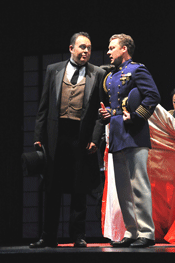 Grant Youngblood as Sharpless and Chad Shelton as Pinkerton
Grant Youngblood as Sharpless and Chad Shelton as Pinkerton
Okay, it gives things away, but everyone knows the end anyhow. The father
returns throughout the staging to underscore the inevitability of his daughters
death. This brings a depth to the score — “an inexorable feeling of
fate,” says the director — that it otherwise has never had. Malfitano’s
second stroke of genius comes with the love duet that ends Act One. It’s
powerful music that easily stands on its own; in this staging, however,
Pinkerton, the American Navy man of questionable character, and the
still-innocent Butterfly slowly undress each other. It might sound like
strip-tease, but it isn’t. It’s done with impeccable taste, mesmerizing
slowness and controlled delicacy until the two are silhouetted in embrace
against an orange moon. Like a nerve laid bare, this brings the intense sexual
undercurrent of the music to the surface, where it stays for the remainder of
the staging. Puccini has never had it so good!
To bring life to Malfitano’s ideas, the CCO has assembled an ideal cast and production team. Yunah Lee has made Butterfly her signature role around the world, and Mika Shigematsu is equally celebrated as servant-companion Suzuki. Obviously, you don’t have to be Asian to sing these roles, but it adds to illusion. (And it avoids the excesses of make-up and pathetic pussy-footing of Western singers who try thus to bring “reality” to the 1904 opera.) In addition to a powerful and expressive voice Lee identifies totally with Butterfly, and Shigematsu’s warm mezzo leaves one sitting back just to listen.
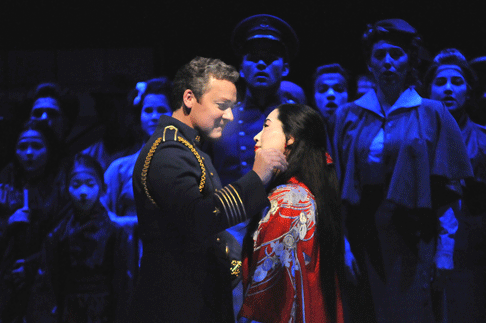 Chad Shelton as Pinkerton and Yunah Lee as Cio-Cio-San
Chad Shelton as Pinkerton and Yunah Lee as Cio-Cio-San
Chad Shelton remains a youthful tenor with a voice of power and passion that downplays the cad Pinkerton is in deserting his bride. Baritone Grant Youngblood, a CCO old-timer, plays an American consul tormented by the wrong that he must nonetheless endorse.
Dany Lyne’s designs and costumes are impressively simple, while retaining hints of the setting in Japan. Near-miraculous is the conducting of Matthew Halls, the young British master of the Baroque who came to Colorado a year ago to conduct Handel’s Rinaldo. Halls asked to be on the podium for Puccini, and one hears why. He understands both story and music and has the CCO pit band playing as if it were the Vienna Philharmonic.
Andrew Altaenbach prepared the chorus of CCO young artists that — effectively — comes to the rear of the stage in blue masks to sing the “Humming” Chorus that accompanies Butterfly’s nocturnal vigil. (Usually the chorus sings off stage.) In the orchestral interlude that follows Halls elevates Puccini to Beethoven’s level as a master of orchestral composition.
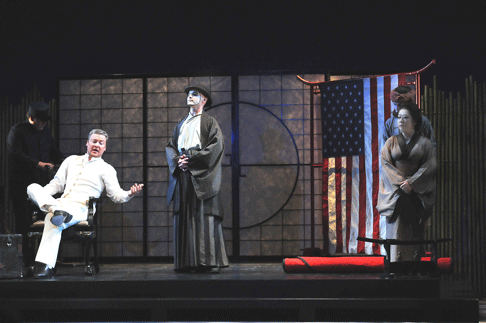 Chad Shelton as Pinkerton, Joseph Gaines as Goro and Mika Shigematsu as Suzuki
Chad Shelton as Pinkerton, Joseph Gaines as Goro and Mika Shigematsu as Suzuki
This is — in sum — is Puccini staged by a troupe of masters who bring new insight — and emotion — to the overworked score. Others exaggerate tricks and trivia to rescue Butterfly from its own popularity. Malfitano knows it’s all there in the music and stages the opera with maximum simplicity — and impact. There may never be another Butterfly like it.
Madama Butterfly plays at Central City Opera through August 9. For information, call 303-292-6700 or www.centralcityopera.org.
Wes Blomster
image=http://www.operatoday.com/CCOMadamaButterflyFlag.gif image_description=Yunah Lee (Cio-Cio-San). [Photo by Mark Kiryluk courtesy of Central City Opera] product=yes product_title=Giacomo Puccini: Madama Butterfly product_by=Butterfly: Yunah Lee; Pinkerton: Chad Shelton; Suzuki: Mika Shigamatsu; Sharpless: Grant Youngblood. Director: Catherine Malfitano. Conductor: Matthew Halls. product_id=Above: Yunah Lee as Cio-Cio-SanAll photos by Mark Kiryluk courtesy of Central City Opera
July 6, 2010
Cesare Siepi, Renowned Italian Opera Singer, Dies at 87
By Anthony Tommasini [NY Times, 6 July 2010]
Cesare Siepi, the renowned Italian bass acclaimed for his vocally suave, swashbuckling portrayal of Mozart’s Don Giovanni, died on Monday in Atlanta, where he had lived for 25 years. He was 87.
July 5, 2010
Don Giovanni, Glyndebourne, Sussex, England
By Andrew Clark [Financial Times, 5 July 2010]
It started well enough, with a deliberately unannounced blackout and - bang! - those fearsome, fateful chords calling everyone to attention. The message was clear: this performance aimed to grip its audience and not let go. Good intentions, for sure, but from that point onwards,
July 4, 2010
London’s Manon: Diva and Divo Deliver
For his world class account of the Chevalier, young Vittorio Grigolo was lavished with the sort of reception being afforded to World Cup soccer goals these days. And what’s more, he kept on scoring and scoring and scoring and scoring all night. My fine impression of Mr. Grigolo in Zurich’s Il Corsaro did not in any way prepare me for his ability to totally immerse himself in such a thrilling, impassioned performance. From his first two acts of unforced boyish, puppy dog sincerity through his maturation and final extra-musical cry of despair over his beloved’s corpse, there was no detail of the character’s conflicts that he did not beautifully, effortlessly encompass.
He also showed that his lovely lyric voice could fill a larger house like Covent Garden. While I still would hope that he carefully consider spending too much vocal capital on the bigger outbursts, there is no denying that they were exciting. Vittorio seems to have a very secure technique, good vocal health, and an uncanny sense of how to use his gifts to good musical ends. His sotto voce effects were wonderfully calibrated and had us leaning forward in our seats to catch every nuance. And he is movie star handsome, a PR director’s dream. The rowdy approval from the discerning London public is a good indicator that Mr. G’s musical future is assured. Indeed, he made a pretty damn good case for calling the piece Des Grieux.
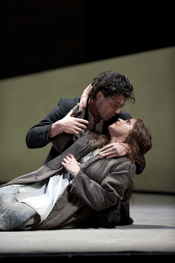 Vittorio Grigolo as Chevalier Des Grieux and Anna Netrebko as Manon Lescaut
Vittorio Grigolo as Chevalier Des Grieux and Anna Netrebko as Manon Lescaut
But it is, in fact, named for its heroine and here we were equally fortunate to have superstar Anna Netrebko as Manon. That she puts the ‘G’ in Glamor, and that her well known soprano is one of the most sleek and lustrous in the lirico-spinto Fach goes without saying. Ms. Netrebko is occasionally less acclaimed for her dramatic conviction and specificity. Not so here, for her multi-faceted embodiment of this complex woman, and the sustained arc of the character’s journey are easily the best performance I have ever experienced from Anna. And her French was notably improved (nay, ‘good’!) from the ‘Frussian’ she was intoning (albeit beautifully) on Vienna’s recent Carmen telecast.
She was utterly believable as the unforced, eager, impressionable young girl who stumbled into Act I, and she grew from that foundation with strength and conviction. Moreover, she and her leading man had an infectious chemistry that must have communicated to the last row of seats in the amphitheatre and several blocks beyond. Her singing showed off all the usual strengths: soaring top notes, even production, especially good legato, heartfelt coloring. She does miss a pitch by a hair here and there, mostly at the end of phrases in the lower middle, but this is as unpredictable and curious as it is infrequent. The celebrated exponent of the role, Beverly Sills often joked that the heroine is ‘the French Isolde.’ And so it is, requiring vocal stamina, style from girlish charm to fated desperation, and un-ebbing star quality to carry the long-ish evening. Ms. Netrebko’s fame and marketability may precede her, but she has emphatically delivered on her promise with this immensely satisfying portrayal.
Russell Braun was a vigorous, swaggering Lescaut, and although he deployed his pleasing baritone securely (and with excellent diction) I felt his hectoring might be tempered with a bit of restraint. As the Count des Grieux, Christof Fishesser had noble bearing and his rich bass made the most of every phrase. Christoph Mortagne’s Guillot was unusually fine, characterized by wit and vivacity, cleanly sung, and cliche-free. It was a pleasure to encounter the wonderful baritone William Shimmel again, this time as a solidly voiced Brétigny. I don’t always pay much attention to the trio of coquettes (who I usually find as interchangeable as the Pointer Sisters), but on this occasion we were treated to distinctive performances by Louise Innes (Rosette), and two Jette Parker Young Artists: Kai Rüütel (Rosette) and especially the very promising Simona Mihai (Pousette). These three young ladies made vibrant contributions all evening, and particularly brightened the Casino scene.
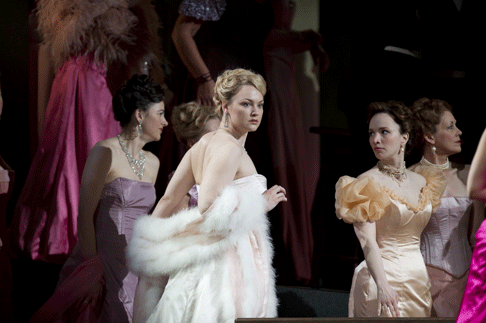 Kai Rüütel as Rosette and Simona Mihai as Poussette
Kai Rüütel as Rosette and Simona Mihai as Poussette
The gifted director Laurent Pelly deployed his usual arsenal of theatrical inventions and infused this Manon with more humor than usual,. This strategy paid off huge dividends when we got to the contrasting devastating emotional moments. Mr. Pelly is reliably a master of character development, resulting in every person on the stage (including choristers) being at all times engaged, committed to the moment, and buoyed by sub-text. His staging made excellent use of the various playing spaces, and it was executed to a fare-thee-well by the lively cast. I loved the men in tails, side-stepping across stage during the gavotte, like Fred Astaire’s group-courting their Ginger.
I was less taken with the look of the sets, although pleased overall with their functionality. Even when they seemingly doomed the action to unavoidably repetitive movement patterns, Laurent found a way to turn the limitations to an advantage. Never off-putting and well constructed, designer Chantal Thomas relied on spare-looking, angular lines for the most part. Amiens’ square was a white box of an affair with a long staircase to the top level surmounted by miniature boxy, shuttered and roofed ‘houses.’ Not much about it to convey the feel of the Belle Epoque. In fact, the look was quite at odds with the style of the aural goings-on. The director borrowed a staging trick from Birgit Nilsson who, approaching a high note that would scare normal sopranos motionless, would nail it and then run across the stage while holding it perfectly. On the last long held note of their duet, this Love Couple ran up the entire length of the stairs to escape off the upper platform, never faltering vocally. Ah, youth!
Act II was among the best overall settings of the night, with the garret perched atop a configuration of metal roofs on the stage floor, reached by an ‘L’ of a staircase broken by a landing. This was a very fine environment indeed for the plot’s requirements, which put Lescaut and the Chevalier in the room behind a closed door, with Manon and Brétigny on the lower level of the landing. Adieu, notre petite table is very effectively stage with the soprano opening the door to see the table in the far corner just as she begins, entering the room as she continues, and with meaningful moves gets back out the door to close it again with finality on ‘Adieu.’ This could be a Masters Class in staging an aria.
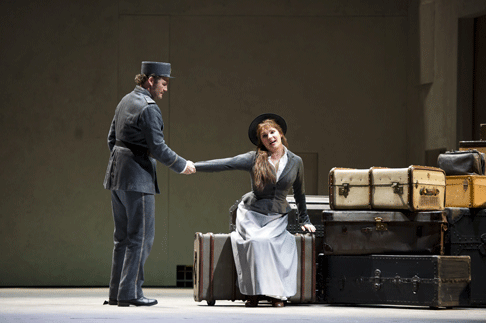 Russell Braun as Lescaut and Anna Netrebko as Manon Lescaut
Russell Braun as Lescaut and Anna Netrebko as Manon Lescaut
The cement ramps of the Cours-La-Reine scene had little visual appeal, but were redeemed by lovely globed street lights and a pastel backdrop that included a hazy tease of a Ferris wheel. The design knockout of the night was arguably Anna’s dazzling — there is no other word for it — dazzling fur-trimmed pink gown. Indeed, the colorful, eye-pleasing costumes that Mr. Pelly designed with an assist from Jean-Jacques Delmotte saved the day as far as visual delights. Lionel Hoche devised rather predictable choreography for the ballet, well-performed by eight-count-’em-eight white tu-tu’d ballerinas (ballerini?). The girls seemed to be having much more fun squealing and being pursued by the tipsy, horny revelers at scene’s end.
With the St. Sulpice scene, designer and director devised the most completely realized bit of Massenet all evening. Rows of wooden chairs find the congregation of women facing the altar off left, that is when they are not rubber-necking to catch a glimpse of that hot young Father Vittorio lurking behind them. Down right, hidden by a divider is the seminarian’s bed and simple study. By the time Manon enters in a white satin gown and methodically lures him to his fate, we are back to horizontal mode faster than you can say N’est-ce plus ma main. She lustily tears open the top of his cassock baring his torso, and the two of them fumble their way through foreplay in (*gasp*) church, before the curtain falls not a moment too soon! Not since Sherrill Milnes tore open his robe in the Met Thais have so many binocs been raised in hasty unison. If there is ever a sexier opera scene than this, it will end up on X-Tube. (The moody, apt lighting design is courtesy of Joël Adam.)
As we then see-sawed our way scenically back to the angled platforms, the skewed perspective, the flat uni-set color (this time dark green) of the Hôtel de Transylvanie with its gambling tables that rolled on and off from the wings, I wondered if I was missing some sort of intentional alternating design pattern, one all blunt angles, one more realistic. Save one fun effect of wheeling on a table with Guillot seated on the end of it, the scene was competent but colorless (always excepting the attire). This was compensated for in large measure by the final scene, a beautiful, golden-beige open space flanked by receding bannisters on either side suggesting a desolate beach or quay more than the road to Le Havre. The street lamps on stage right recall the happier events of the Cours-la-Reine. It is with this final encounter that Pelly delivers his most heartfelt work with an inevitability about the final pairing and sinking and kissing and expiring that I will number among the tenderest extended moments ever communicated on an opera stage. Goose bumps. Tears. All the buttons were pushed. Bravi, tutti.
In the pit, Antonio Pappano’s conducting at first seemed dry, with a prelude of precision but not much joy. Maestro Pappano is a no fuss, no muss guy, and after a quick acknowledgment of the audience, he plunges right into the proceedings. And I mean, right in. Maybe allowing just a moment for the orchestra to focus on his face rather than his back would prep them a bit more for the bubbling opening bars. This was quickly remedied, and in short order everything was percolating along in festive Gallic fashion, but when the same music opened Act III, there was a noticeable difference in the style and elan from this fine group of musicians. Throughout the night, Pappano displayed total command, and accommodated and supported his well-rehearsed cast of singers.
James Sohre
image=http://www.operatoday.com/MANON-BC201006160306-NETREB.gif
image_description=Anna Netrebko as Manon Lescaut [Photo by Bill Cooper courtesy of Royal Opera]
product=yes
product_title=Jules Massenet: Manon
product_by=Manon Lescaut: Anna Netrebko; Chevalier des Grieux: Vittorio Grigolo; Le Comte des Grieux: Christof Fischesser; Lescaut: Russell Braun; Guillot de Morfontaine: Christophe Mortagne; De Brétigny: William Shimell; Pousette: Simona Mihai; Javotte: Louise Innes; Rosette: Kai Rüütel; Innkeeper: Lynton Black; Two Guardsmen: Elliot Goldie, Donaldson Bell. Conductor: Antonio Pappano. Director: Laurent Pelly. Set Designs: Chantal Thomas. Costumes: Laurent Pelly, Jean-Jacques Delmotte. Lighting Design: Joël Adam. Choreography: Lionel Hoche.
product_id=Above: Anna Netrebko as Manon Lescaut
All photos by Bill Cooper courtesy of Royal Opera
July 2, 2010
Los Angeles Opera's 'Ring' ends with a deficit but potential new patrons
By Jay L. Clendenin [LA Times, 2 July 2010]
For better and for worse, the $31-million Los Angeles "Ring" turned out to be a "Ring" for Los Angeles rather than a "Ring" for the world.
Picture Perfect — Plácido Domingo as Simon Boccanegra, Royal Opera
The fans know he doesn’t need flowers. The flowers are symbols to thank Domingo for being who he is. He’s an institution, or as they say in Japan, a Living National Treasure.
Given Domingo’s hectic schedule and age, it’s a miracle that he sings at all. Yet the moment he appears, the atmosphere seems to ignite, though he shares the stage with luminaries like Ferruccio Furlanetto, Joseph Calleja and Marina Poplavskaya.
Domingo’s authority is all the more impressive because there aren’t any florid, crowd pleasing arias in the part. It’s not Boccanegra’s style. He’s a shrewd politician who lives on constant alert, surrounded by danger. Hence the austere vocal colour, cold steel and granite. Boccanegra reveals himself in declamation, not decoration, and in ensemble where he’s not exposed. Indeed the tension in Domingo’s voice at some points enhances his characterization of Boccanegra as a man ravaged by fruitless struggle.
Domingo was convincingly tender in the reconciliation scene with Amelia, but reached true heights later. His monologue “Ah! ch’io respiri l’aura beata del libero cielo!”was exceptional. Acting skills grow with experience, so even if a voice ages, a true artist like Domingo can bring out aspects in the character deeper than words alone. “Oh refrigerio!... la marina brezza!...”, he sings, as the strings oscillate eerily. Domingo at once portrays the old Doge, whose power brought no peace, and the heroic corsair he once was.
Antonio Pappano understands that this “breeze” is sinister, and that Boccanegra will soon be chilled by death. Pappano’s feel for the hidden depths in this opera manifested itself in the way he brought out the strange, wavering textures in the orchestration. Tragedy hangs on this opera like a shroud : there’s an implication that headstrong Adorno might one day end up as broken as Boccanegra. Yet Verdi writes with cool-headed stoicism. Sparse textures, solo melodies, intense restraint. In Act 3, the juxtaposition of wedding chorus and execution march is so destabilizing Verdi doesn’t need to overstate the horror.
The central relationship in Simon Boccanegra is between Boccanegra and Jacopo Fiesco. Patrician and plebian, old authority pitted against a new order. Ferruccio Furlanetto’s Fiesco is a strong counterbalance to Domingo’s Boccanegra. Furlanetto has stage presence enough not to be intimidated by Domingo’s aura. His vocal control, too, was so vigorous that he could only be faulted for sounding like a much younger man, not Amelia’s grandfather. But the plot is a means of expressing the titanic power struggle in 14th century Genoa. Much better that Furlanetto sounds forceful and potent.
When Domingo and Furlanetto sang the reconciliation, it was profound because what has gone before has been so intense, a battle between two formidable forces.
Amelia is the pivot on which the plot turns, though the love story is secondary to the hate story that pervades the background. Marina Poplavskaya sings Amelia so assertively that her Amelia is much more than a plot device. Poplavskaya captures Amelia’s charm but the firmness in the centre of her voice indicates strong personality. A girl with such genes would hardly be a cipher.
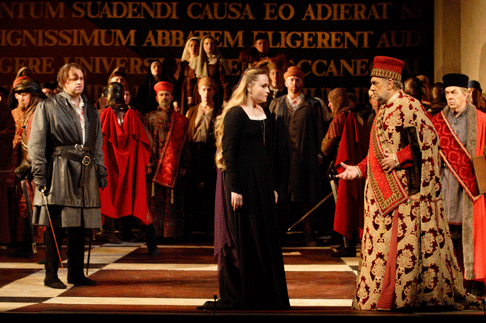 From Left To Right: Joseph Calleja as Gabriele Adorno, Marina Poplavskaya as Amelia Grimaldi, Plácido Domingo as Simon Boccanegra and Jonathan Summers as Paolo Albiani
From Left To Right: Joseph Calleja as Gabriele Adorno, Marina Poplavskaya as Amelia Grimaldi, Plácido Domingo as Simon Boccanegra and Jonathan Summers as Paolo Albiani
Joseph Calleja’s Gabriele Adorno is energetic so much the young hothead that it’s hard to imagine what he’d be when he becomes Doge. Calleja has personality in his voice, which makes it attractive.
Lukas Jakobski’s Pietro was impressive, too, since he’s still a Jette Parker Young Artist. He stands out, vocally as well as physically (he’s very tall). Jonathan Summers’s Paolo Albiani was good too.
Since this production has been revived over 100 times, it’s almost superfluous to comment, but theatre is as much part of an opera as singing. Otherwise we’d stick to concert performances.
The sets in this Simon Boccanegra, designed by Michael Yeargan are extremely beautiful, and musically intelligent, too. Chessboard marble floor — a hard foundation that adapts to changes in time and scene, like Genoa itself. It’s black and white, typically Italianate, but also evokes the black and white power struggle in the narrative. On the uprights appear words, sometimes in gold, and in Latin, like frescoes, sometimes roughly scrawled graffiti in Italian. Plebians and Patricians again. Literally, “The writing is on the wall”.
This is a very painterly production, inspired by Renaissance painting and architecture. Yet beauty alone isn’t enough on its own, as Verdi himself was to say of this opera. Fundamentally this isn’t a decorative opera, but an opera about extreme emotions, however repressed. The physical action in this production seems oddly lethargic and stilted. as if the parts are stepping out from a painting. It works, if you think of the production as a scene in a frame on a wall in a marble hall. Fortunately, the cast is so experienced that they can create their roles almost by instinct.
Domingo is a very important artist, and Simon Boccanegra is hugely significant for him. This Royal Opera House production of Simon Boccanegra will be broadcast internationally, online by BBC 2 television on Saturday 10th July at 7.30 pm London time. There will also be a BP Big Screen Live Relay on Tuesday 13th July at 7.30 pm London time at Trafalgar Square, Canary Wharf, Bradford, Bristol, Ipswich, Leicester, Manchester, Plymouth and Portsmouth. There will also be a concert performance at the BBC Proms, broadcast live, internationally, online and on demand. from 18th July.
Anne Ozorio
For more information, please see: www.roh.org.uk
image=http://www.operatoday.com/Domingo_Boccanegra_ROH_2010.gif
image_description=Plácido Domingo as Simon Boccanegra [Photo by Catherine Ashmore courtesy of The Royal Opera]
product=yes
product_title=Guiseppi Verdi: Simon Boccanegra
product_by=Paolo Albiani: Jonathan Summers; Piero: Lukas Jakobski; Simon Boccanegra: Plácido Domingo; Jacope Fiesco: Ferruccio Furlanetto; Amelia Grimaldi: Marina Poplavskaya; Gabriele Adorno: Joseph Calleja; Amelia’s maid: Louise Armit; Captain: Lee Hickenbottom. Orchestra of the Royal Opera House. Conductor: Antonio Pappano. Diuector: Elijah Moshinsky. Set Designer: Michael Yeargan. Costumes: Peter J Hall. Lighting: John Harrison. Royal Opera House, London, 29 June 2010.
product_id=Above: Plácido Domingo as Simon Boccanegra
All photos by Catherine Ashmore courtesy of The Royal Opera
July 1, 2010
Baritone Austin Kness on his way
On the subject of role preparation Austin would admit that he had not read Goethe’s Faust in preparation for his three lines as Wagner in Gounod’s opera of the same name. When not serving simply as a baritone of convenience for SFO productions he seems to be typecast — just now he sang Handsome’s few lines in Puccini’s Fanciulla del West.
Austin is in his second year as an Adler Fellow, one of ten young singers in residence at San Francisco Opera who will become the stars of tomorrow. The alumni of this finishing school are among the crème de la crème of today’s opera luminaries, like Deborah Voigt and Patricia Racette who are appearing just now with Austin in Fanciulla and Faust.
Playing an Adler Fellow is a new role for Austin, that of a little fish in the big San Francisco Opera pond. Back in Cedar Rapids (west of Chicago and east of Des Moines, for those of us who know Iowa as a state you fly over on your way to New York) Austin sang solos in church and played defensive line backer on his high school’s varsity football team.
In his last high school year he decided to take some voice lessons. His prospective teacher had but one caveat — he must agree that he would continue vocal studies as his university major. That he did in a small music department in a minor university where he became a star.
With a bachelor of music in voice in hand his career prospects were hardly defined, so he worked as a bank teller for two years before determining that he would be in fact a singer. He continued working as a teller while pursuing a master’s degree at University of Indiana, and recalls with pleasure being recognized as Don Giovanni while cashing checks.
IU is an opera factory (they say), and it is prestigious. Though, like opera schools everywhere, women outnumber men twenty to one (Austin’s calculation). So with this limited competition he immediately was thrust onto the main stage in the lead role of William Bolcom’s A View from the Bridge (a 1999 opera that made the rounds of major American opera stages). Mozart’s Count followed and finally the Olympus of baritone roles, Don Giovanni was thrust upon him.
Preparation for this role was exhaustive. He worked with IU coach Christian Capocaccia, first speaking the text, then speaking it in rhythm, singing without pitch, singing it with Mozart’s pitches, and finally putting all these pieces together. Veteran opera impresario and stage director, Tito Capobianco was there to stage the Giovanni, Austin appreciated his coaching on traditional operatic ideas of period postures and movement. In his Giovanni preparations he came across a video of the role sung by fabled bass Cesare Siepi to the Leporello of Ingvar Wixell — “those guys could sing!”
It is a big world out there, and Austin began discovering it with a summer at the American Institute of Musical Studies in Graz, Austria. While there he had remarkable revelations — the Academy’s Liederabends and the scope of opera at the Arena di Verona. He perceived as well that singers and musicians in Europe are accorded a respect unknown in the U.S.
His steps into the bigger world included a summer as a young artist at Des Moines Summer Opera where for the first time he worked alongside professional singers. The speed and ease with which these professional productions reached the stage impressed him, as did the alternative staging format of Des Moines Summer Opera (not the traditional proscenium theater). This foray into American regional opera gave Austin renewed admiration for the elevated production standard of IU opera productions.
Austin’s studies at IU have been trumped by the invitation to be an Adler Fellow at San Francisco Opera. Here too he is impressed by the professionalism of his colleagues, watching the remarkable confidence of divas Patricia Racette and Deborah Voight. He notes as well how artists with less confidence cope with the tensions of role and production preparation. There are some tricks of the trade he has gleaned — like the axiom that you try the ideas of conductors and stage directors before trying to impose your own.
Austin has enormous admiration for singers who are successful. He denies envy of tenors who for example get more applause and make more money, and says he sings falsetto only come scritto and that he never imitates sopranos just for the fun of it. He does admit resenting the fact that sopranos and tenors always seem to be the competition winners.
The Adler Fellows do offer opportunities for stardom. Austin is the Impresario in Mozart’s tiny comedy that has made the rounds of impromptu venues in the Bay Area. Austin can be funny, very funny indeed in his dealings with two Adler Fellow mini divas. He says this role was greatly expanding because it is mostly speaking, a medium completely new for this young opera singer (even though back in high school Austin wanted nothing more than to be a musical comedy star).
In this first blush of artistic maturity Austin has his eye on roles like Gounod’s Valentin, Rossini’s Figaro, and the early Verdi bel canto roles. His dream is to sing Onegin. Nothing yet is in the bag, and it is still a bit premature to sign on with artist management. In the meantime he is working hard on his Russian with SFO Opera Center coaches, and learning from every minute of his life as a young singer at San Francisco Opera.
image=http://www.operatoday.com/Kness.gif
image_description=Austin Kness
product=yes
product_title=Baritone Austin Kness on his way
product_by=An interview by Michael Milenski
The 'Other Bartoli'
By Carlo Vitali [MusicalAmerica.com, 1 July 2010]
BOLOGNA -- At age 12 she wanted to play the cello, but there wasn’t one at home -- just a piano, so she studied that instead. Now she is in her early 30s and finally fulfilling her girlhood dreams, studying viola da gamba at the Venice Conservatory.